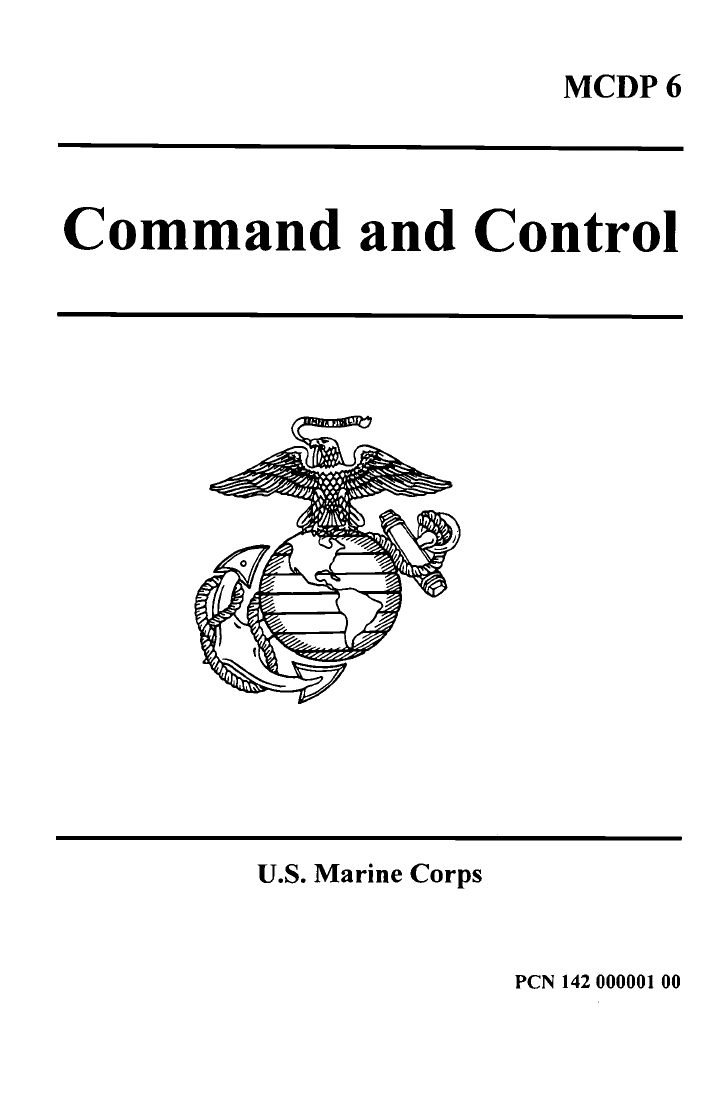
DISTRIBUTION STATEMENT A:Approved for public release; distribution is unlimited
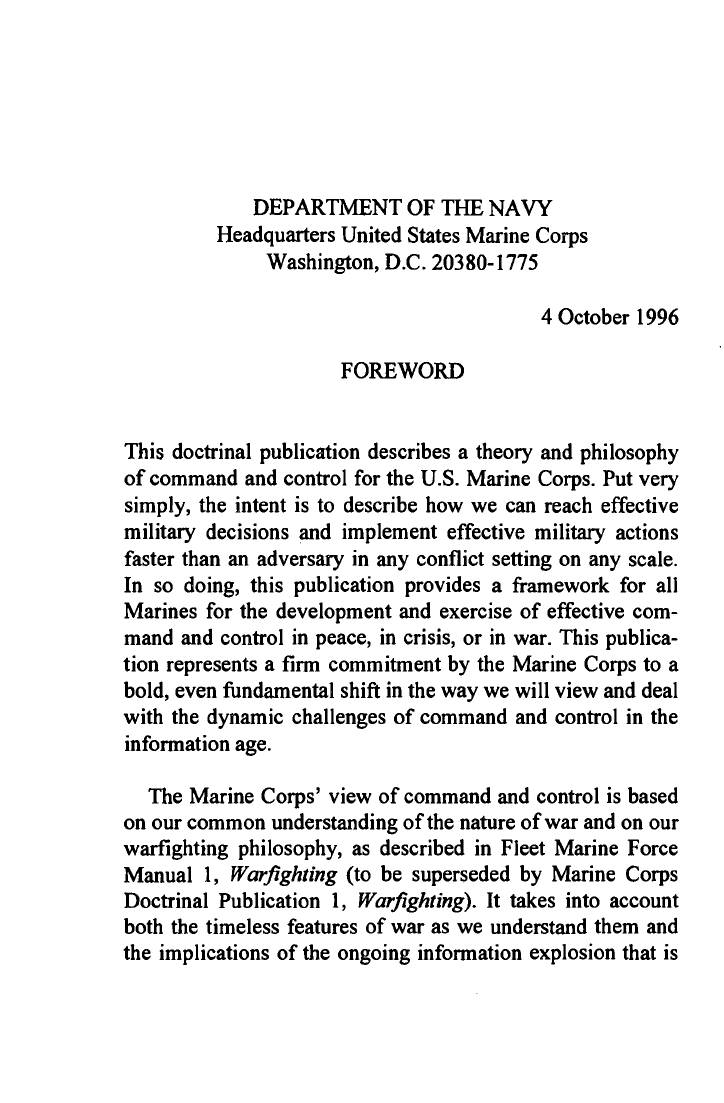
DEPARTMENT OF THE NAVY
Headquarters United States Marine Corps
Washington, D.C. 20380-1775
4 October 1996
FOREWORD
This doctrinal publication describes a theory and philosophy
of command and control for the U.S. Marine Corps. Put very
simply, the intent is to describe how we can reach effective
military decisions and implement effective military actions
faster than an adversary in any conflict setting on any scale.
In so doing, this publication provides a framework for all
Marines for the development and exercise of effective com-
mand and control in peace, in crisis, or in war. This publica-
tion represents a finn commitment by the Marine Corps to a
bold, even fundamental shift in the way we will view and deal
with the dynamic challenges of command and control in the
information age.
The Marine Corps' view of command and control is based
on our common understanding of the nature of war and on our
warfighting philosophy, as described in Fleet Marine Force
Manual 1, Warfighting (to be superseded by Marine Corps
Doctrinal Publication 1, Warfighting). It takes into account
both the timeless features of war as we understand them and
the implications of the ongoing information explosion that is

a consequence of modern technology. Since war is fundamen-
tally a clash between independent, hostile wills, our doctrine
for command and control accounts for animate enemies ac-
tively interfering with our plans and actions to further their
own aims. Since we recognize the turbulent nature of war, our
doctrine provides for fast, flexible, and decisive action in a
complex environment characterized by friction, uncertainty,
fluidity, and rapid change. Since we recognize that equipment
is but a means to an end and not the end itself, our doctrine is
independent of any particular technology. Taking a broad
view that accounts first for the human factors central in war,
this doctrine provides a proper framework for designing, ap-
praising, and deploying hardware as well as other components
of command and control support.
This doctrinal publication applies across the full range of
militaiy actions from humanitarian assistance on one extreme
to general war on the other. It applies equally to small-unit
leaders and senior commanders. Moreover, since any activity
not directly a part of warfighting is part of the preparation for
war, this doctrinal publication is meant to apply also to the
conduct of peacetime activities in garrison as well as in the
field.
This publication provides the authority for the subsequent
development of command and control doctrine, education,
training, equipment, facilities, procedures, and organization.
This doctrinal publication provides no specific techniques or
procedures for command and control; rather,
it provides

broad guidance which requires judgment in application. Other
publications in the command and control series will provide
specific tactics, techniques, and procedures for performing
various tasks. MCDP 5,
Planning, discusses
the planning side
of command and control more specifically.
"Operation VERBAL IMAGE," the short sto!y with which
this publication begins, offers a word pictUre of command and
control in action (done well and done poorly) and illustrates
various key points that appear in the text. It can be read sepa-
rately or in conjunction with the rest of the text. Chapter 1
works from the assumption that, in order to develop an effec-
tive philosophy of command and control, we must first come
to a realistic appreciation for the nature of the process and its
related problems and opportunities. Based on this understand-
ing, chapter 2 discusses theories of command and control,
looking at the subject from various aspects, such as leader-
ship, information management, and decisionmaking. Building
on the conclusions of the preceding chapters, chapter 3 de-
scribes the basic features of the Marine Corps' approach to
command and control.
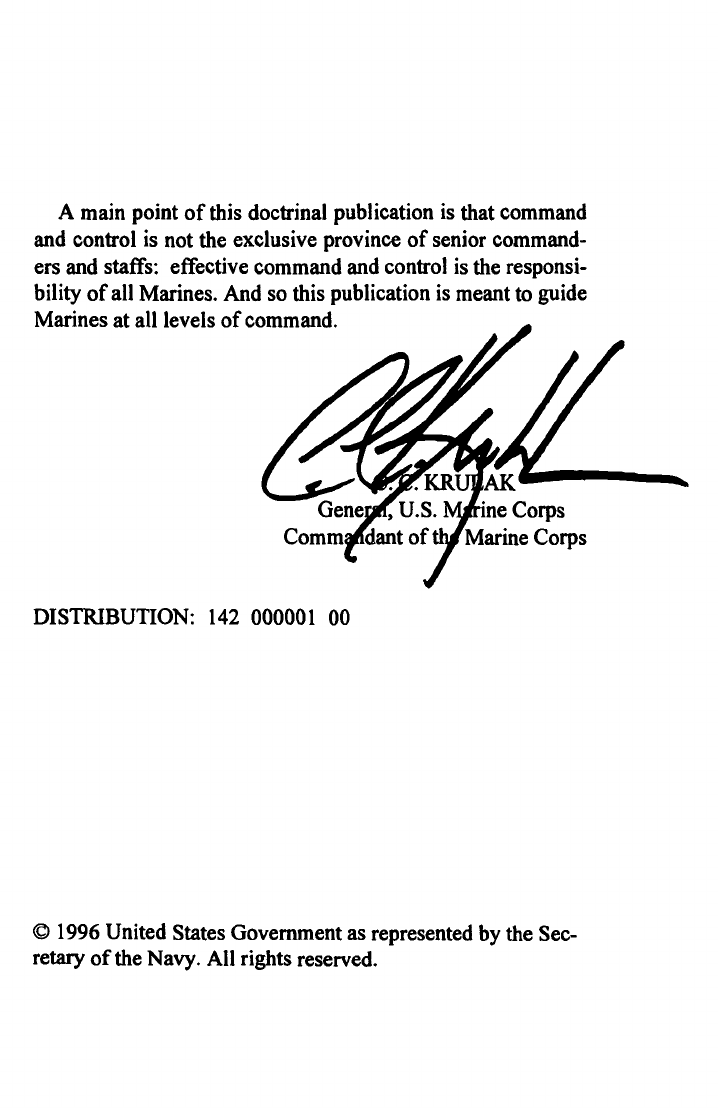
A main point of this doctrinal publication is that command
and control is not the exclusive province of senior command-
ers and staffs: effective command and control is the responsi-
bility of all Marines. And so this publication is meant to guide
Marines at all levels of command.
DISTRIBU11ON: 142 000001 00
© 1996 United States Government as represented by the Sec-
retary of the Navy. All rights reserved.
Corps
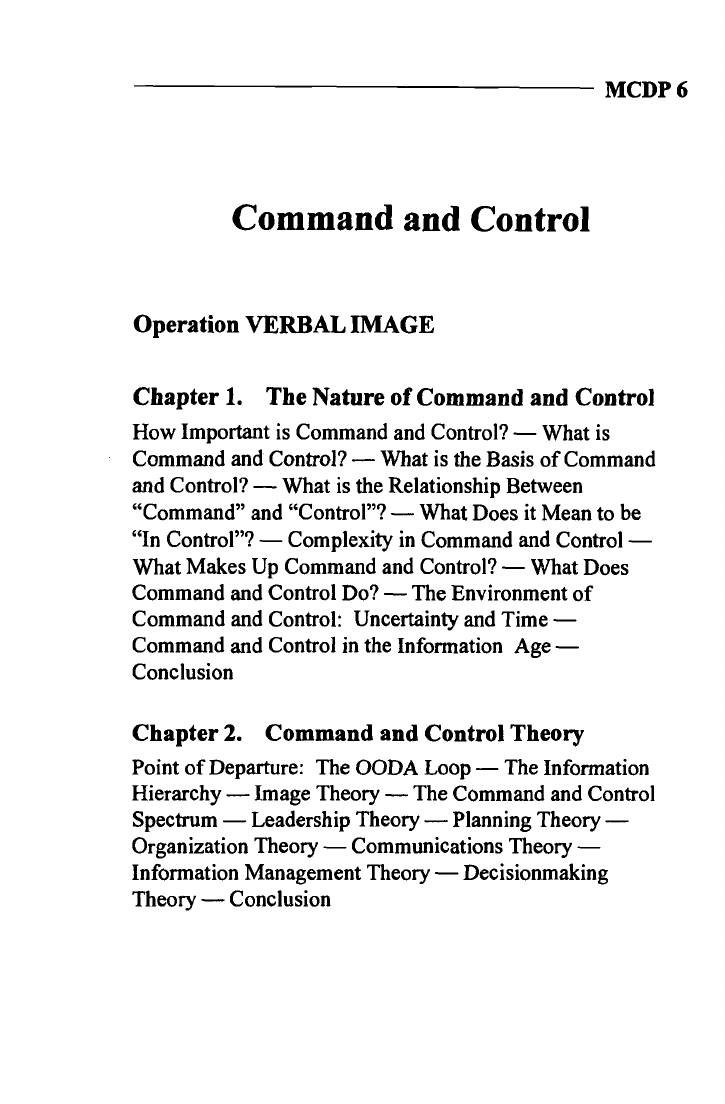
MCDP 6
Command and Control
Operation VERBAL
IMAGE
Chapter 1.
The Nature of Command and Control
How Important is Command and Control? —
What is
Command and Control? —
What is the Basis of Command
and Control? — What
is the Relationship Between
"Command" and "Control"? —
What Does it Mean to be
"In Control"? — Complexity
in Command and Control —
What Makes Up Command and Control? — What
Does
Command and Control Do? —
The
Environment of
Command and Control: Uncertainty and Time —
Command and Control in the Information Age —
Conclusion
Chapter 2. Command and Control Theory
Point of Departure: The OODA Loop —
The
Information
Hierarchy — Image Theory — The Command and Control
Spectrum —
Leadership Theory — Planning
Theory —
Organization Theory — Communications Theory —
Information
Management Theory — Decisiomnaking
Theory — Conclusion
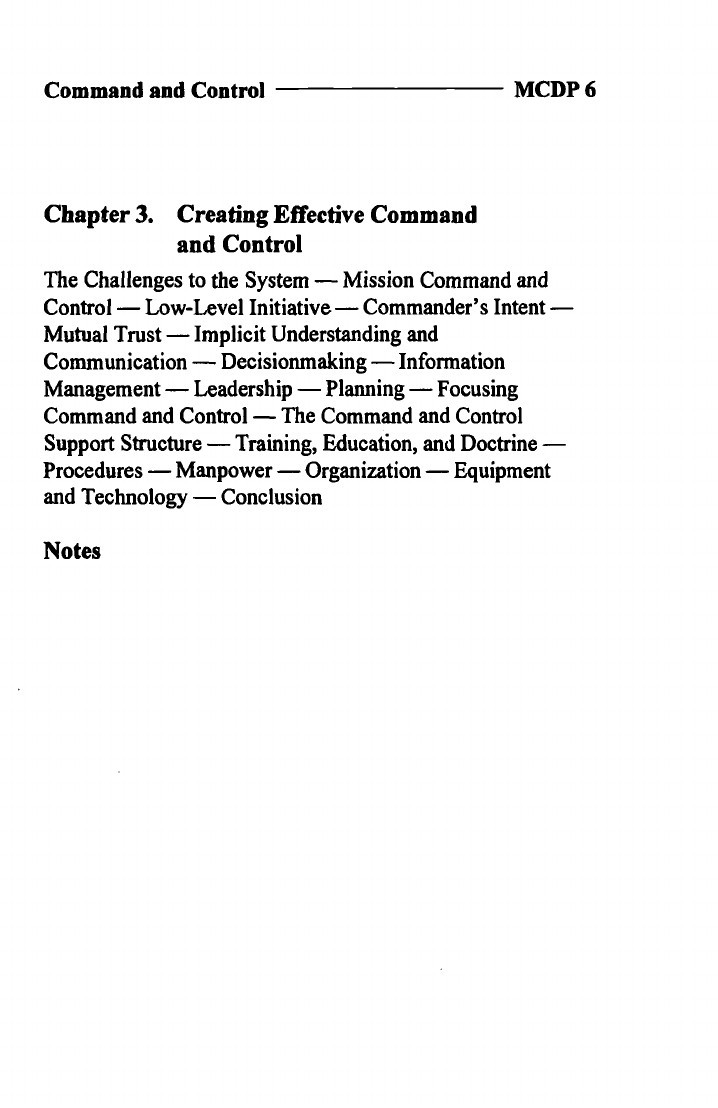
Command and Control
MCDP 6
Chapter 3.
Creating Effective Command
and Control
The Challenges to the System — Mission Command and
Control — Low-Level Initiative — Commander's Intent —
Mutual
Trust — Implicit Understanding and
Communication — Decisionmaking — Information
Management —
Leadership — Planning
— Focusing
Command and Control —
The Command and Control
Support Structure — Training, Education, and Doctrine —
Procedures
—
Manpower — Organization
— Equipment
and Technology — Conclusion
Notes

MCDP 6
Operation VERBAL IMAGE
Operation VERBAL IMAGE
Scene: A troubled corner of the globe, sometime in the near
future. The Marine expeditionary force prepares for an up-
coming offensive.
2248 Monday: Maj John Gustafson had taken over as the
regimental intelligence officer just in time for Operation
VERBAL IMAGE. Who thinks up the names for these opera-
tions anyway? he wondered. This would be his first command
briefing and he wanted to make a good impression. The colo-
nel had a
reputation
for
being a tough, no-nonsense
boss—and the best regimental commander in the division.
Gustafson would be thorough and by-the-numbers. He would
have all the pertinent reports on hand, pages of printouts con-
taining any piece of data the regimental commander could
possibly want. He went over his briefing in his mind as he
walked with his stack of reports through the driving rain to
the command tent.

Command and Control
MCDP 6
The colonel arrived, just back from visiting his forward
battalions and soaking wet, and said, "All right, let's get
started. S-2, you're up."
Gustafson cleared his throat and began. He had barely got-
ten through the expected precipitation when the colonel held
up his hand as a signal to stop. Gustafson noticed the other
staff officers smiling knowingly.
"Listen, S-2," the colonel said, "I don't care about how
many inches of rainfall to expect. I don't care about the per-
centage of lunar illumination. I don't want lots of facts and
figures. Number one, I don't have time, and number two, they
don't do me any good. What I need is to know what it all
means. Can the Cobras fly in this stuff or not? Will my tanks
get bogged down in this mud? Don't read me lists of enemy
spottings; tell me what the enemy's up to. Get inside his head.
You don't have to impress me with how much data you can
collect; I know you're a smart guy, S-2. But I don't deal in
data; I deal in pictures. Paint me a picture, got it?"
"Don't worry about it, major," the regimental executive of-
ficer said later, clapping a hand on Gustafson's shoulder.
"We've all been through it."
0615 Tuesday: The operation was getting underway. In his
battalion command post, LtCol Dan Hewson observed with
satisfaction as his units moved out toward their appointed ob-
jectives. He watched the progress on the computer screen be-
fore him. Depicted on the 19-inch flat screen was a color map
of the battalion zone of action. The map was covered with
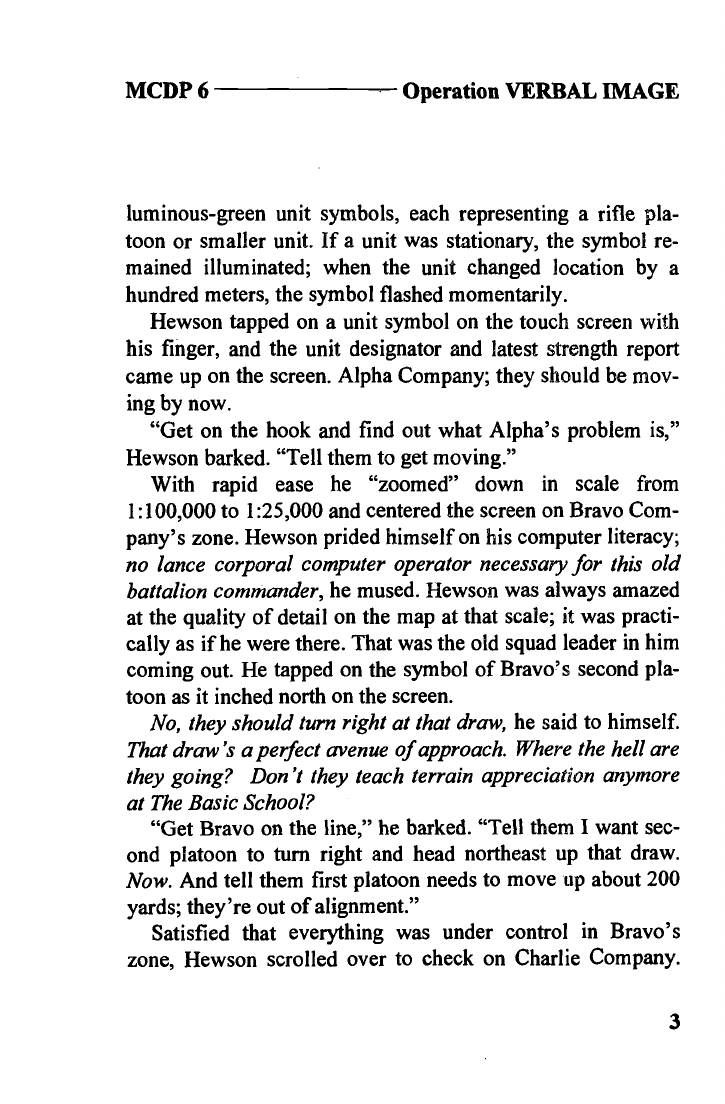
MCDP 6
Operation VERBAL IMAGE
luminous-green unit symbols, each representing a rifle pla-
toon or smaller unit. If a unit was stationary, the symbol re-
mained illuminated; when the unit changed location by a
hundred meters, the symbol flashed momentarily.
Hewson tapped on a unit symbol on the touch screen with
his finger, and the unit designator and latest strength report
came up on the screen. Alpha Company; they should be mov-
ing by now.
"Get on the hook and find out what Alpha's problem is,"
Hewson barked. "Tell them to get moving."
With rapid ease he "zoomed" down in
scale from
1:100,000 to 1:25,000 and centered the screen on Bravo Com-
pany's zone. Hewson prided himself on his computer literacy;
no lance corporal computer operator necessary for this old
battalion commander, he mused. Hewson was always amazed
at the quality of detail on the map at that scale; it was practi-
cally as if he were there. That was the old squad leader in him
coming out. He tapped on the symbol of Bravo's second pla-
toon as it inched north on the screen.
No, they should turn right at that draw, he said to himself.
That draw's a perfect avenue of approach. Where the hell are
they going? Don 't they teach terrain appreciation anymore
at The Basic School?
"Get Bravo on the line," he barked. "Tell them I want sec-
ond platoon to turn right and head northeast up that draw.
Now. And tell them first platoon needs to move up about 200
yards; they're out of alignment."
Satisfied that everything was under control in Bravo's
zone, Hewson scrolled over to check on Charlie Company.

Command and Control
MCDP 6
Back when he was a young corporal, some 22 years ago, this
technology didn't exist. It was amazing how much easier
command and control was today compared to his old squad
leader days, how much more control there was now. He won-
dered if the junior Marines realized just how lucky they were.
0622 Tuesday: Second Lieutenant Rick Connors was feeling
anything but lucky. Justpast the mouth of a draw, he angrily
signaled for second platoon to halt. Company was on the ra-
dio, barking about something. He was wet, he was cold; his
rain top had somehow sprung a leak, and a stream of icy wa-
ter poured down his spine. And on top of everything else,
now this.
"Come again?" he said to his radio operator.
"Sir, Hotel-3-Mike says we're supposed to turn right and
head up this draw," LCp1 Baker repeated.
Damn PLRS, Connors cursed to himself. He had never ac-
tually seen a PLRS, that venerable piece of equipment having
been replaced by a newer, lighter generation of position-
locating system which attached to any field radio and sent an
updated position report every time the transmit button was
cued. But like all the more experienced Marines, he insisted
on calling the new equipment by the old name.
"Up that draw," Connors repeated, as if to convince him-
self he had heard correctly.
"Hotel-3-Mike says it's an excellent avenue of approach,
sir," Baker reported dutifully.
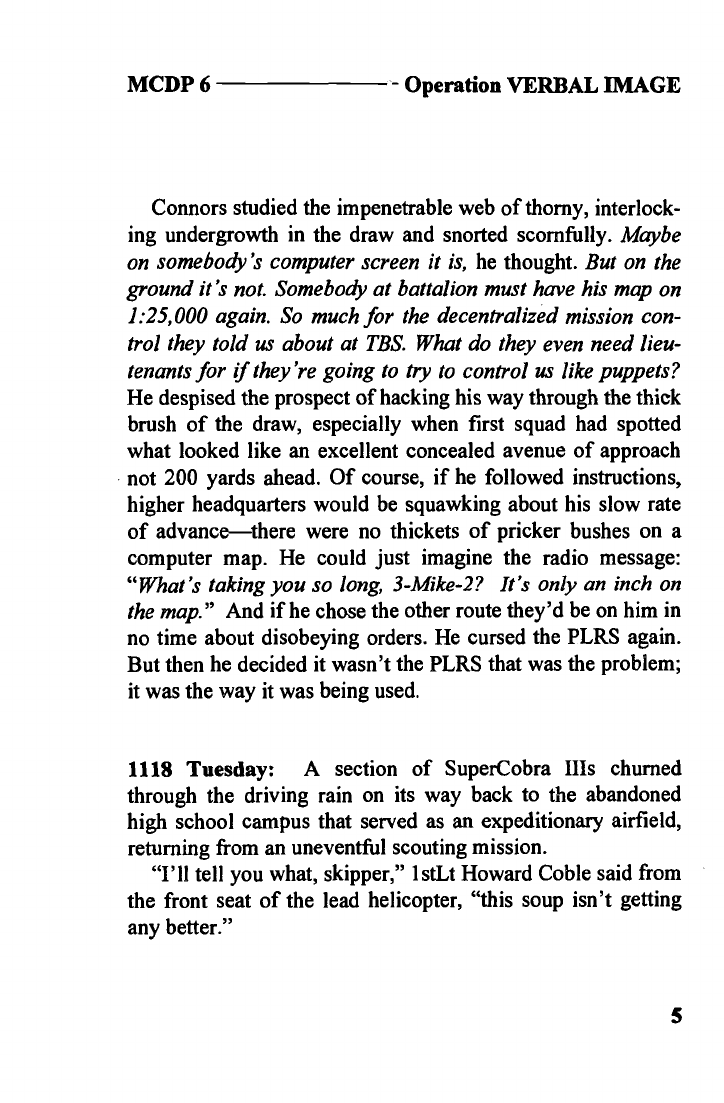
MCDP 6
- Operation VERBAL IMAGE
Connors studied the impenetrable web of thorny, interlock-
ing undergrowth in the draw and snorted scornfully. Maybe
on somebody's computer screen it is, he
thought. But on the
ground it's not. Somebody at battalion must have his map on
1:25,000 again. So much for the decentralized mission con-
trol they told us about at TBS. What do they even need lieu-
tenants for f they're going to try to control us like puppets?
He
despised the prospect of hacking his way through the thick
brush of the draw, especially when first squad had spotted
what looked like an excellent concealed avenue of approach
not 200 yards ahead. Of course, if he followed Instructions,
higher headquarters would be squawking about his slow rate
of advance—there were no thickets of pricker bushes on a
computer map. He could just imagine the radio message:
"What's
taking you so long, 3-Mike-2?
It's
only an inch on
the map." And
if he chose the other route they'd be on him in
no time about disobeying orders. He cursed the PLRS again.
But then he decided it wasn't the PLRS that was the problem;
it was the way it was being used.
1118 Tuesday:
A section of SuperCobra Ills churned
through the driving rain on its way back to the abandoned
high school campus that served as an expeditionary airfield,
returning from an uneventful scouting mission.
"I'll tell you what, skipper," 1 stLt Howard Coble said from
the front seat of the lead helicopter, "this soup isn't getting
any better."
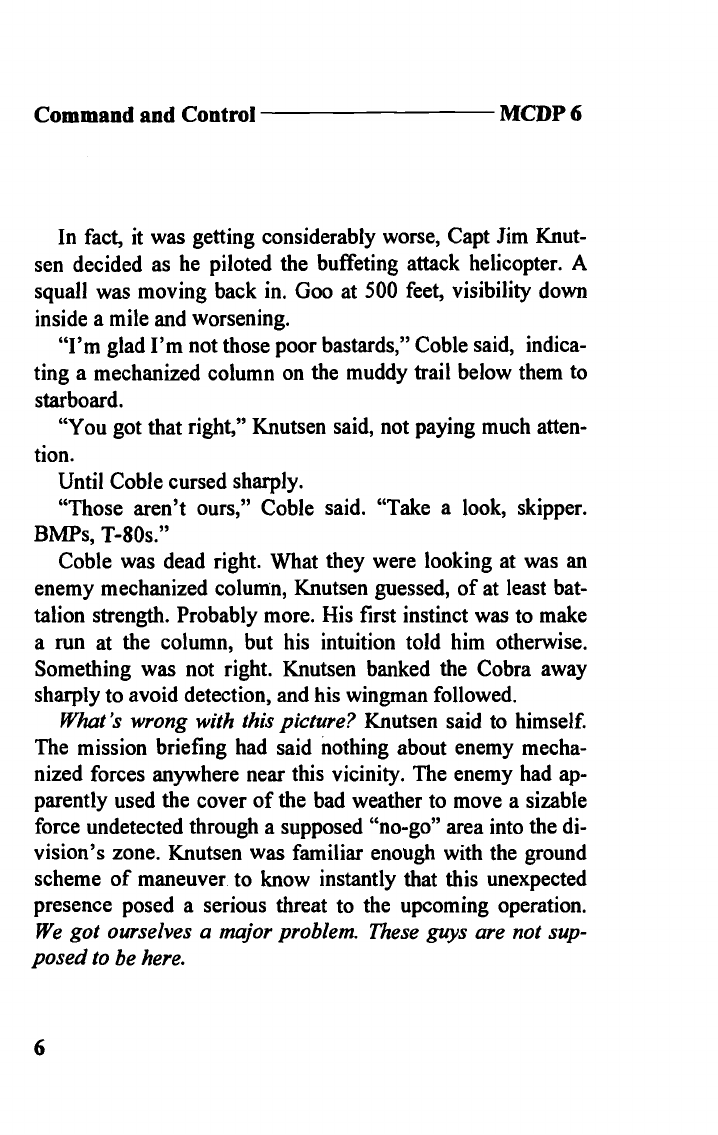
Command and Control
MCDP 6
In fact, it was getting considerably worse, Capt Jim Knut-
sen decided as he piloted the buffeting attack helicopter. A
squall was moving back in. Goo at 500 feet, visibility down
inside a mile and worsening.
"I'm glad I'm not those poor bastards," Coble said, indica-
ting a mechanized column on the muddy trail below them to
starboard.
"You got that right," Knutsen said, not paying much atten-
tion.
Until Coble cursed sharply.
"Those aren't ours," Coble said. "Take a look, skipper.
BMPs, T-80s."
Coble was dead right. What they were looking at was an
enemy mechanized column, Knutsen guessed, of at least bat-
talion strength. Probably more. His first instinct was to make
a run at the column, but his intuition told him otherwise.
Something was not right. Knutsen banked the Cobra away
sharply to avoid detection, and his wingman followed.
What's wrong with this picture? Knutsen said to himself.
The mission briefing had said nothing about enemy mecha-
nized forces anywhere near this vicinity. The enemy had ap-
parently used the cover of the bad weather to move a sizable
force undetected through a supposed "no-go" area into the di-
vision's zone. Knutsen was familiar enough with the ground
scheme of maneuver to know instantly that this unexpected
presence posed a serious threat to the upcoming operation.
We got ourselves a major problem. These guys are not sup-
posed to be here.

MCDP 6 Operation VERBAL IMAGE
His wingman's voice crackled over the radio: "Pikeman,
did you see what I just saw at two o'clock?"
"Roger, Sylvester."
"We need to let DASC know about this," Coble said on the
intercom.
Knutsen considered the problem. Reporting the sighting to
the direct air support center would, of course, be the standard
course. But because of the weather, they'd had trouble talking
to the DASC all day; they couldn't get high enough to get a
straight shot. In these conditions, he figured they were nearly
a half hour from the field. And when he finally got the mes-
sage through, he could imagine the path the information
would take from the DASC before it reached the units at the
front—and that was provided they even believed such an un-
likely report. DASC hell, we need to tell the guys on the
ground, he thought. They might like to know about an enemy
mech column driving straight through the middle of the
MEF's zone. Forget normal channels. Unfortunately he had
no call signs or frequencies for any of the local ground units.
"Howie, find me some friendlies on the ground," he said.
He radioed his wingman with his plan.
"Got somebody, skipper," Coble said shortly. "AAV in the
tree line at nine o'clock. Got it?"
"Roger, I'm setting down."
1132 Tuesday:
You got to be crazy to be flying in this
weather, Capt Ed Takashima said to himself when he heard
the sound of approaching helicopter rotors. He was twice
7
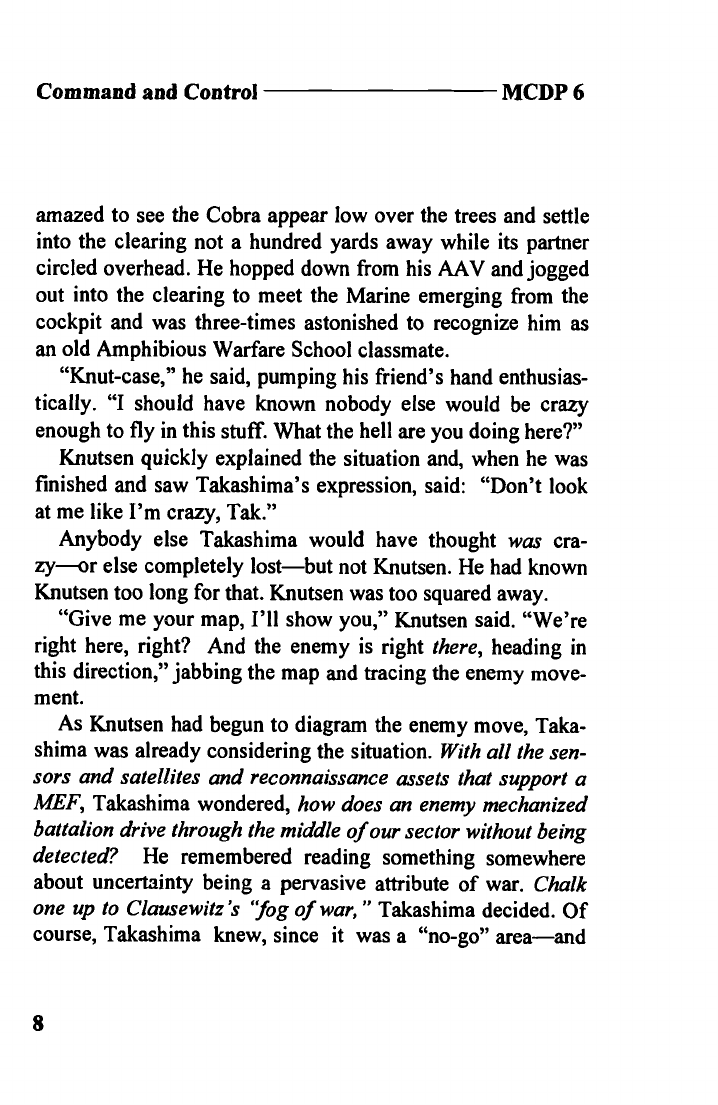
Command and Control
MCDP 6
amazed to see the Cobra appear low over the trees and settle
into the clearing not a hundred yards away while its partner
circled overhead. He hopped down from his AAV and jogged
out into the clearing to meet the Marine emerging from the
cockpit and was three-times astonished to recognize him as
an old Amphibious Warfare School classmate.
"Knut-case," he said, pumping his friend's hand enthusias-
tically. "I should have known nobody else would be crazy
enough to fly in this stuff. What the hell are you doing here?"
Knutsen quickly explained the situation and, when he was
finished and saw Takashima's expression, said: "Don't look
at me like I'm crazy, Tak."
Anybody else Takashima would have thought was cra-
zy—or else completely lost—but not Knutsen. He had known
Knutsen too long for that. Knutsen was too squared away.
"Give me your map, I'll show you," Knutsen said. "We're
right here, right? And the enemy is right there, heading in
this direction," jabbing the map and tracing the enemy move-
ment.
As Knutsen had begun to diagram the enemy move, Taka-
shima was already considering the situation. With all the sen-
sors and satellites and reconnaissance assets that support a
MEF, Takashima wondered, how does an enemy mechanized
battalion drive through the middle of our sector without being
detected?
He remembered reading something somewhere
about uncertainty being a pervasive attribute of war. Chalk
one up to Clausewitz 's 'fog of war," Takashima decided. Of
course, Takashima knew, since it was a "no-go" area—and

MCDP 6
Operation VERBAL IMAGE
that meant that somebody up the chain had looked at the ter-
rain and decided it was impassable—it would remain rela-
tively unobserved. But how it had happened didn't matter:
it
had happened. What to do about it? That was the problem.
Six or seven clicks, tops, he thought, looking at the map. Not
much time. This changed everything. The original battalion
plan would have to be scrapped; it was as simple as that.
Takashima recognized that his original mission was over-
come by events. He made his decision. The situation called
for quick thinking, and quicker action. The objectives might
change, but the overall aim remained the same. The ultimate
object, Takashima knew, was to locate the main enemy fotce
and attack to, destroy it. That could still be the object; it wiId
just have to happen a lot farther south than had been plan4ed.
If the battalion could make a 90-degree left turn in time, hey
might just pull it off. Now if he could just get battalion t? go
along with it . . . . he needed to talk to the battlion cpm-
mander.
Knutsen had finished tracing the enemy movement, and his
finger rested on the map, pointing at a small town called Cul-
verin Crossroads.
"That's it then," Takashima said. "Culverin Crossroads."
"I hear you, Tak," Knutsen said. "You're thinkng of that
West Africa map ex we did last year at AWS, aren't you?
The one where we wheeled the whole regiment and took the
red force in the flank."
"Yeah, that's the one," Takashima said.
9
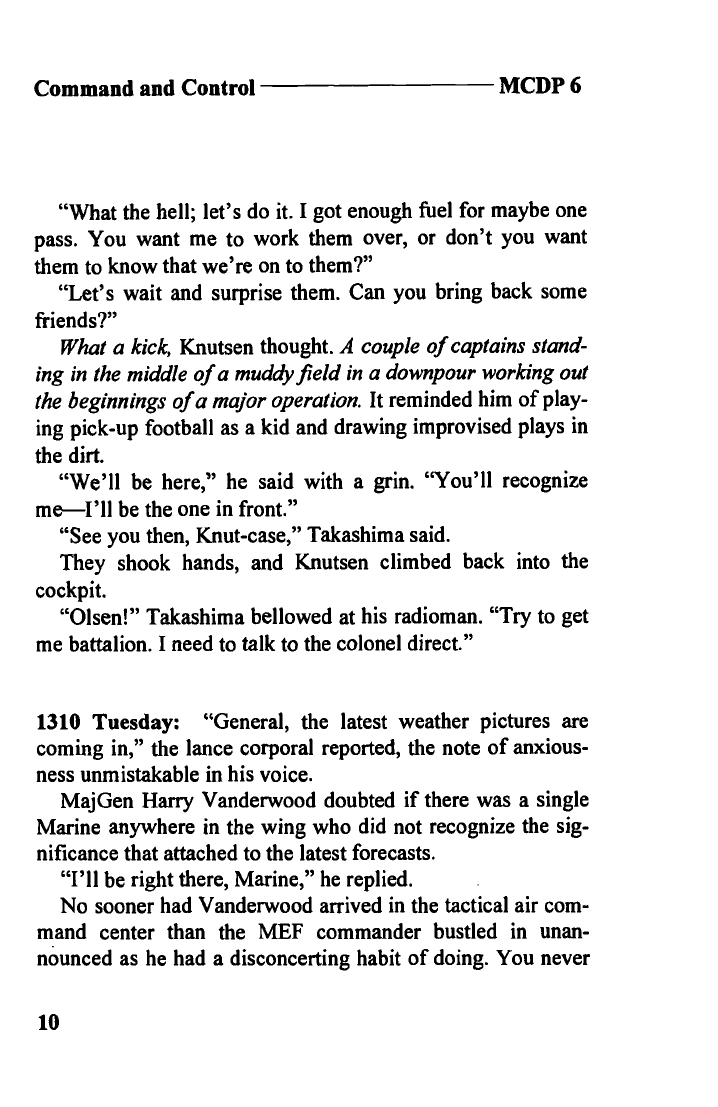
Command and Control
MCDP 6
"What
the
hell; let's do it. I got enough fuel for maybe one
pass. You want me to work them over, or don't you want
them to know that we're on to them?"
"Let's wait and surprise them. Can you bring back some
friends?"
What a kick, Knutsen thought. A couple of captains stand-
ing in the middle of a muddy field in a downpour working out
the beginnings of a major operation. It reminded him of play-
ing pick-up football as a kid and drawing improvised plays in
the dirt.
"We'll be here," he said with a grin. "You'll recognize
me—I'll be the one in front."
"See you then, K.nut-case," Takashima said.
They shook hands, and Knutsen climbed back into the
cockpit.
"Olsen!" Takashima bellowed at his radioman. "Try to get
me battalion. 1 need to talk to the colonel direct."
1310 Tuesday:
"General, the latest weather pictures are
coming in," the lance corporal reported, the note of anxious-
ness unmistakable in his voice.
MajGen Harry Vanderwood doubted if there was a single
Marine anywhere in the wing who did not recognize the sig-
nificance that attached to the latest forecasts.
"I'll be right there, Marine," he replied.
No sooner had Vanderwood arrived in the tactical air corn-
mand center than the MEF commander bustled in unan-
nounced as he had a disconcerting habit of doing. You never
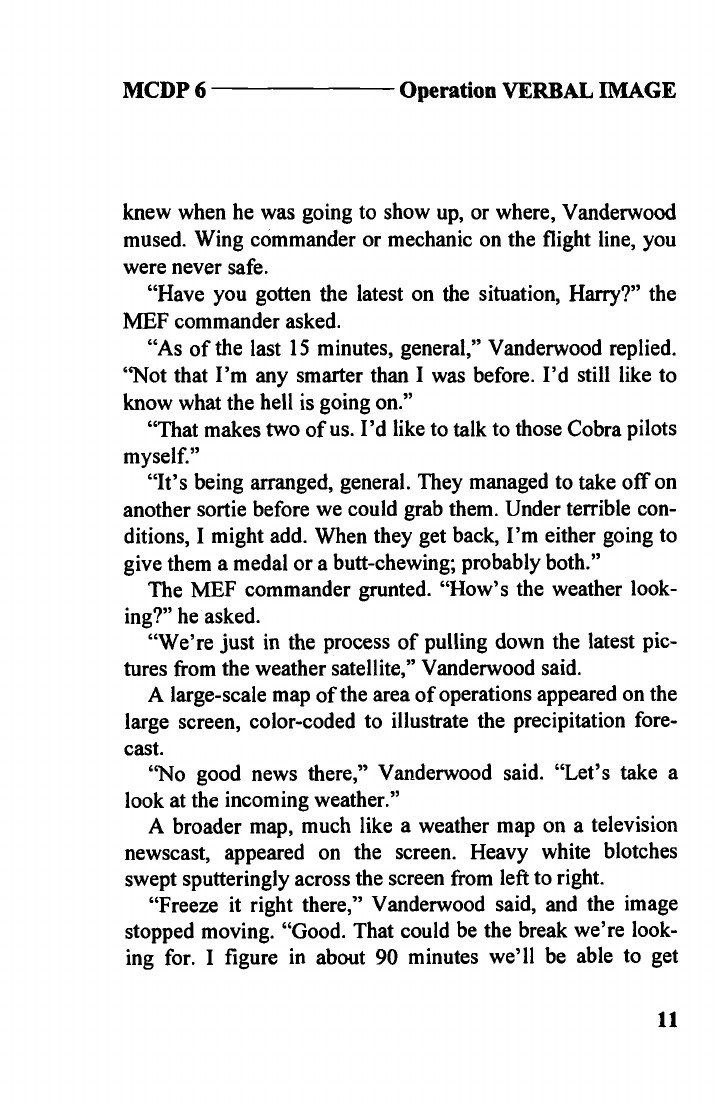
MCDP 6
Operation VERBAL IMAGE
knew when he was going to show up, or where, Vanderwood
mused. Wing commander or mechanic on the flight line, you
were never safe.
"Have you gotten the latest on the situation, Harry?" the
MEF commander asked.
"As of the last 15 minutes, general," Vanderwood replied.
"Not that I'm any smarter than I was before. I'd still like to
know what the hell is going on."
"That makes two of us. I'd like to talk to those Cobra pilots
myself."
"It's being arranged, general. They managed to take off on
another sortie before we could grab them. Under terrible con-
ditions, I might add. When they get back, I'm either going to
give them a medal or a butt-chewing; probably both."
The MEF
commander
grunted. "How's the weather look-
ing?" he asked.
"We're just in the process of pulling down the latest pic-
tures from the weather satellite," Vanderwood said.
A large-scale map of the area of operations appeared on the
large screen, color-coded to illustrate the precipitation fore-
cast.
"No good news there," Vanderwood said. "Let's take a
look at the incoming weather."
A broader map, much like a weather map on a television
newscast, appeared on the screen. Heavy white blotches
swept sputteringly across the screen from left to right.
"Freeze it right there," Vanderwood said, and the image
stopped moving. "Good. That could be the break we're look-
ing for. I figure in about 90 minutes we'll be able to get
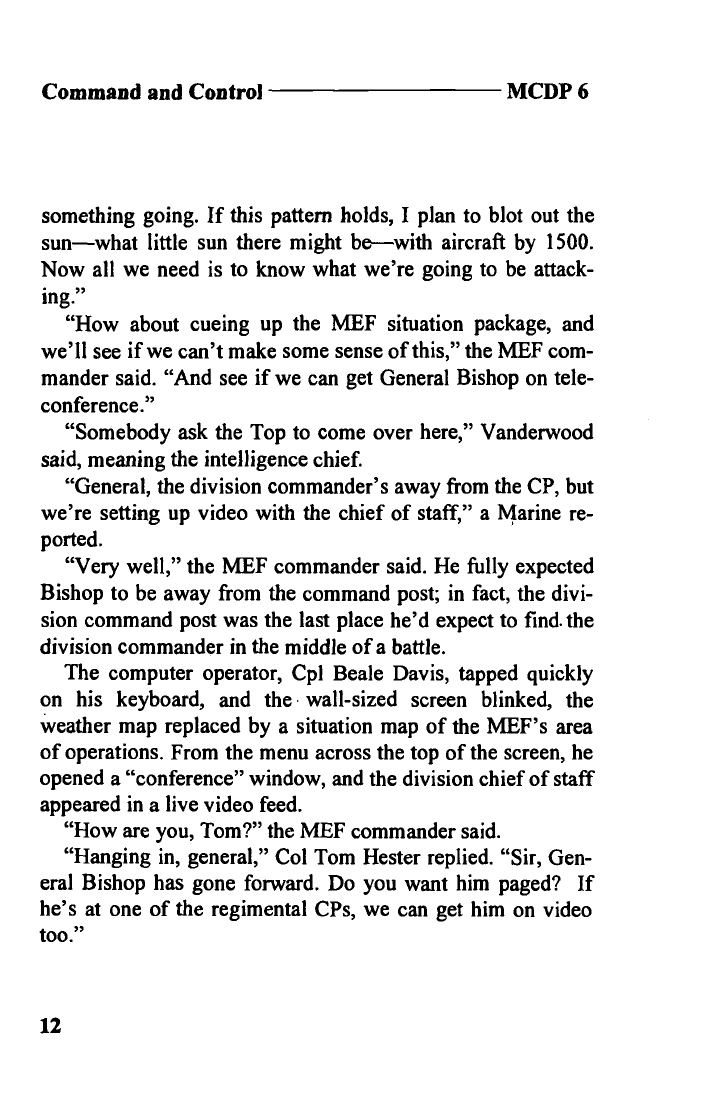
Command and Control
MCDP 6
something going. If this pattern holds, I plan to blot out the
sun—what little sun there might be—with aircraft by 1500.
Now all we need is to know what we're going to be attack-
ing."
"How about cueing up the MEF situation package, and
we'll see if we can't make some sense of this," the MEF com-
mander said. "And see if we can get General Bishop on tele-
conference."
"Somebody ask the Top to come over here," Vanderwood
said, meaning the intelligence chief.
"General, the division commander's away from the CP, but
we're setting up video with the chief of staff," a Marine re-
ported.
"Very well," the MEF commander said. He fully expected
Bishop to be away from the command post; in fact, the divi-
sion command post was the last place he'd expect to find, the
division commander in the middle of a battle.
The computer operator, Cpl Beale Davis, tapped quickly
on his keyboard, and the wall-sized screen blinked, the
weather map replaced by a situation map of the MEF's area
of operations. From the menu across the top of the screen, he
opened a "conference" window, and the division chief of staff
appeared in a live video feed.
"How are you, Tom?" the MEF commander said.
"Hanging in, general," Col Tom Hester replied. "Sir, Gen-
eral Bishop has gone forward. Do you want him paged? If
he's at one of the regimental CPs, we can get him on video
too."
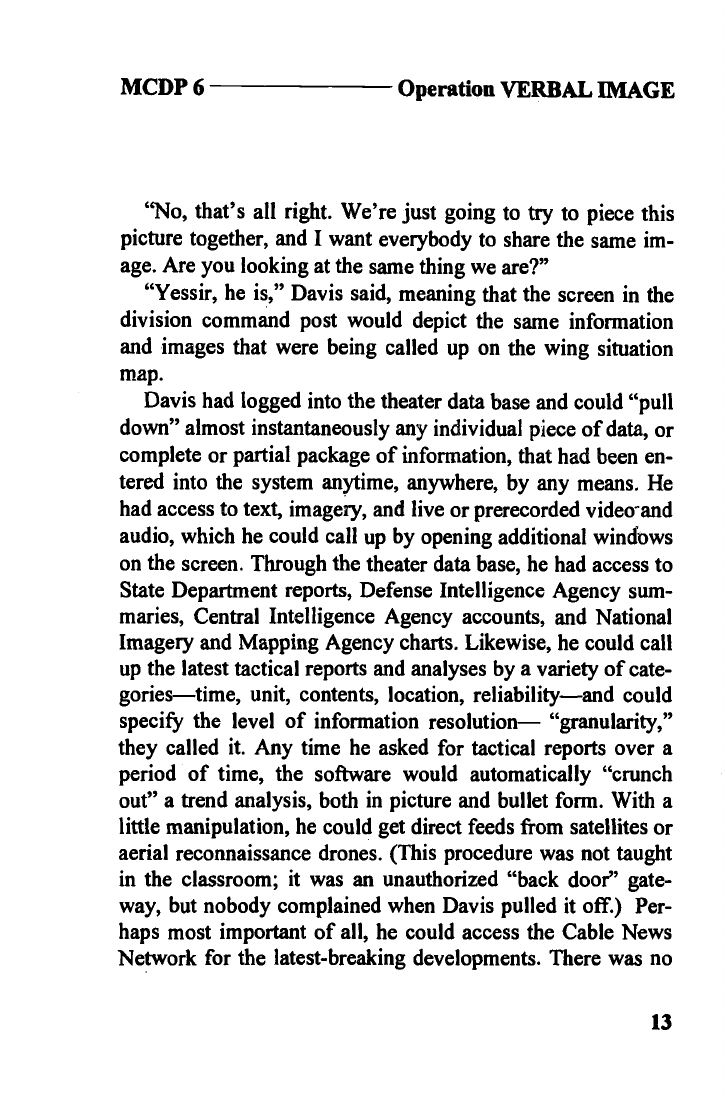
MCDP 6
Operation VERBAL IMAGE
"No, that's all right. We're just going to try to piece this
picture together, and I want everybody to share the same im-
age. Are you looking at the same thing we are?"
"Yessir, he is," Davis said, meaning that the screen in the
division command post would depict the same information
and images that were being called up on the wing situation
map.
Davis had logged into the theater data base and could "pull
down" almost instantaneously any individual piece of data, or
complete or partial package of information, that had been en-
tered into the system anytime, anywhere, by any means. He
had access to text, imagery, and live or prerecorded video-and
audio, which he could call up by opening additional windows
on the screen. Through the theater data base, he had access to
State Department reports, Defense Intelligence Agency sum-
maries, Central Intelligence Agency accounts, and National
Imagery and Mapping Agency charts. Likewise, he could call
up the latest tactical reports and analyses by a variety of cate-
gories—time, unit, contents, location, reliability—and could
specify the level of information resolution— "granularity,"
they called it. Any time he asked for tactical reports over a
period of time, the software would automatically "crunch
out" a trend analysis, both in picture and bullet form. With a
little manipulation, he could get direct feeds from satellites or
aerial reconnaissance drones. (This procedure was not taught
in the classroom; it was an unauthorized "back door" gate-
way, but nobody complained when Davis pulled it off.) Per-
haps most important of all, he could access the Cable News
Network for the latest-breaking developments. There was no
13

Command and Control
MCDP 6
lack of information out there, Davis knew. You were being
bombarded by it. Any yahoo could access a near-endless flow
of impressive data. The trick to being a good computer opera-
tor was being able to sift through it all to access the right in-
formation in the right form at the right time so the old man
could
figure out what it meant.
In an effort to make some sense of the enemy situation,
they pulled down various "packages" of information, mostly
in picture form, which promptly appeared and disappeared on
the screen at Davis' command. Enemy armor spottings within
the last 48, 24, and 12 hours. All ground contacts reported in
the last 48 and 24 hours. All enemy artillery units spotted and
fire missions reported in the last 48 hours. Road and rail us-
age in the last 72 hours. Sightings of enemy mobile air de-
fense equipment, usually a good indicator of the disposition
of the main body, in the last 48 and 24 hours. Enemy radio
traffic in the last week. Enemy aviation activity in the last 2
days. Every once in a while the MEF
commander
would ask
for a "template," a computer-generated estimate of possible
enemy dispositions and movements based on the partial infor-
mation that was available. Each template automatically came
with a reliability estimate—"resolution," they called it—cal-
culated as a percentage of complete reliability. The best reso-
lution they had gotten for any one template was 45 percent;
most were in the twenties and thirties. Statistically not very
good—but certainly as good as could be expected.
Another set of red enemy symbols flashed on the screen.
"What the hell," the MEF commander said, looking at the
screen which indicated a heavy flow of enemy helicopter
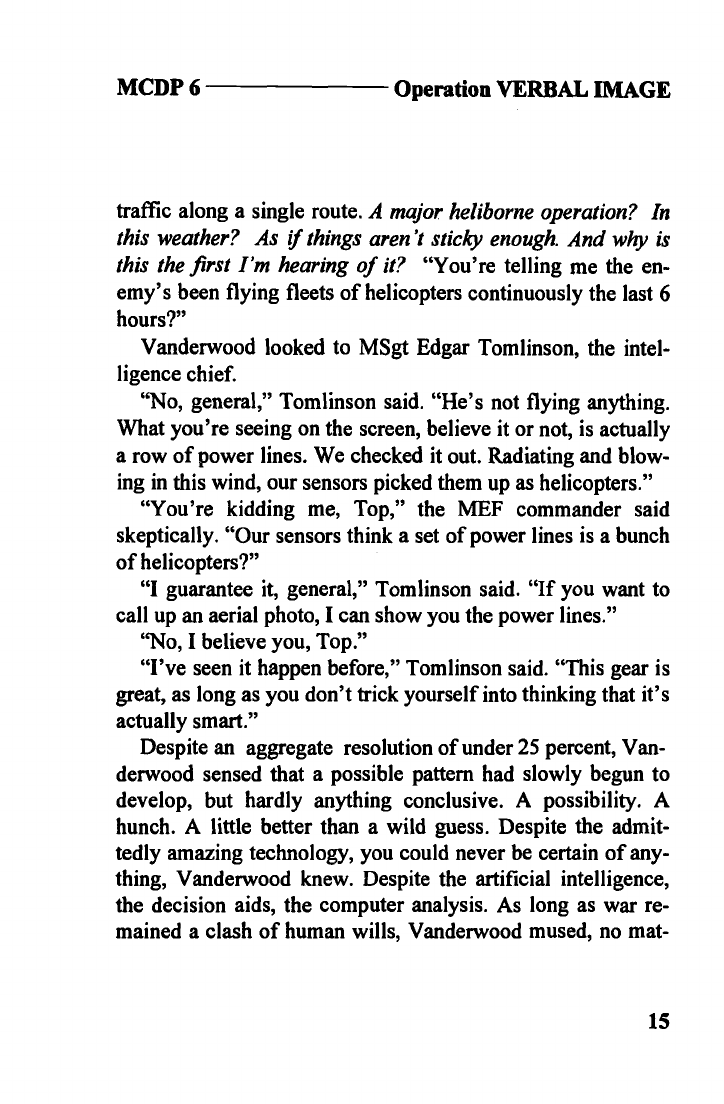
MCDP 6
Operation VERBAL IMAGE
traffic along a single route. A major
heliborne
operation? In
this weather? As if things aren 't sticky enough. And why is
this the first I'm hearing of it?
"You're telling me the en-
emy's been flying fleets of helicopters continuously the last 6
hours?"
Vanderwood looked to MSgt Edgar Tomlinson, the intel-
ligence chief.
"No, general," Tomlinson said. "He's not flying anything.
What you're seeing on the screen, believe it or not, is actually
a row of power lines. We checked it out. Radiating and blow-
ing in this wind, our sensors picked them up as helicopters."
"You're kidding me, Top," the MEF commander said
skeptically. "Our sensors think a set of power lines is a bunch
of helicopters?"
"I guarantee it, general," Tomlinson said. "If you want to
call up an aerial photo, I can show you the power lines."
"No, I believe you, Top."
"I've seen it happen before," Tomlinson said. "This gear is
great, as long as you don't trick yourself into thinking that it's
actually smart."
Despite an aggregate resolution of under 25 percent, Van-
derwood sensed that a possible pattern had slowly begun to
develop, but hardly anything conclusive. A possibility. A
hunch. A little better than a wild guess. Despite the admit-
tedly amazing technology, you could never be certain of any-
thing, Vanderwood knew. Despite the artificial intelligence,
the decision aids, the computer analysis. As long as war re-
mained a clash of human wills, Vanderwood mused, no mat-
15
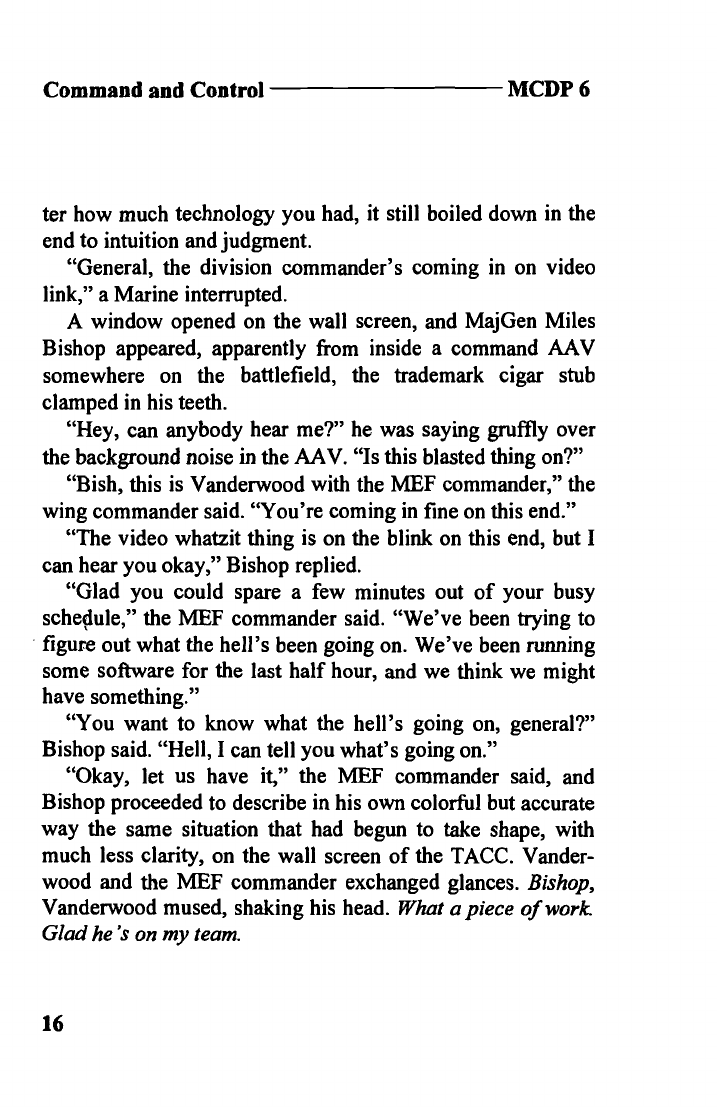
Command and Control
MCDP 6
ter how much technology you had, it still boiled down in the
end to intuition and judgment.
"General, the division commander's coming in on video
link," a Marine interrupted.
A window opened on the wall screen, and MajGen Miles
Bishop appeared, apparently from inside a command AAV
somewhere on the battlefield, the trademark cigar stub
clamped in his teeth.
"Hey, can anybody hear me?" he was saying gruffly over
the background noise in the AAV. "Is this blasted thing on?"
"Bish, this is Vanderwood with the MEF commander," the
wing commander said. "You're coming in fine on this end."
"The video whatzit thing is on the blink on this end, but I
can hear you okay," Bishop replied.
"Glad you could spare a few minutes out of your busy
schelule," the MEF commander said. "We've been trying to
figure out what the hell's been going on. We've been running
some software for the last half hour, and we think we might
have something."
"You want to know what the hell's going on, general?"
Bishop said. "Hell, I can tell you what's going on."
"Okay, let us have it," the MEF commander said, and
Bishop proceeded to describe in his own colorful but accurate
way the same situation that had begun to take shape, with
much less clarity, on the wall screen of the TACC. Vander-
wood and the MEF commander exchanged glances. Bishop,
Vanderwood mused, shaking his head. What apiece of work
Glad he 's on my team.
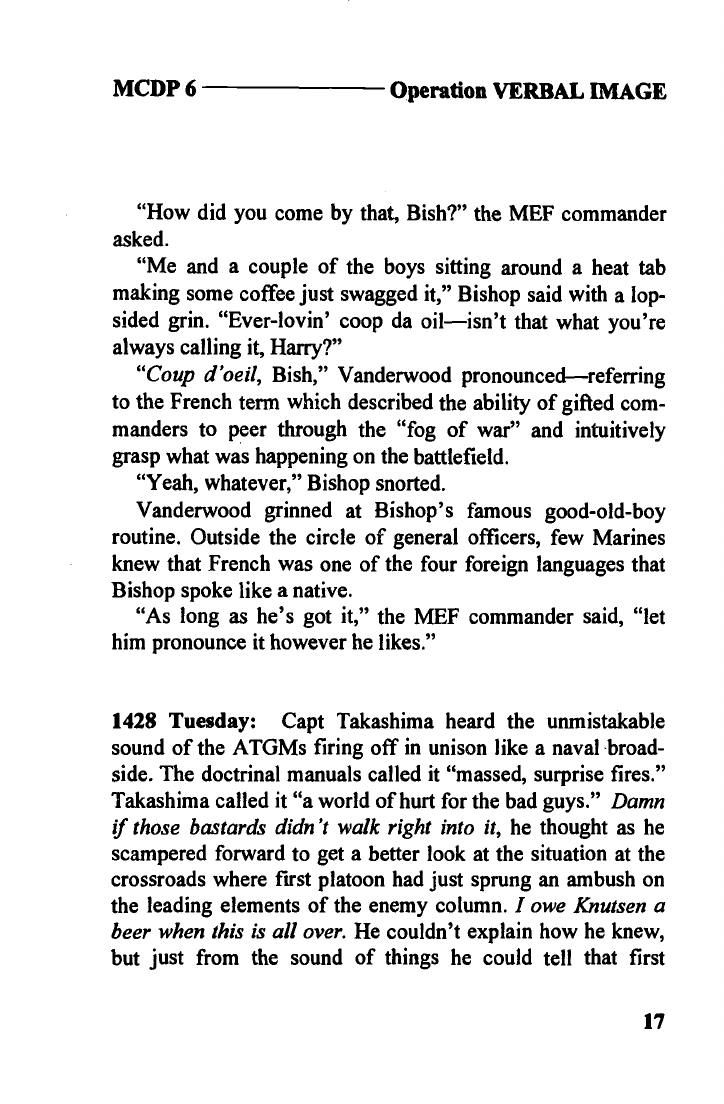
MCDP 6
Operation VERBAL IMAGE
"How did you come by that, Bish?" the MEF commander
asked.
"Me and a couple of the boys sitting around a heat tab
making some coffee just swagged it," Bishop said with a lop-
sided grin. "Ever-lovin' coop da oil—isn't that what you're
always calling it, Harry?"
"Coup d'oeil, Bish," Vanderwood pronounced—referring
to the French term which described the ability of gifted com-
manders to peer through the "fog of war" and intuitively
grasp what was happening on the battlefield.
"Yeah, whatever," Bishop snorted.
Vanderwood grinned at Bishop's famous good-old-boy
routine. Outside the circle of general officers, few Marines
knew that French was one of the four foreign languages that
Bishop spoke like a native.
"As long as he's got it," the MEF commander said, "let
him pronounce it however he likes."
1428 Tuesday: Capt Takashima heard the unmistakable
sound of the ATGMs firing off in unison like a naval broad-
side. The doctrinal manuals called it "massed, surprise fires."
Takashima called it "a world of hurt for the bad guys." Damn
if those bastards didn 't walk right into it, he thought as he
scampered forward to get a better look at the situation at the
crossroads where first platoon had just sprung an ambush on
the leading elements of the enemy column. I owe Knutsen a
beer when this is all over. He couldn't explain how he knew,
but just from the sound of things he could tell that first
17

Command and Control
MCDP 6
platoon had caught them pretty good. Amazing how you
learned to sense these things. The ground nearby erupted in a
massive explosion, and he hit the deck—S--or rather, the 6
inches of water that covered the deck.
"Olsen, you all right?" he yelled after checking to make
sure he was still in one piece.
"Yessir," his radioman replied. "Captain, third platoon
wants to talk to you."
Second Lieutenant Tim Dandridge, Golf Company's least
experienced platoon commander, was several hundred yards
off to the right. Takashima had originally put third platoon
where he could keep his eye on Dandridge, but when he'd
spun the company, it had left third platoon off on the right
flank by itself. Takashima switched on his headset.
"Oscar-3, this is Romeo-2-Oscar, go."
"Romeo-2-Oscar, I've got mechanized activity to my front
and more activity moving through the woods around my right
flank, over," Dandridge reported.
Even over the radio Takashima could sense the nervous-
ness in the lieutenant's voice.
"Echo's on your right flank," Takashima said.
"Roger, Romeo-2-Oscar, I don't think it's Echo," came the
reply. "I'm not picking them up on PLRS."
Takashima checked his electronic map board, networked to
Olsen's radio, which in addition to his own eight-digit loca-
tion could show the location of friendly transmitters. He
punched in a request for the location of all transmitters of pla-
toon level or higher. Dandridge was right: no Echo Company

MCDP 6
Operation VERBAL IMAGE
units. Which meant one of two things:
either Echo was so
badly lost they weren't even on the map, or somebody had
keyed the wrong code into all of Echo's transmitters.
"Have you made contact with Echo?" Takashima asked.
"Negative. Can't raise them."
"Any visual with the enemy?"
"Negative, but they're definitely out there," Dandridge
said. "Estimate at least a company."
"Roger, are you in position yet?"
Third platoon should
have been well set in by now, ready to ambush the advancing
enemy forces.
There was a pause.
"Er, roger . .
. pretty much,
Romeo-2-Oscar," came the halting reply.
Which meant "No," Takashima knew. Good news got
passed without hesitation; bad news always seemed to move
more reluctantly. Not a good sign. For a second, he consid-
ered heading over to third platoon's position to check things
out, but he quickly dismissed the idea. His intuition still told
him the critical action was taking place in front of him at first
platoon's position. Events were still unfolding as expected,
thanks to Knut-case. This was where he needed to be.
Chances were that the young lieutenant was exaggerating; but
yet, if Dandridge was right, then Takashima had read things
wrong, and the enemy had other ideas in mind. You could
never count on the bastards doing what they were supposed
to.
"Gunny!" Takashima bellowed over the sound of the shell-
ing.
19

Command and Control
MCDP 6
A moment later GySgt Roberto Hernandez splashed down
beside him.
"Gunny, third platoon is reporting enemy activity to their
front and flank," Takashima began.
"Roger that, skipper," Hemandez said. "I was listening in."
Naturally, Takashima thought. Nothing the gunny did sur-
prised him anymore.
"I'm concerned about what's going on over there," Taka-
shima said. "But I don't have time to check it out myself.
That activity they reported might or might not be Echo Com-
pany. Gunny, I want you to hustle over there, have a look
around, and report back to me what you see. Use an alternate
net. If it's real trouble, I need to know in a hurry. Don't step
on any toes, but you might want to make a few tactful sugges-
tions if it's appropriate."
"You want me to be, sir, what is sometimes referred to in
the literature as a 'directed telescope,' "Hernandez said.
"Directed tele-what? Get outta here, gunny," Takashima
said with a grin.
Sometimes it was a pain having the best-read staff NCO in
the Marine Corps as a company gunny, he decided as he
watched Hernandez charge away. But not usually.
1455, Tuesday: "Any questions?"
Any questions? Col Perry Gorman, the division G-3, won-
dered incredulously. Where should I start?
MajGen Bishop had just spent the last half hour orienting
his staff to the new situation. He stood in front of the large
20
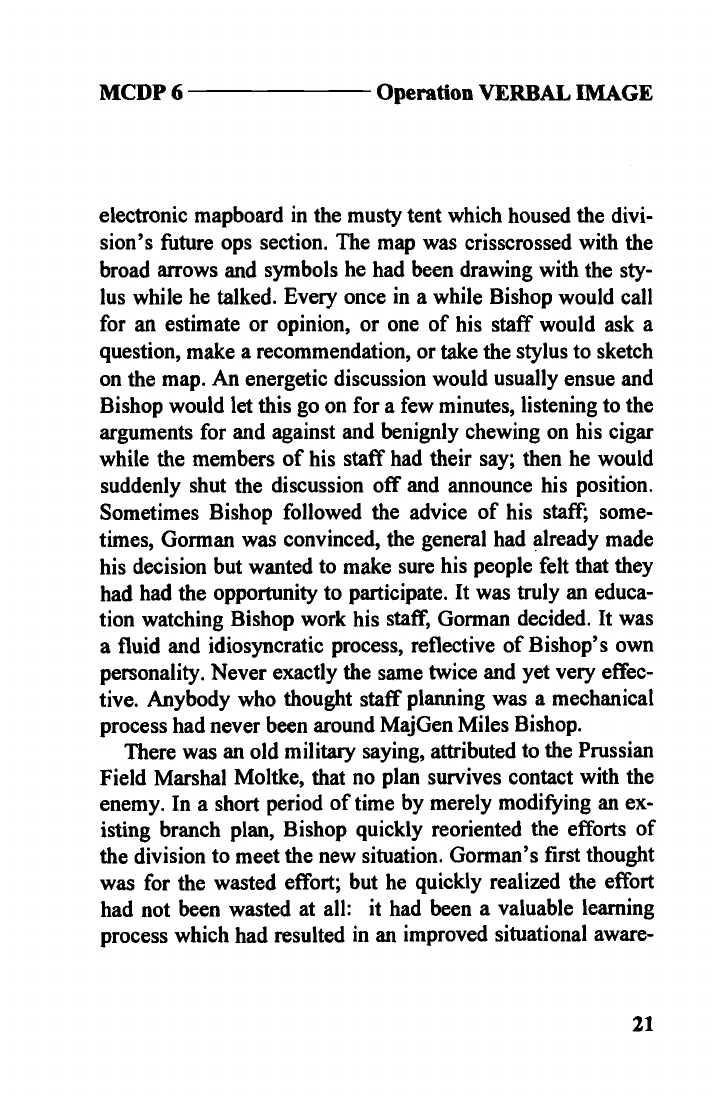
MCDP 6
Operation VERBAL IMAGE
electronic mapboard in the musty tent which housed the divi-
sion's future ops section. The map was crisscrossed with the
broad arrows and symbols he had been drawing with the sty-
lus while he talked. Every once in a while Bishop would call
for an estimate or opinion, or one of his staff would ask a
question, make a recommendation, or take the stylus to sketch
on the map. An energetic discussion would usually ensue and
Bishop would let this go on for a few minutes, listening to the
arguments for and against and benignly chewing on his cigar
while the members of his staff had their say; then he would
suddenly shut the discussion off and announce his position.
Sometimes Bishop followed the advice of his staff; some-
times, Gonnan was convinced, the general had already made
his decision but wanted to make sure his people felt that they
had had the opportunity to participate. It was truly an educa-
tion watching Bishop work his staff, Gorman decided. It was
a fluid and idiosyncratic process, reflective of Bishop's own
personality. Never exactly the same twice and yet very effec-
tive. Anybody who thought staff planning was a mechanical
process had never been around MajGen Miles Bishop.
There was an old military saying, attributed to the Prussian
Field Marshal Moltke, that no plan survives contact with the
enemy. In a short period of time by merely modifying an ex-
isting branch plan, Bishop quickly reoriented the efforts of
the division to meet the new situation. Gorman's first thought
was for the wasted effort; but he quickly realized the effort
had not been wasted at all:
it had been a valuable learning
process which had resulted in an improved situational aware-
21

Command and Control
MCDP 6
ness that was shared by Bishop, the entire staff, and subordi-
nate commanders.
A feeling had engulfed the command post that through pre-
vious good planning and adaptability the division had turned
a potential crisis into a decisive opportunity. Of course, Gor-
man mused, an awful lot of things had to happen to make
adaptability during execution possible. It's amazing how
much preparation is required to provide flexibility in execu-
tion. A
division contained an awful lot of independent parts
that needed to be working toward the same goal. The inteiii-
gence collection plan would have to be reoriented to the new
axis of advance, as would the fire support planning and the
logistics effort. Potential enemy countermoves would have to
be considered, as well as possible ways to deal with them.
One good
thing that doesn 't have
to change is the com-
mander 's
intent and its end state. The
force would have to be
reorganized to support the new taskings. Fragmentary orders
would have to be issued. Necessary coordination would have
to be effected above, below, and laterally—especially with
the wing since all the aviation support requirements had
changed. The light armor battalion would have to be rede-
ployed to continue the counterreconnaissance battle. With
Task Force Hammer as well as all the forward units commit-
ted to the exploitation, a new reserve would have to be çonsti-
tuted somehow, but not immediately. Thought would have to
be given to protecting the lengthening lines of communica-
tions as the pursuit continued. The general's concept for a
regimental helicopterborne attack into the enemy rear would
have to be worked out—a major evolution in itself (although
22
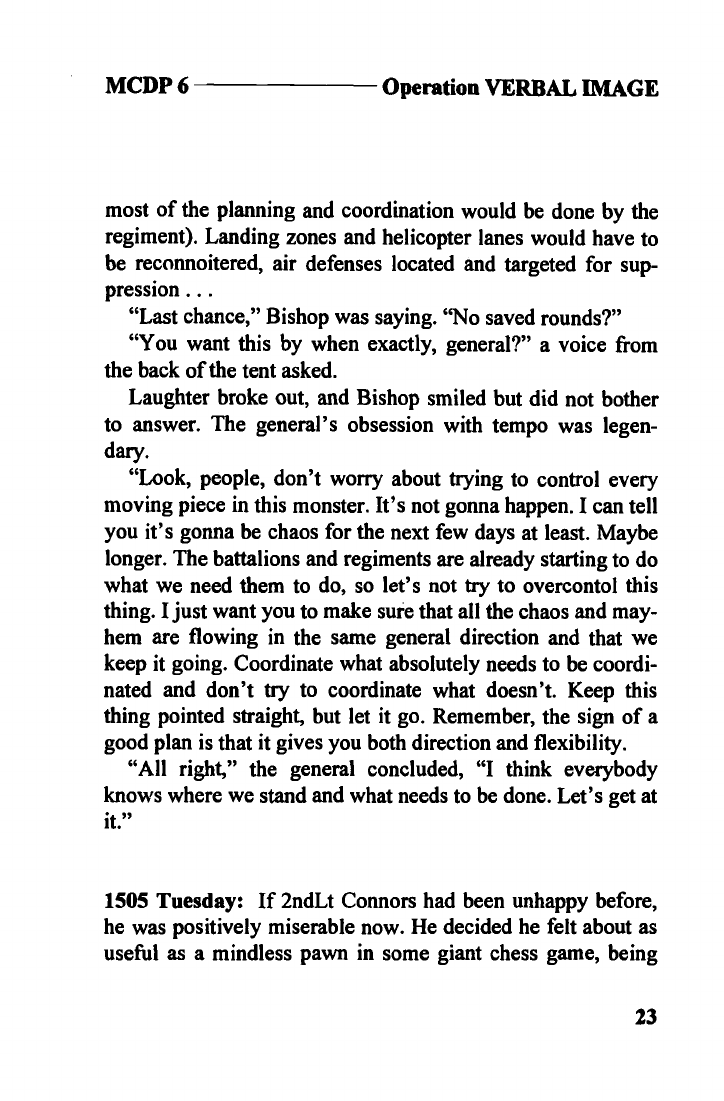
MCDP 6
Operation VERBAL IMAGE
most of the planning and coordination would be done by the
regiment). Landing zones and helicopter lanes would have to
be reconnoitered, air defenses located and targeted for sup-
pression...
"Last chance," Bishop was saying. "No saved rounds?"
"You want this by when exactly, general?" a voice from
the back of the tent asked.
Laughter broke out, and Bishop smiled but did not bother
to answer. The general's obsession with tempo was legen-
dary.
"Look, people, don't worry about trying to control every
moving piece in this monster. It's not gonna happen. I can tell
you it's gonna be chaos for the next few days at least. Maybe
longer. The battalions and regiments are already starting to do
what we need them to do, so let's not try to overcontol this
thing. I just want you to make sure that all the chaos and may-
hem are flowing in the same general direction and that we
keep it going. Coordinate what absolutely needs to be coordi-
nated and don't try to coordinate what doesn't. Keep this
thing pointed straight, but let it go. Remember, the sign of a
good plan is that it gives you both direction and flexibility.
"All right," the general concluded, "I think everybody
knows where we stand and what needs to be done. Let's get at
it."
1505 Tuesday: If 2ndLt Connors had been unhappy before,
he was positively miserable now. He decided he felt about as
useful as a mindless pawn in some giant chess game, being
23
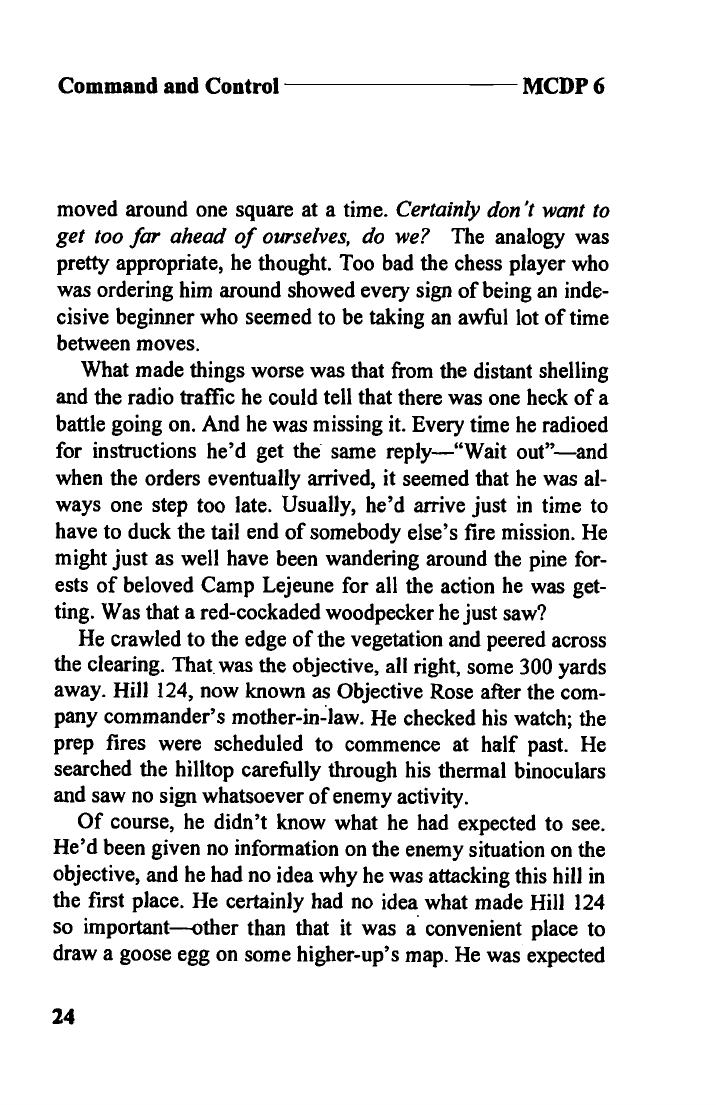
Command and Control
MCDP 6
moved around one square at a time. Certainly don't want to
get too far ahead of ourselves, do we?
The analogy was
pretty appropriate, he thought. Too bad the chess player who
was ordering him around showed every sign of being an inde-
cisive beginner who seemed to be taking an awful lot of time
between moves.
What made things worse was that from the distant shelling
and the radio traffic he could tell that there was one heck of a
battle going on. And he was missing it. Every time he radioed
for instructions he'd get the same reply—"Wait out"—and
when the orders eventually arrived, it seemed that he was al-
ways one step too late. Usually, he'd arrive just in time to
have to duck the tail end of somebody else's fire mission. He
might just as well have been wandering around the pine for-
ests of beloved Camp Lejeune for all the action he was get-
ting. Was that a red-cockaded woodpecker he just saw?
He crawled to the edge of the vegetation and peered across
the clearing. That was the objective, alt right, some 300 yards
away. Hill 124, now known as Objective Rose after the com-
pany commander's mother-in-law. He checked his watch; the
prep fires were scheduled to commence at half past. He
searched the hilltop carefully through his thermal binoculars
and saw no sign whatsoever of enemy activity.
Of course, he didn't know what he had expected to see.
He'd been given no information on the enemy situation on the
objective, and he had no idea why he was attacking this hill in
the first place. He certainly had no idea what made Hill 124
so important—-other than that it was a convenient place to
draw a goose egg on some higher-up's map. He was expected
24
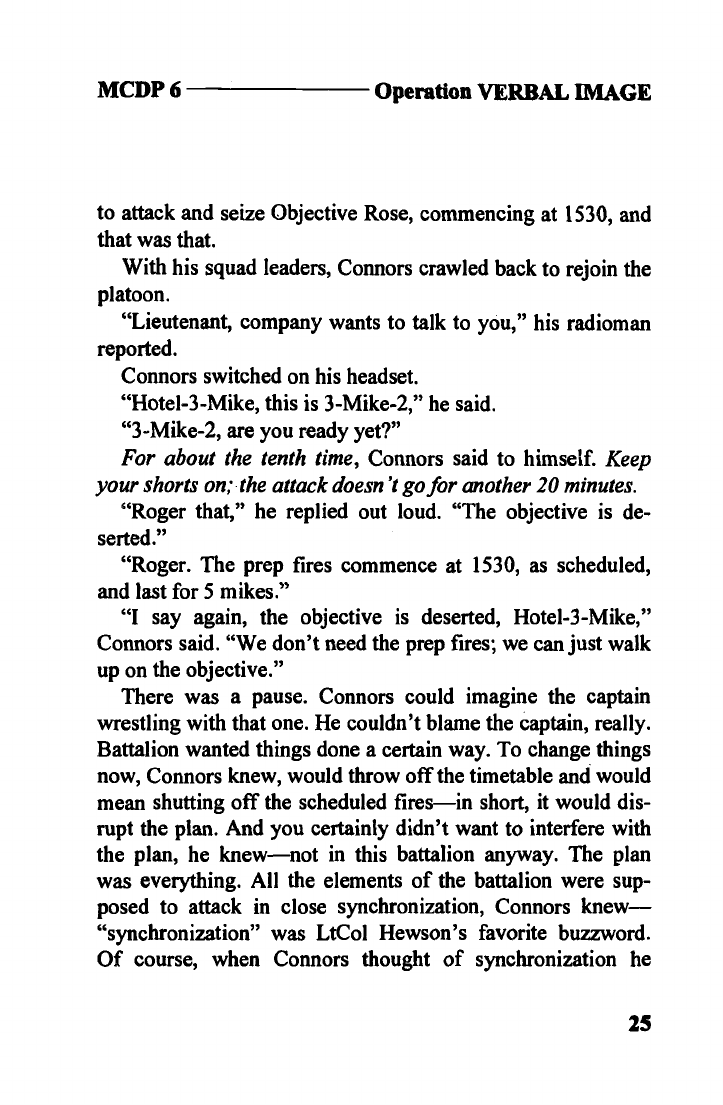
MCDP 6
Operation VERBAL IMAGE
to attack and seize Objective Rose, commencing at 1530, and
that was that.
With his squad leaders, Connors crawled back to rejoin the
platoon.
"Lieutenant, company wants to talk to you," his radioman
reported.
Connors switched on his headset.
"Hotel-3-Mike, this is 3-Mike-2," he said.
"3-Mike-2, are you ready yet?"
For about the tenth time, Connors said to himself. Keep
your shorts on; the attack doesn 'I go
for another 20 minutes.
"Roger that," he replied out loud. "The objective is de-
serted."
"Roger. The prep fires commence at 1530, as scheduled,
and last for 5 mikes."
"I say again, the objective is deserted, Hotel-3-Mike,"
Connors said. "We don't need the prep fires; we can just walk
up on the objective."
There was a pause. Connors could imagine the captain
wrestling with that one. He couldn't blame the captain, really.
Battalion wanted things done a certain way. To change things
now, Connors knew, would throw off the timetable and would
mean shutting off the scheduled fires—in short, it would dis-
rupt the plan. And you certainly didn't want to interfere with
the plan, he knew—not in this battalion anyway. The plan
was everything. All the elements of the battalion were sup-
posed to attack in close synchronization, Connors knew—
"synchronization" was LtCol Hewson's favorite buzzword.
Of course, when Connors thought of synchronization he
25
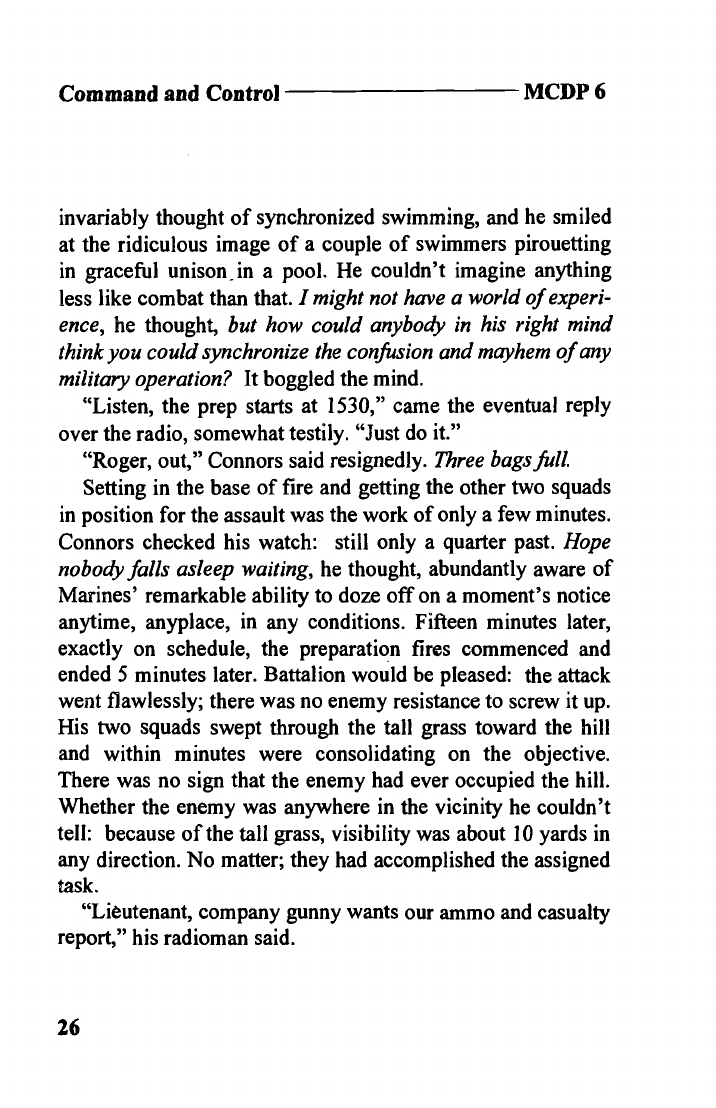
Command and Control
MCDP 6
invariably thought of synchronized swimming, and he smiled
at the ridiculous image of a couple of swimmers pirouetting
in graceflul unison in a pool. He couldn't imagine anything
less like combat than that. I might not have a world of experi-
ence, he thought, but how could anybody in his right mind
think you could synchronize the confusion and mayhem of any
military operation? It boggled the mind.
"Listen, the prep starts at 1530," came the eventual reply
over the radio, somewhat testily. "Just do it."
"Roger, out," Connors said resignedly. Three bags fulL
Setting in the base of fire and getting the other two squads
in position for the assault was the work of only a few minutes.
Connors checked his watch:
still only a quarter past. Hope
nobody falls asleep waiting, he thought, abundantly aware of
Marines' remarkable ability to doze off on a moment's notice
anytime, anyplace, in any conditions. Fifteen minutes later,
exactly on schedule, the preparation fires commenced and
ended 5 minutes later. Battalion would be pleased: the attack
went flawlessly; there was no enemy resistance to screw it up.
His two squads swept through the tall grass toward the hill
and within minutes were consolidating on the objective.
There was no sign that the enemy had ever occupied the hill.
Whether the enemy was anywhere in the vicinity he couldn't
tell: because of the tall grass, visibility was about 10 yards in
any direction. No matter; they had accomplished the assigned
task.
"Litutenant, company gunny wants our ammo and casualty
report," his radioman said.
26
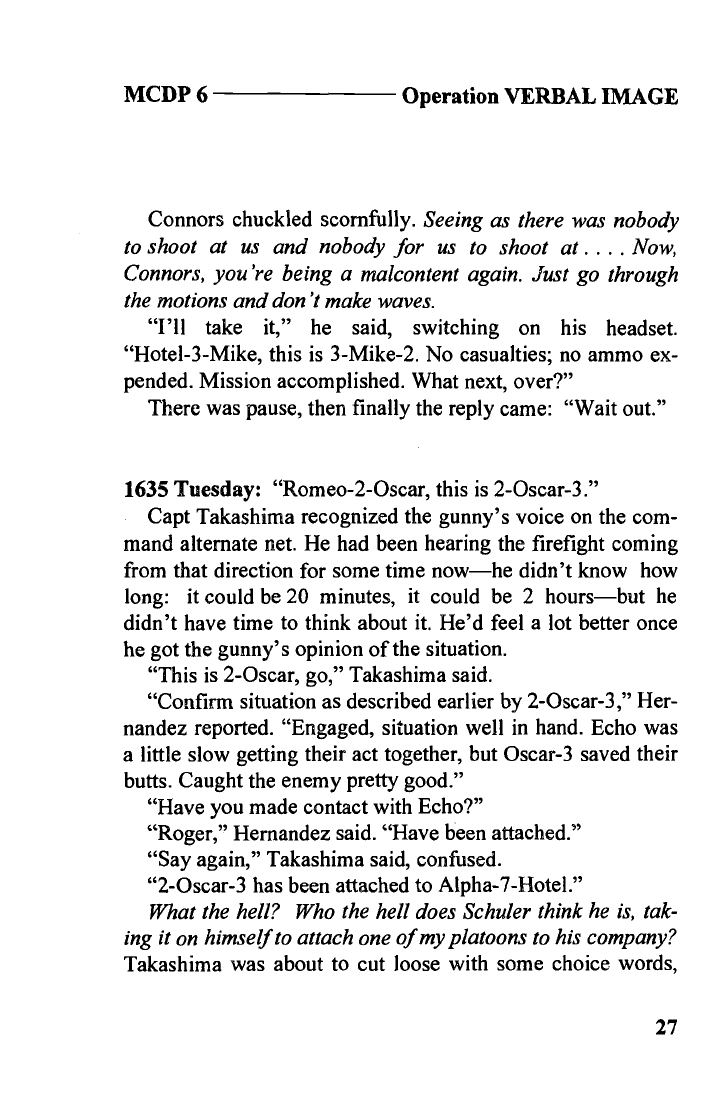
MCDP 6
Operation VERBAL IMAGE
Connors chuckled scornfully. Seeing as there was nobody
to shoot at us and nobody for us to shoot at.
. .
. Now,
Connors, you're being a malcontent again. Just go through
the motions and don 't make waves.
"I'll take it,"
he said, switching on
his headset.
"Hotel-3-Mike, this is 3-Mike-2. No casualties; no ammo ex-
pended. Mission accomplished. What next, over?"
There was pause, then finally the reply came: "Wait out."
1635 Tuesday: "Romeo-2-Oscar, this is 2-Oscar-3."
Capt Takashima recognized the gunny's voice on the com-
mand alternate net. He had been hearing the firefight coming
from that direction for some time now—he didn't know how
long:
it could be 20 minutes, it could be 2 hours—but he
didn't have time to think about it. He'd feel a lot better once
he got the gunny's opinion of the situation.
"This is 2-Oscar, go," Takashima said.
"Confirm situation as described earlier by 2-Oscar-3," Her-
nandez reported. "Engaged, situation well in hand. Echo was
a little slow getting their act together, but Oscar-3 saved their
butts. Caught the enemy pretty good."
"Have you made contact with Echo?"
"Roger," Hernandez said. "Have been attached."
"Say again," Takashima said, confused.
"2-Oscar-3 has been attached to A(pha-7-HoteL"
What the hell? Who the hell does Schuler think he is, tak-
ing it on himself to attach one of my platoons to his company?
Takashima was about to cut loose with some choice words,
27

Command and Control
MCDP 6
but he thought better of it. He knew that he was in no posi-
tion to try to control what third platoon was doing; he was too
busy dealing with the situation at the crossroads. Sometimes
the enemy didn't use the same boundaries that we did, Taka-
shima realized: third platoon was really part of Echo's fight.
That being the case, Takashima knew that for the purposes of
unity of command third platoon ought to be answering to
Schuler and not to him. It was hardly conventional, Taka-
shima decided—certainly not the school solution—but, under
the circumstances, it was the right thing to do. I guess that's
what gunny would call a "self-organizing, complex adaptive
system, "Takashima mused. I'lljust have to remember to give
Schuler a hard time about needing four platoons to do what
we can do with only two.
0255 Wednesday: The MEF commander shed his dripping
poncho as he stepped out of the rain into the MEF command
post. The military policeman snapped to attention and saluted.
"Carry on, Sgt McDavid. Cpl Cooper," he said to his
soaked driver, "get some sleep. It's been a long day."
He made his way into the operations center and dropped
wearily into his chair where he'd started the operation some
24 hours before. In the last 24 hours, he'd been all over the
MEF area of operations. He'd been to the division forward
command post to talk to the division commander face-to-face
about how to deal with the unexpected developments. He'd
insisted on a face-to-face because he wanted to make sure
they understood each other. He'd been to the wing head-
28

MCDP 6
Operation VERBAL IMAGE
quarters twice to try to get a handle on the
overall
situation
and to see what could be done about air support. He'd person-
ally debriefed the Cobra pilots who'd first spotted the enemy
column. He'd videotaped a new intent statement—an "intent-
o-mmercial," as the Marines jokingly referred to it—to be
broadcast to the entire MEF (at least down to battalion and
squadron level, the lowest level that had video capability). He
and the wing commander had taken a terrifying V-22 flight
over the battlefield (and unfortunately had gotten precious lit-
tle out of it). He'd been back to the MEF command post once
during the day to see if the situation had gotten any clearer
since he'd left: it hadn't. He'd visited the division's main-
effort regiment and that regiment's main-effort battalion near
Culverin Crossroads. (It hadn't been until he'd met that CO
from Golf Company, Capt Taka-something, and had seen the
indomitable fighting spirit of his Marines that he'd realized
that the MEF would
carry the day—"Just get me some air,
general," the captain had said.) He'd visited the engineers to
make sure that the roads were going to hold up for at least the
next 72 hours in this rain. He'd even spent several hours su-
pervising an assault river crossing during the critical early
stages of the pursuit. And he'd happened upon the FSSG
commander at a maintenance contact point, of all places,
where they'd watched an M1A3 main battle tank repaired and
put back into action; they'd discussed the logistics needed to
support the upcoming exploitation.
It seemed like days since he'd been at the command post.
On the wall screen before him, the amorphous wave of flash-
ing green unit symbols had crept considerably farther north
29
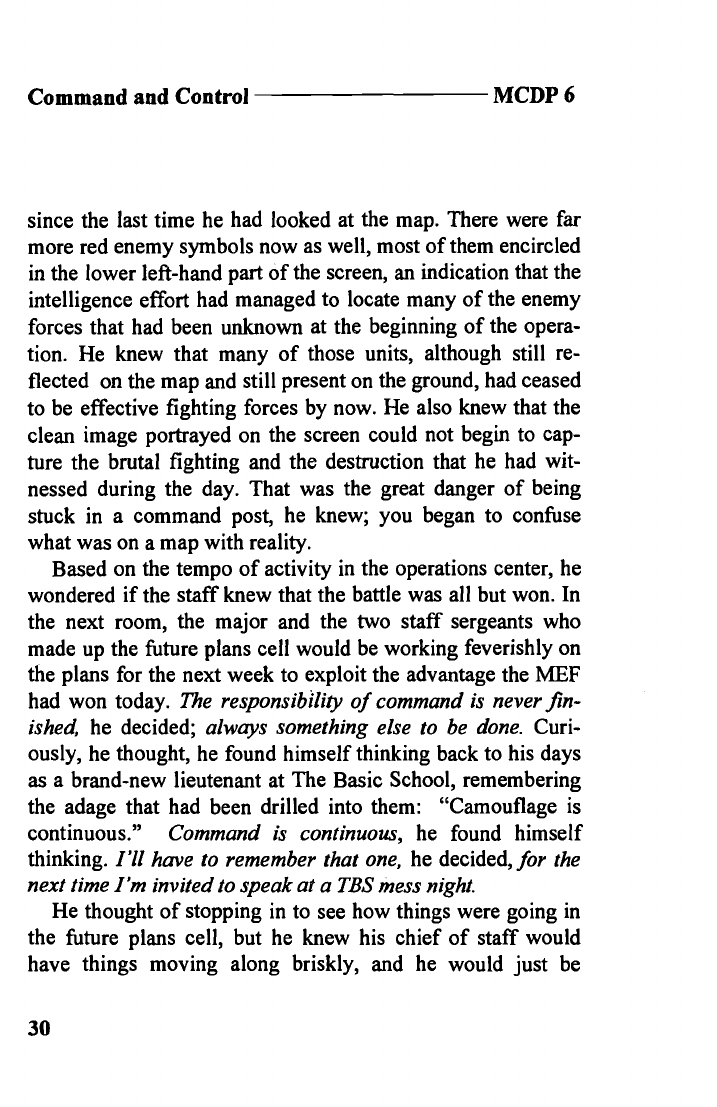
Command and Control
MCDP 6
since the last time he had looked at the map. There were far
more red enemy symbols now as well, most of them encircled
in the lower left-hand part of the screen, an indication that the
intelligence effort had managed to locate many of the enemy
forces that had been unknown at the beginning of the opera-
tion. He knew that many of those units, although still re-
flected on the map and still present on the ground, had ceased
to be effective fighting forces by now. He also knew that the
clean image portrayed on the screen could not begin to cap-
ture the brutal fighting and the destruction that he had wit-
nessed during the day. That was the great danger of being
stuck in a command post, he knew; you began to confuse
what was on a map with reality.
Based on the tempo of activity in the operations center, he
wondered if the staff knew that the battle was all but won. In
the next room, the major and the two staff sergeants who
made up the future plans cell would be working feverishly on
the plans for the next week to exploit the advantage the MEF
had won today. The responsibility of command is never fin-
ished, he decided; always something else to be done. Curi-
ously, he thought, he found himself thinking back to his days
as a brand-new lieutenant at The Basic School, remembering
the adage that had been drilled into them: "Camouflage is
continuous." Command is continuous, he found himself
thinking. I'll have to remember that one, he decided, for the
next time I'm invited to speak at a TBS mess night.
He thought of stopping in to see how things were going in
the future plans cell, but he knew his chief of staff would
have things moving along briskly, and he would just be
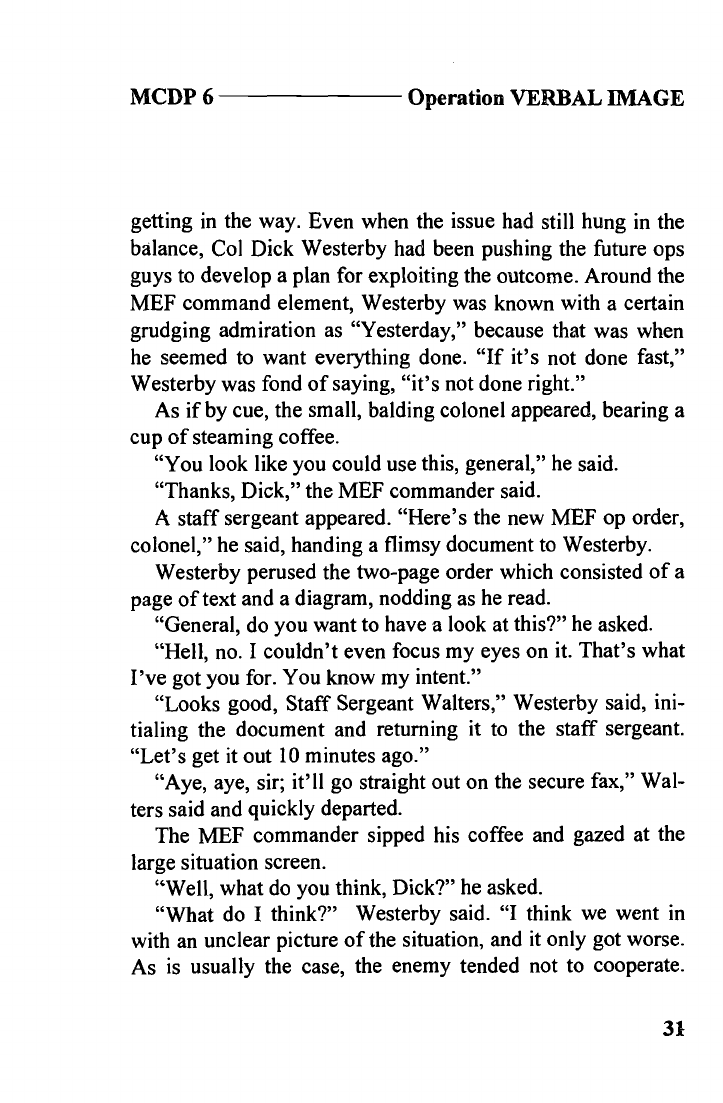
MCDP 6
Operation VERBAL iMAGE
getting in the way. Even when the issue had still hung in the
balance, Col Dick Westerby had been pushing the future ops
guys to develop a plan for exploiting the outcome. Around the
MEF command element, Westerby was known with a certain
grudging admiration as "Yesterday," because that was when
he seemed to want everything done. "If it's not done fast,"
Westerby was fond of saying, "it's not done right."
As if by cue, the small, balding colonel appeared, bearing a
cup of steaming coffee.
"You look like you could use this, general," he said.
"Thanks, Dick," the MEF commander said.
A staff sergeant appeared. "Here's the new MEF op order,
colonel," he said, handing a flimsy document to Westerby.
Westerby perused the two-page order which consisted of a
page of text and a diagram, nodding as he read.
"General, do you want to have a look at this?" be asked.
"Hell, no. I couldn't even focus my eyes on it. That's what
I've got you for. You know my intent."
"Looks good, Staff Sergeant Walters," Westerby said, ini-
tialing the document and returning it to the staff sergeant.
"Let's get it out 10 minutes ago."
"Aye, aye, sir; it'll go straight out on the secure fax," Wal-
ters said and quickly departed.
The MEF commander sipped his coffee and gazed at the
large situation screen.
"Well, what do you think, Dick?" he asked.
"What do I think?" Westerby said. "I think we went in
with an unclear picture of the situation, and it only got worse.
As is usually the case, the enemy tended not to cooperate.
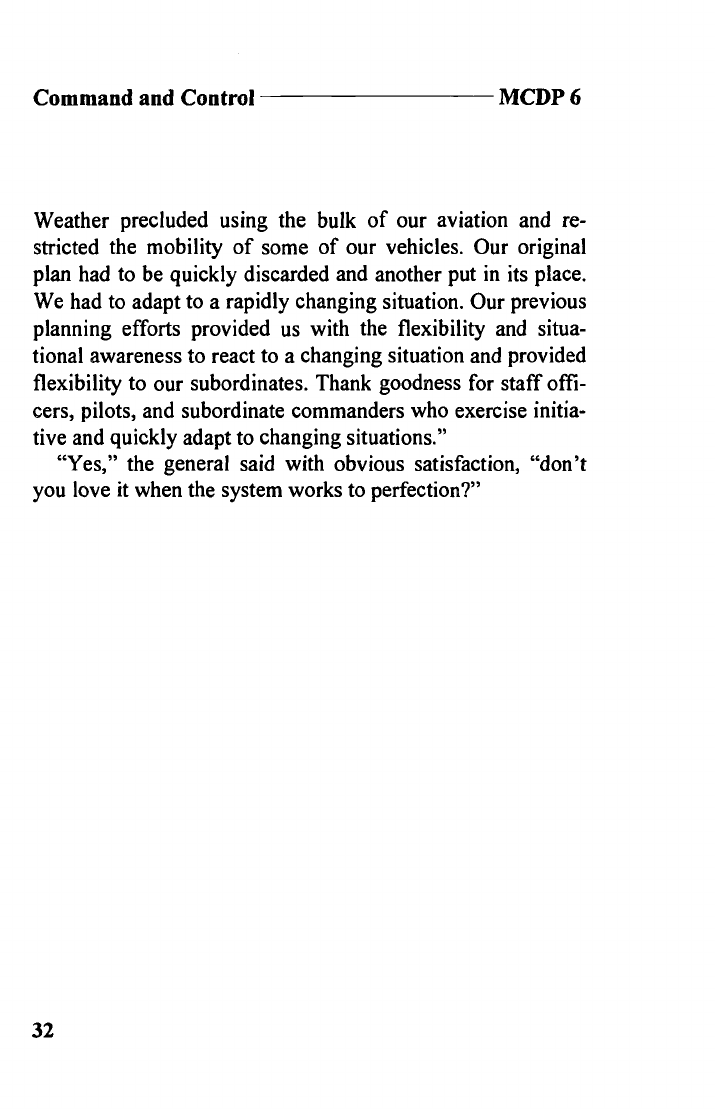
Command and Control
MCDP 6
Weather precluded using the bulk of our aviation and re-
stricted the mobility of some of our vehicles. Our original
plan had to be quickly discarded and another put in its place.
We had to adapt to a rapidly changing situation. Our previous
planning efforts provided us with the flexibility and situa-
tional awareness to react to a changing situation and provided
flexibility to our subordinates. Thank goodness for staff offi-
cers, pilots, and subordinate commanders who exercise initia-
tive and quickly adapt to changing situations."
"Yes," the general said with obvious satisfaction, "don't
you love it when the system works to perfection?"
32
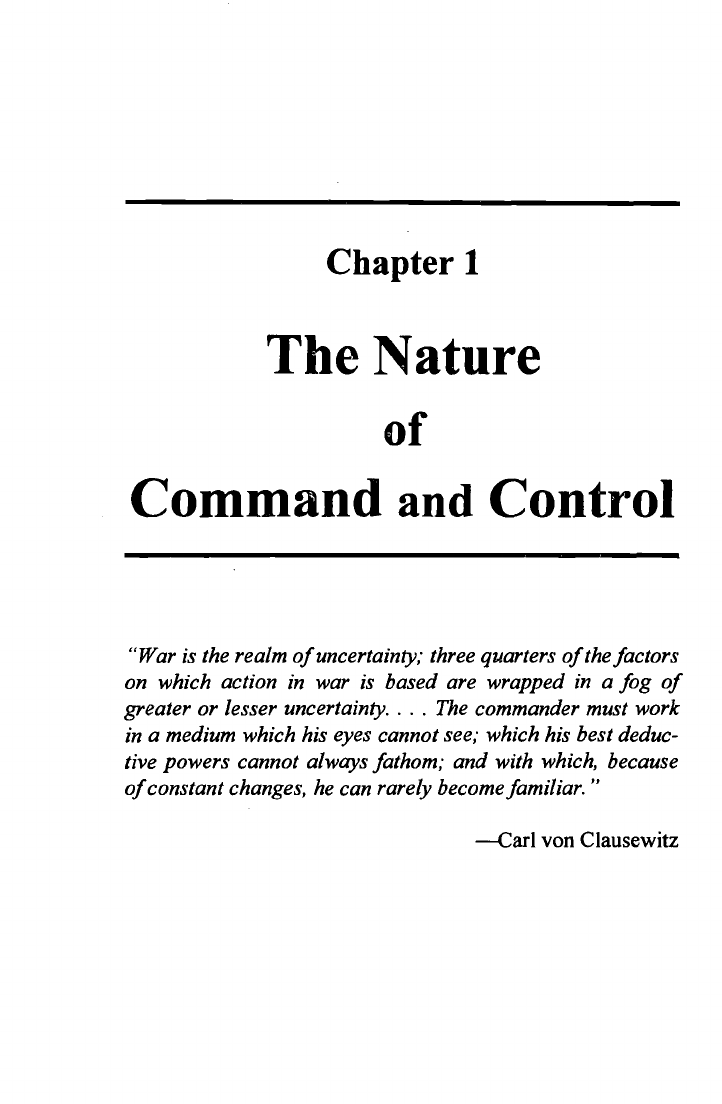
Chapter 1
The Nature
of
Command and Control
"War is the realm of uncertainty, three quarters of the factors
on which action in war is based are wrapped in a fog of
greater or lesser uncertainly... .
The commander must work
in a medium which his eyes cannot see; which his best deduc-
tive powers cannot always fathom; and with which, because
of constant changes, he can rarely become familiar."
—Carl von Clausewitz

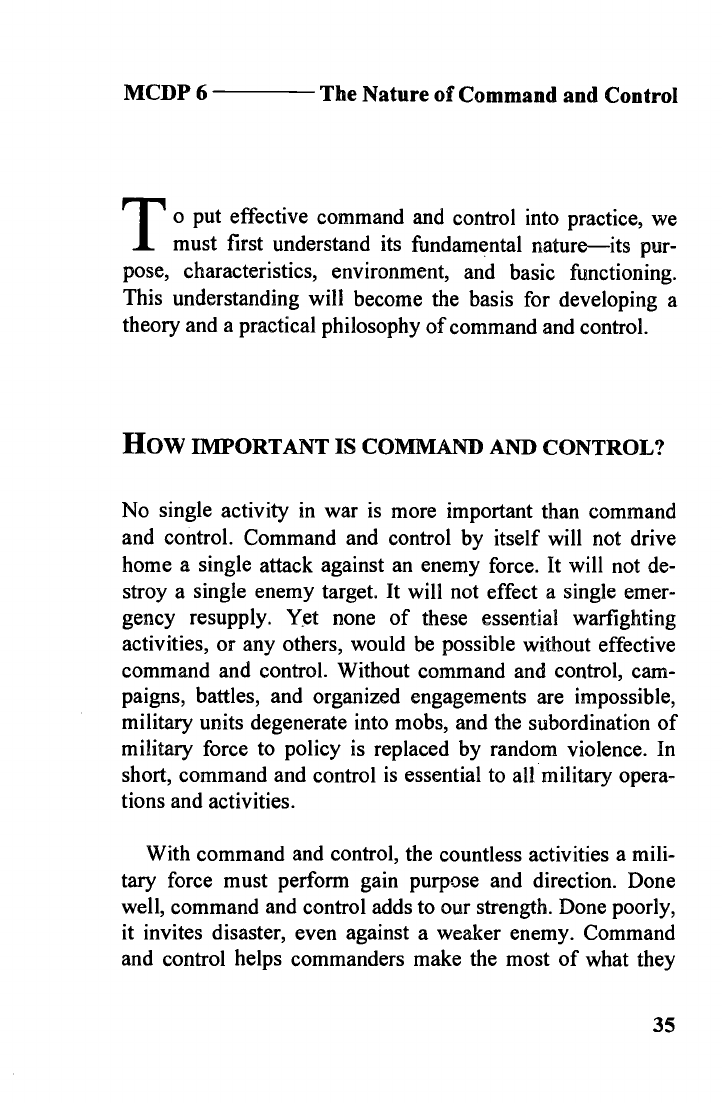
MCDP 6
The Nature of Command and Control
T
o put effective command and control into practice, we
must first understand its fundamental nature—its pur-
pose, characteristics, environment, and basic functioning.
This understanding will become the basis for developing a
theory and a practical philosophy of command and control.
How IMPORTANT IS COMMAND AND CONTROL?
No single activity in war is more important than command
and control. Command and control by itself will not drive
home a single attack against an enemy force. It will not de-
stroy a single enemy target. It will not effect a single emer-
gency resupply. Yet none of these essential warfighting
activities, or any others, would be possible without effective
command and control. Without command and control, cam-
paigns, battles, and organized engagements are impossible,
military units degenerate into mobs, and the subordination of
military force to policy is replaced by random violence. In
short, command and control is essential to all military opera
tions and activities.
With command and control, the countless activities a mili-
tary force must perform gain purpose and direction. Done
well, command and control adds to our strength. Done poorly,
it invites disaster, even against a weaker enemy. Command
and control helps commanders make the most of what they
35

Command and Control
MCDP 6
have—people, information, material, and, often most impor-
tant of all, time.
In the broadest sense, command and control applies far be-
yond military forces and military operations. Any system
comprising multiple, interacting elements, from societies to
sports teams to any living organism, needs some form of
command and control. Simply put, command and control in
some form or another is essential to survival and success in
any competitive or cooperative enterprise. Command and
control is a fundamental requirement for life and growth, sur-
vival, and success for any system.
WHAT IS COMMAND AND CONTROL?
We often think of command and control as a distinct and
specialized function—like logistics, intelligence, electronic
warfare, or administration—with its own peculiar methods,
considerations, and vocabulary, and occurring independently
of other functions. But in fact, command and control encom-
passes all military functions and operations, giving them
meaning and harmonizing them into a meaningful whole.
None of the above functions, or any others, would be pur-
poseful without command and control. Command and control
36
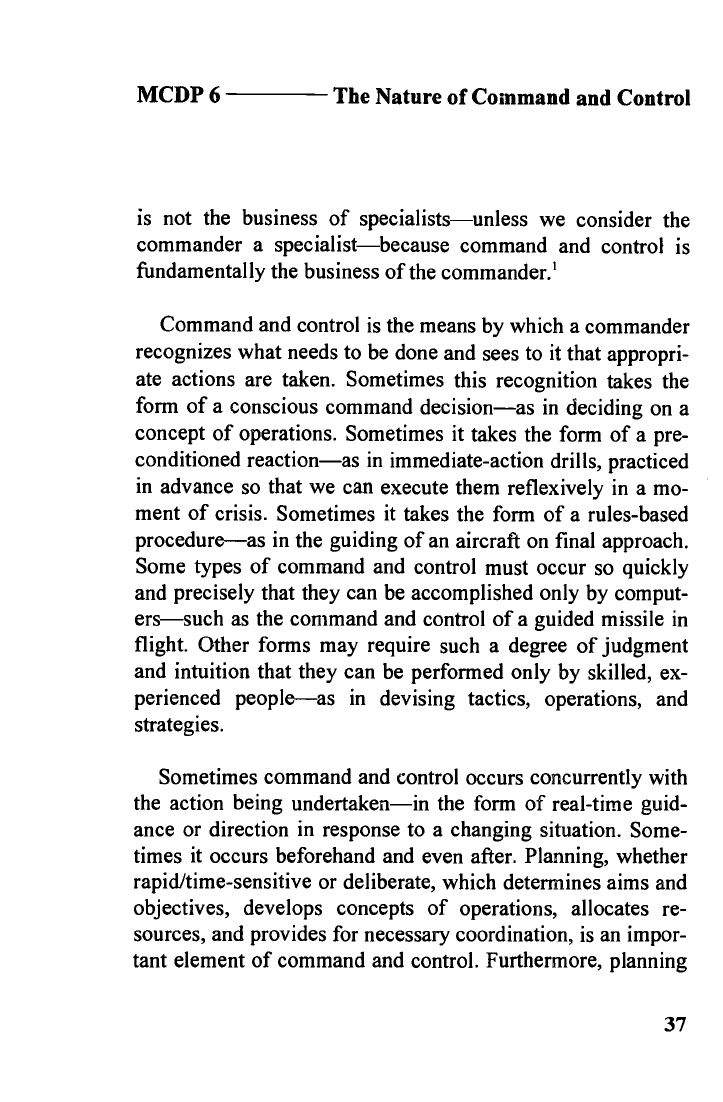
MCDP 6
The Nature of Command and Control
is not the business of specialists—unless we consider the
commander a specialist—because command and control is
fundamentally the business of the commander.'
Command and control is the means by which a commander
recognizes what needs to be done and sees to it that appropri-
ate actions are taken. Sometimes this recognition takes the
form of a conscious command decision—as in deciding on a
concept of operations. Sometimes it takes the form of a pre-
conditioned reaction—as in immediate-action drills, practiced
in advance so that we can execute them reflexively in a mo-
ment of crisis. Sometimes it takes the form of a rules-based
procedure—as in the guiding of an aircraft on final approach.
Some types of command and control must occur so quickly
and precisely that they can be accomplished only by comput-
ers—such as the command and control of a guided missile in
flight. Other forms may require such a degree of judgment
and intuition that they can be performed only by skilled, ex-
perienced people-as in devising tactics, operations, and
strategies.
Sometimes command and control occurs concurrently with
the action being undertaken—in the form of real-time guid-
ance or direction in response to a changing situation. Some-
times it occurs beforehand and even after. Planning, whether
rapidltime-sensitive or deliberate, which determines aims and
objectives, develops concepts of operations, allocates re-
sources, and provides for necessary coordination, is an impor-
tant element of command and control. Furthermore, planning
37

Command and Control
MCDP 6
increases knowledge and elevates situational awareness. Ef-
fective training and education, which make it more likely that
subordinates will take the proper action in combat, establish
command and control before the fact. The immediate-action
drill mentioned earlier, practiced beforehand, provides com-
mand and control. A commander's intent, expressed clearly
before the evolution begins, is an essential part of command
and control. Likewise, analysis after the fact, which ascertains
the results and lessons of the action and so informs future ac-
tions, contributes to command and control.
Some forms of command and control are primarily proce-
dural or technical in nature—such as the control of air traffic
and air space, the coordination of supporting arms, or the fire
control of a weapons system. Others deal with the overall
conduct of military actions, whether on a large or small scale,
and involve formulating concepts, deploying forces, allocat-
ing resources, supervising, and so on. This last form of com-
mand and control, the overall conduct of military actions, is
our primary concern in this manual. Unless otherwise speci-
fied, it is to this form that we refer.
Since war is a conflict between opposing wills, we can
measure the effectiveness of command and control only in re-
lation to the enemy. As a practical matter, therefore, effective
command and control involves protecting our own command
and control activities against enemy interference and actively
monitoring, manipulating, and disrupting the enemy's com-
mand and control activities.
38

MCDP 6
The Nature of Command and Control
WHAT IS THE BASIS OF COMMAND AND
CONTROL?
The basis for all command arid control is the authority vested
in a commander over subordinates. Authority derives from
two sources. Official authority is a function of rank and posi-
tion and is bestowed by organization and by law. Personal
authority is a function of personal influence and derives from
factors such as experience, reputation, skill, character, and
personal example. It is bestowed by the other members of the
organization. Official authority provides the power to act but
is rarely enough; most effective commanders also possess a
high degree of personal authority. Responsibility, or account-
ability for results, is a natural corollary of authority. Where
there is authority, there must be responsibility in like meas-
ure. Conversely, where individuals have responsibility for
achieving results, they must also have the authority to initiate
the necessary actions.2
WHAT IS THE RELATIONSIIIP BETWEEN
"COMMAND" AND "CONTROL"?
The traditional view of command and control sees "com-
mand" and "control" as operating in the same direction: from
the top of the organization toward the bottom.3 (See figure 1.)
Commanders impose control on those under their command;
39

Command and Control
MCDP 6
commanders are "in control" of their subordinates, and subor-
dinates are "under the control" of their commanders.
We suggest a different and more dynamic view of com-
mand and control which sees command as the exercise of
authority and control as feedback about the effects of the ac-
tion taken. (See figure 1.) The commander commands by de-
ciding what needs to be done and by directing or influencing
the conduct of others. Control takes the form of feed-
back—the continuous flow of information about the unfold-
ing situation returning to the commander—which allows the
commander to adjust and modify command action as needed.
Feedback indicates the difference between the goals and the
situation as it exists. Feedback may come from any direction
and in any form—intelligence about how the enemy is react-
ing, information about the status of subordinate or adjacent
units, or revised guidance from above based on develop-
ments. Feedback is the mechanism that allows commanders
to adapt to changing circumstances—to exploit fleeting op-
portunities,
respond
to
developing problems,
modify
schemes, or redirect efforts. In this way, feedback "controls"
subsequent command action. In such a command and control
system, control is not strictly something that seniors impose
on subordinates; rather, the entire system comes "under con-
trol" based on feedback about the changing situation.4
Command and control is thus an interactive process in-
volving all the parts of the system and working in all direc-
tions. The result is a mutually supporting system of give and
40

MCDP 6
The Nature of Command and Control
A typical view of com-
mand and control—com-
mand and control seen
as unidirectional.
Command and control
viewed as reciprocal in-
fluence—command as
initiation of action and
control as feedback.
Figure 1. Two views of the relationship
between command and control.
take
in which complementary commanding and controlling
forces interact to ensure that the force as a whole can adapt
continuously to changing requirements.
COMMANDER
I COMMANDER
I
I COMMANDER
COMMANDER
I—
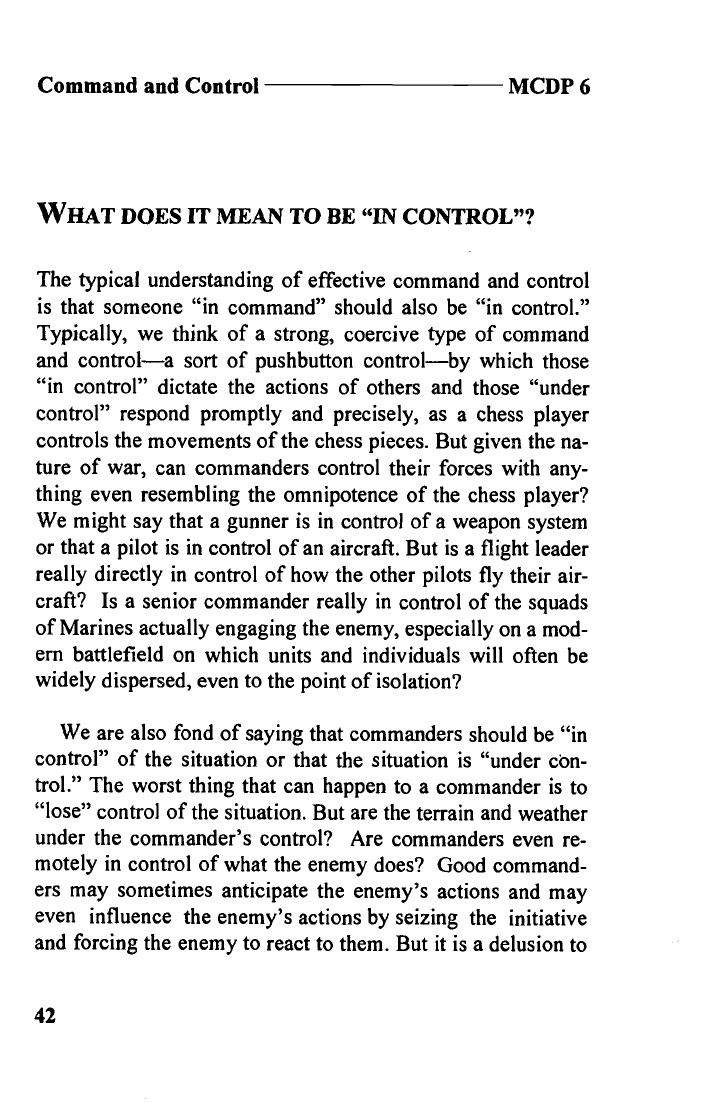
Command and Control
MCDP 6
WHAT DOES IT MEAN TO BE "IN CONTROL"?
The typical understanding of effective command and control
is that someone "in command" should also be "in control."
Typically, we think of a strong, coercive type of command
and control—a sort of pushbutton control—by which those
"in control" dictate the actions of others and those "under
control" respond promptly and precisely, as a chess player
controls the movements of the chess pieces. But given the na-
ture of war, can commanders control their forces with any-
thing even resembling the omnipotence of the chess player?
We might say that a gunner is in control of a weapon system
or that a pilot is in control of an aircraft. But is a flight leader
really directly in control of how the other pilots fly their air-
craft? Is a senior commander really in control of the squads
of Marines actually engaging the enemy, especially on a mod-
ern battlefield on which units and individuals will often be
widely dispersed, even to the point of isolation?
We are also fond of saying that commanders should be "in
control" of the situation or that the situation is "under con-
trol." The worst thing that can happen to a commander is to
"lose" control of the situation. But are the terrain and weather
under the commander's control? Are commanders even re-
motely in control of what the enemy does? Good comm and-
ers may sometimes anticipate the enemy's actions and may
even influence the enemy's actions by seizing the initiative
and forcing the enemy to react to them. But it is a delusion to
42

MCDP 6
The Nature of Command and Control
believe that we can truly be in control of the enemy or the
situation.5
The truth is that, given the nature of war, it is a delusion to
think that we can be in control with any sort of certitude or
precision. And the further removed commanders are from the
Marines actually engaging the enemy, the less direct control
they have over their actions. We must keep in mind that war
is at base a human endeavor. In war, unlike in chess, "pieces"
consist of human beings, all reacting to the situation as it per-
tains to each one separately, each trying to survive, each
prone to making mistakes, and each subject to the vagaries of
human nature. We could not get people to act like mindless
robots, even if we wanted to.
Given the nature of war, the remarkable thing is not that
commanders cannot be thoroughly in control but rather that
they can achieve much influence at all. We should accept that
the proper object of command and control is not to be thor-
oughly and precisely in control. The turbulence of modem
war suggests a need for a looser form of influence—some-
thing that is more akin to the willing cooperation of a basket-
ball team than to the omnipotent direction of the chess
player—that provides the hecessary guidance in an uncertain,
disorderly, time-competitive environment without stifling the
initiative of subordinates.
43
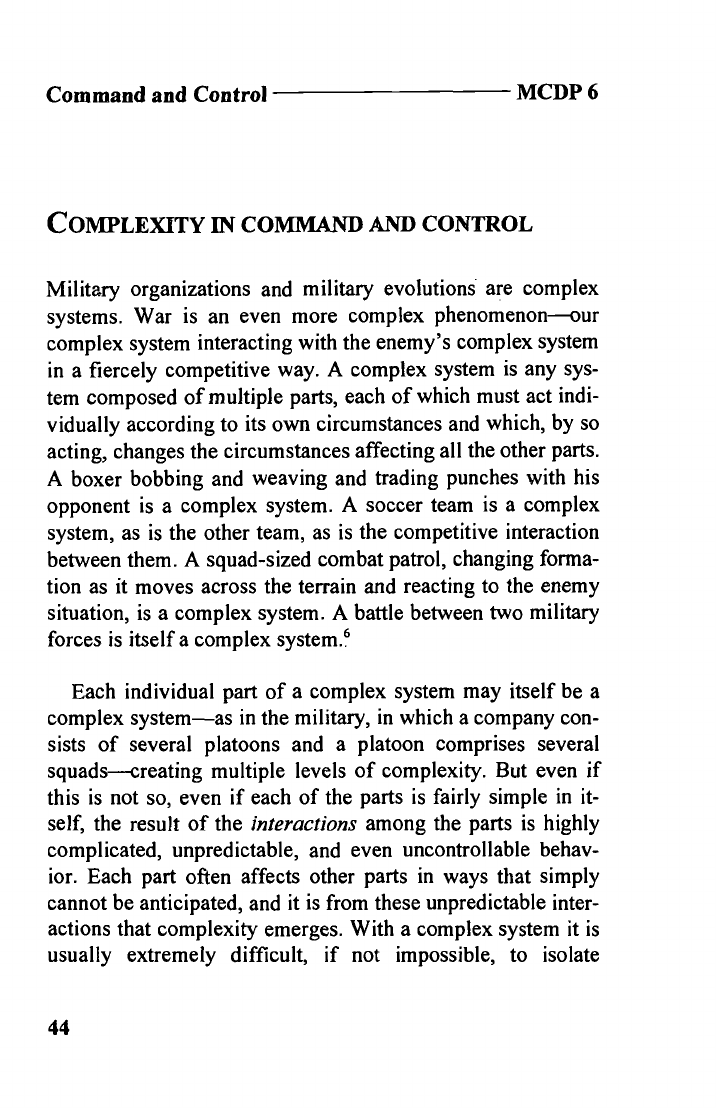
Command and Control
MCDP 6
COMPLEXITY IN COMMAND AND CONTROL
Military organizations and military evolutions are complex
systems. War is an even more complex phenomenon—our
complex system interacting with the enemy's complex system
in a fiercely competitive way. A complex system is any sys-
tem composed of multiple parts, each of which must act indi-
vidually according to its own circumstances and which, by so
acting, changes the circumstances affecting all the other parts.
A boxer bobbing and weaving and trading punches with his
opponent is a complex system. A soccer team is a complex
system, as is the other team, as is the competitive interaction
between them. A squad-sized combat patrol, changing forma-
tion as it moves across the terrain and reacting to the enemy
situation, is a complex system. A battle between two military
forces is itself a complex system.6
Each individual part of a complex system may itself be a
complex system—as in the military, in which a company con-
sists of several platoons and a platoon comprises several
squads—creating multiple levels of complexity. But even if
this is not so, even if each of the parts is fairly simple in it-
self, the result of the interactions among the parts is highly
complicated, unpredictable, and even uncontrollable behav-
ior. Each part often affects other parts in ways that simply
cannot be anticipated, and it is from these unpredictable inter-
actions that complexity emerges. With a complex system it is
usually extremely difficult,
if not impossible, to
isolate
44

MCDP 6
The Nature of Command and Contro'
individual causes and their effects since the parts are all con-
nected in a complex web. The behavior of complex systems is
frequently nonlinear which means that even extremely small
influences can have decisively large effects, or vice versa.
Clausewitz wrote that "success is not due simply to general
causes. Particular factors can often be decisive—details only
known to those who were on the spot.
. . while issues can be
decided by chances and incidents so minute as to figure in
histories simply as anecdotes."
The element of chance, in-
teracting randomly with the various parts of the system, intro-
duces even more complexity and unpredictability.
It is not simply the number of parts that makes a system
complex:
it is the way those parts interact. A machine can be
complicated and consist of numerous parts, but the parts gen-
erally interact in a specific, designed way—or else the ma-
chine will not function. While some systems behave mech-
anistically, complex systems most definitely do not. Complex
systems tend to be open systems, interacting frequently and
freely with other systems and the external environment. Com-
plex systems tend to behave more "organically"—that is,
more like biological organisms.8
The fundamental point is that any military action, by its
very nature a complex system, will exhibit messy, unpredict-
able, and often chaotic behavior that defies orderly, efficient,
and precise control. Our approach to command and control
must find a way to cope with this inherent complexity. While
a machine operator may be in control of the machine, it is
45
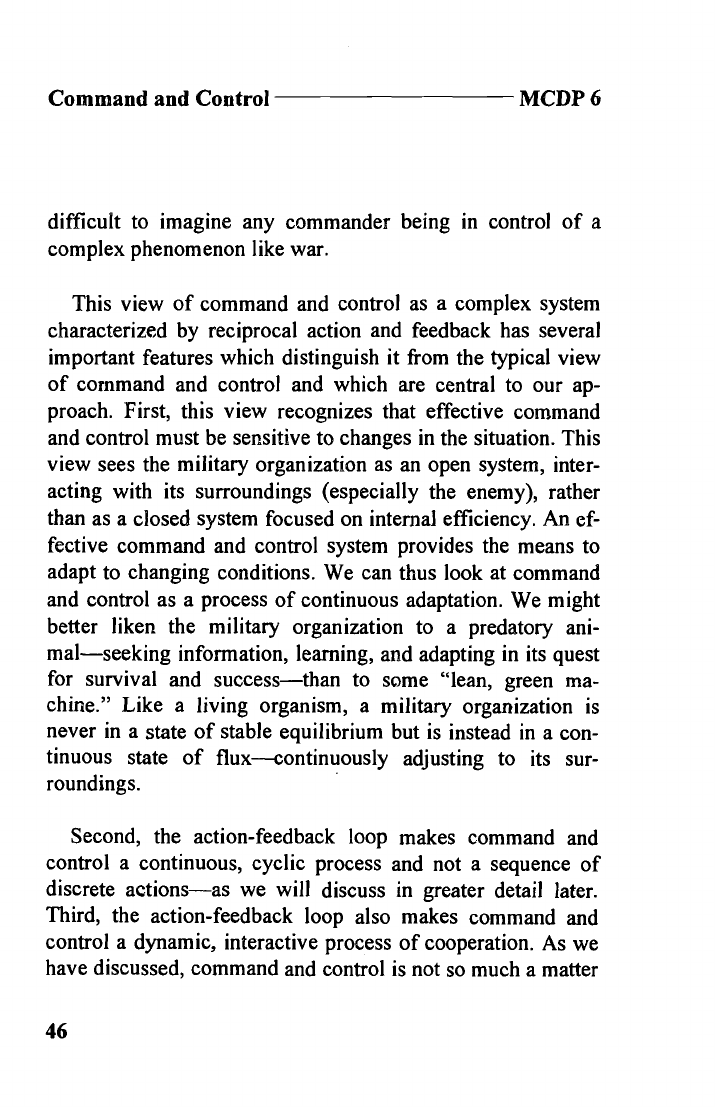
Command and Control
MCDP 6
difficult to imagine any commander being in control of a
complex phenomenon like war.
This view of command and control as a complex system
characterized by reciprocal action and feedback has several
important features which distinguish it from the typical view
of command and control and which are central to our ap-
proach. First, this view recognizes that effective command
and control must be sensitive to changes in the situation. This
view sees the military organization as an open system, inter-
acting with its surroundings (especially the enemy), rather
than as a closed system focused on internal efficiency. An ef-
fective command and control system provides the means to
adapt to changing conditions. We can thus look at command
and control as a process of continuous adaptation. We might
better liken the military organization to a predatory ani-
mal—seeking information, learning, and adapting in its quest
for survival and success—than to some "lean, green ma-
chine." Like a living organism, a military organization is
never in a state of stable equilibrium but is instead in a con-
tinuous state of flux—continuously adjusting to
its sur-
roundings.
Second, the action-feedback loop makes command and
control a continuous, cyclic process and not a sequence of
discrete actions—as we will discuss in greater detail later.
Third, the action-feedback loop also makes command and
control a dynamic, interactive process of cooperation. As we
have discussed, command and control is not so much a matter
46

MCDP 6
The Nature of Command and Control
of one part of the organization "getting control over" another
as something that connects all the elements together in a co-
operative effort. All parts of the organization contribute ac-
tion and feedback—"command" and "control"—in overall
cooperation. Command and control is thus fundamentally an
activity of reczprocal influence—give and take among all
parts, from top to bottom and side to side.
Fourth, as a result, this view does not see the commander
as being above the system, exerting command and control
from the outside—like a chess player moving the chess
pieces—but as being an integral part of this complex web of
reciprocal influence. And finally, as we have mentioned, this
view recognizes that it is unreasonable to expect command
and control to provide precise, predictable, and mechanistic
order to a complex undertaking like war.
WhAT MAKES
UP COMMAND AND CONTROL?
The words "command" and "control" can be nouns,9 and used
in this way the phrase command and control describes a sys-
tem—an arrangement of different elements that interact to
produce effective and harmonious actions. The basic elements
of our command and control system are people, information,
and the command and control support structure.
47
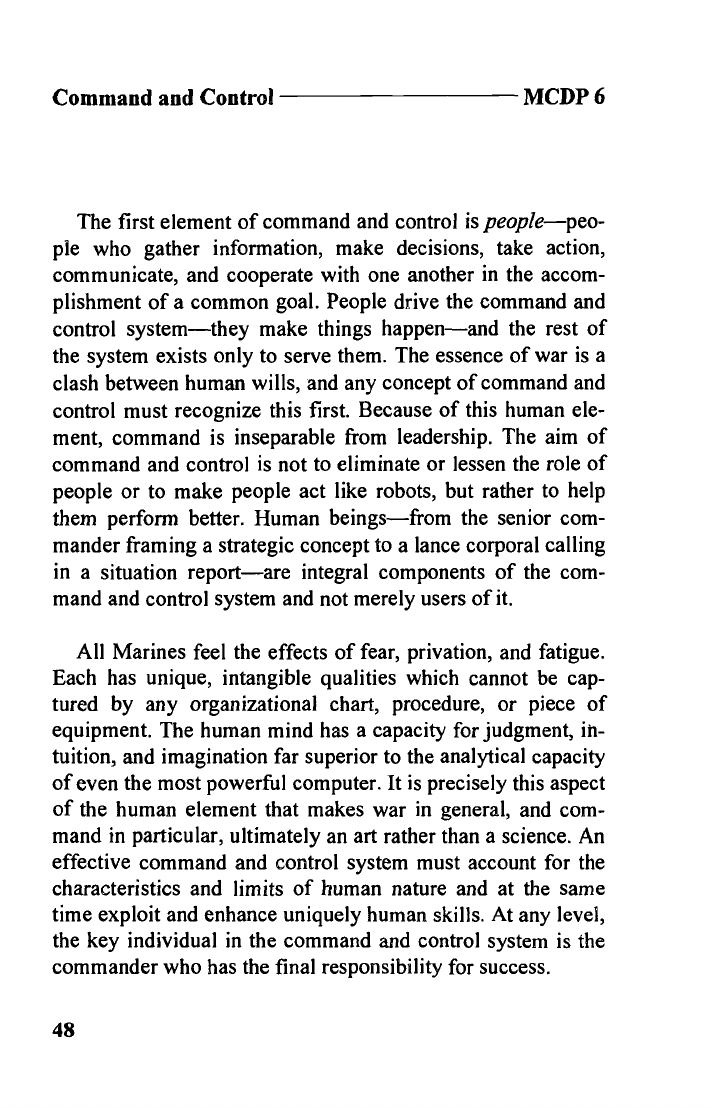
Command and Control
MCDP 6
The first element of command and control is people—peo-
pie who gather information, make decisions, take action,
communicate, and cooperate with one another in the accom-
plishment of a common goal. People drive the command and
control system—they make things happen—and the rest of
the system exists only to serve them. The essence of war is a
clash between human wills, and any concept of command and
control must recognize this first. Because of this human ele-
ment, command is inseparable from leadership. The aim of
command and control is not to eliminate or lessen the role of
people or to make people act like robots, but rather to help
them perform better. Human beings—from the senior com-
mander framing a strategic concept to a lance corporal calling
in a situation report—are integral components of the com-
mand and control system and not merely users of it.
All Marines feel the effects of fear, privation, and fatigue.
Each has unique, intangible qualities which cannot be cap-
tured by any organizational chart, procedure, or piece of
equipment. The human mind has a capacity for judgment, in-
tuition, and imagination far superior to the analytical capacity
of even the most powerful computer. It is precisely this aspect
of the human element that makes war in general, and com-
mand in particular, ultimately an art rather than a science. An
effective command and control system must account for the
characteristics and limits of human nature and at the same
time exploit and enhance uniquely human skills. At any level,
the key individual in the command and control system is the
commander who has the final responsibility for success.
48

MCDP 6
The Nature of Command and Control
The second element of command and control is informa-
tion, which refers to representations of reality which we use
to "inform"—to give form and character to—our decisions
and actions. Information is the words, letters, numbers, im-
ages, and symbols we use to represent things, events, ideas,
and values. In one way or another, command and control is
essentially about information: getting it, judging its value,
processing it into useful form, acting on it, sharing it with
others. Information is how we give structure and shape to the
material world, and it thus allows us to give meaning to and
to gain understanding of the events and conditions which sur-
round us. In a very broad sense, information is a control pa-
rameter: it allows us to provide control or structure to our
actions.'°
The value of information exists in time since information
most often describes fleeting conditions. Most information
grows stale with time, valuable one moment but irrelevant or
even misleading the next.
There are two basic uses for information. The first is to
help create situational awareness as the basis for a decision.
The second is to direct and coordinate actions in the execu-
tion of the decision. While distinct in concept, the two uses of
information are rarely mutually exclusive in practice. There
will usually be quite a bit of overlap since the same exchange
of information often serves both purposes simultaneously. For
example, coordination between adjacent units as they execute
49
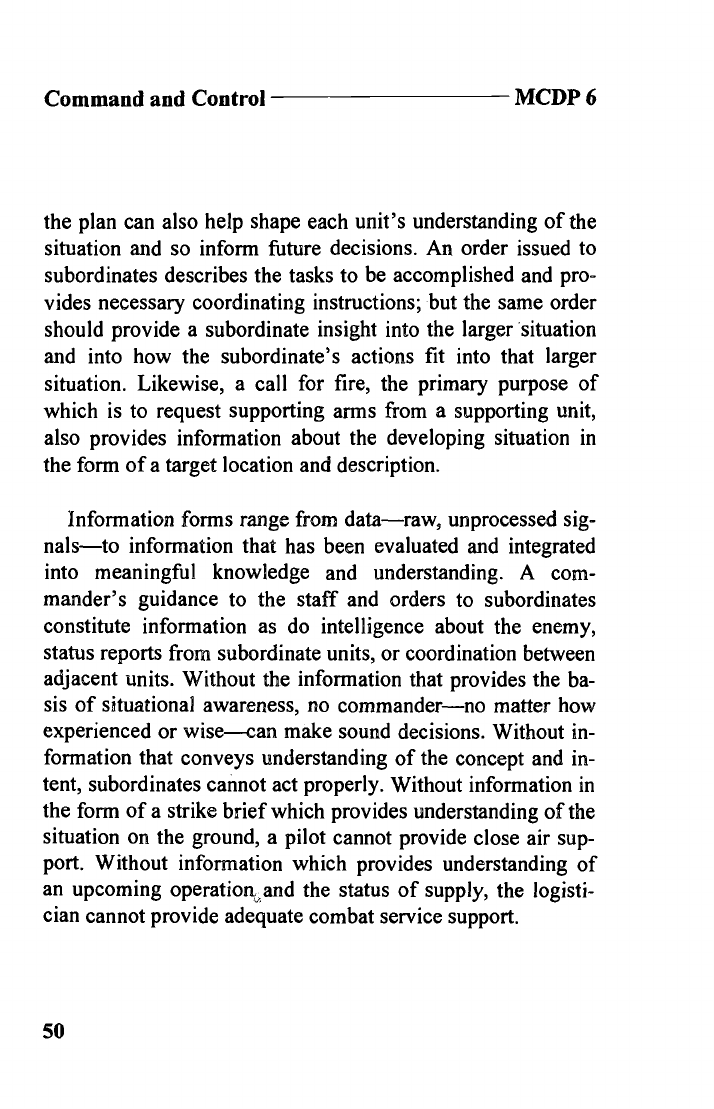
Command and Control
MCDP 6
the plan can also help shape each unit's understanding of the
situation and so inform future decisions. An order issued to
subordinates describes the tasks to be accomplished and pro-
vides necessary coordinating instructions; but the same order
should provide a subordinate insight into the larger situation
and into how the subordinate's actions fit into that larger
situation. Likewise, a call for fire, the primary purpose of
which is to request supporting arms from a supporting unit,
also provides information about the developing situation in
the form of a target location and description.
Information forms range from data—raw, unprocessed sig-
nals—to information that has been evaluated and integrated
into meaningful knowledge and understanding. A com-
mander's guidance to the staff and orders to subordinates
constitute information as do intelligence about the enemy,
status reports from subordinate units, or coordination between
adjacent units. Without the information that provides the ba-
sis of situational awareness, no commander—no matter how
experienced or wise—can make sound decisions. Without in-
formation that conveys understanding of the concept and in-
tent, subordinates cannot act properly. Without information in
the form of a strike brief which provides understanding of the
situation on the ground, a pilot cannot provide close air sup-
port. Without information which provides understanding of
an upcoming operation,and the status of supply, the logisti-
cian cannot provide adequate combat service support.
50

MCDP 6
The Nature of Command and Control
Effective command and control is not simply a matter of
generating enough information. Most information is not im-
portant or even relevant. Much is unusable given the time
available. More is inaccurate, and some can actually be mis-
leading. Given information-gathering capabilities today, there
is the distinct danger of overwhelming commanders with
more information than they can possibly assimilate. In other
words, too much information is as bad as too little—and
probably just as likely to occur. Some kinds of information
can be counterproductive—information which misleads us,
which spreads panic, or which leads to overcontrol. Informa-
tion is valuable only insofar as it contributes to effective deci-
sions and actions. The critical thing is not the amount of
information, but key elements of information, available when
needed and in a useful form, which improve the commander's
awareness of the situation and ability to act.
The final element of command and control is the command
and control support structure" which aids the people who
create, disseminate, and use information. It includes the or
ganizations, procedures, equipment, facilities, training, educa-
tion, and doctrine which support command and control. It is
important to note that although we often refer to families of
hardware as "systems" themselves, the command and control
system is much more than simply equipment. High-quality
equipment and advanced technology do not guarantee effec-
tive command and control.
Effective command and control
starts with qualified people and an effective guiding philoso-
phy. We must recognize that the components of the command
51
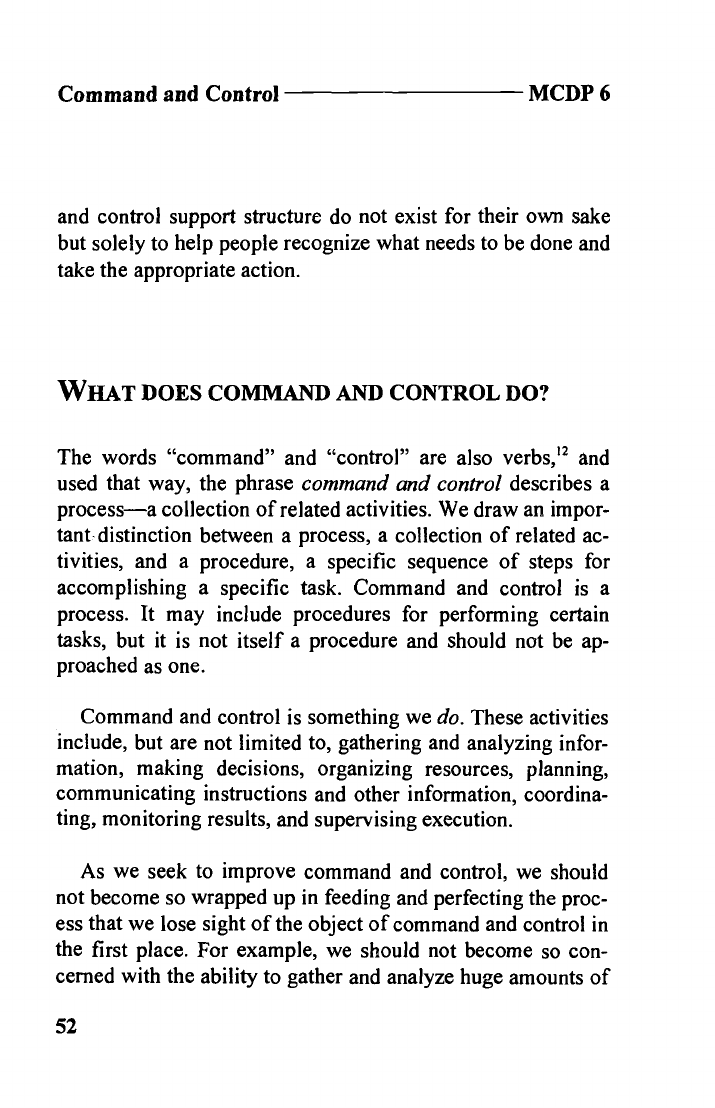
Command and Control
MCDP 6
and control support structure do not exist for their own sake
but solely to help people recognize what needs to be done and
take the appropriate action.
WHAT DOES COMMM4D AND CONTROL DO?
The words "command" and "control" are also verbs,'2 and
used that way, the phrase command and control describes a
process—a collection of related activities. We draw an impor-
tant-distinction between a process, a collection of related ac-
tivities, and a procedure, a specific sequence of steps for
accomplishing a specific task. Command and control is a
process. It may include procedures for performing certain
tasks, but it is not itself a procedure and should not be ap-
proached as one.
Command and control is something we do. These activities
include, but are not limited to, gathering and analyzing infor-
mation, making decisions, organizing resources, planning,
communicating instructions and other information, coordina-
ting, monitoring results, and supervising execution.
As we seek to improve command and control, we should
not become so wrapped up in feeding and perfecting the proc-
ess that we lose sight of the object of command and control in
the first place. For example, we should not become so con-
cerned with the ability to gather and analyze huge amounts of
52
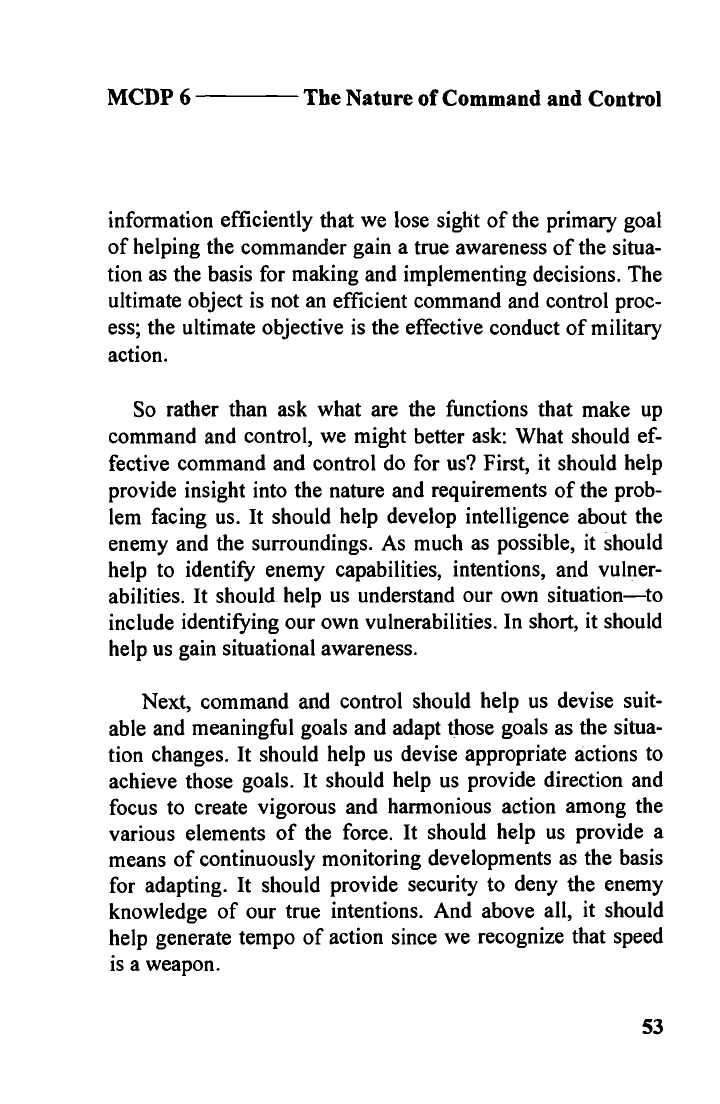
MCDP 6
The Nature of Command and Control
information efficiently that we lose sight of the primary goal
of helping the commander gain a true awareness of the situa-
tion as the basis for making and implementing decisions. The
ultimate object is not an efficient command and control proc-
ess; the ultimate objective is the effective conduct of military
action.
So rather than ask what are the functions that make up
command and control, we might better ask: What should ef-
fective command and control do for us? First, it should help
provide insight into the nature and requirements of the prob-
lem facing us. It should help develop intelligence about the
enemy and the surroundings. As much as possible, it should
help to identify enemy capabilities, intentions, and vulner-
abilities. It should help us understand our own situation—to
include identifying our own vulnerabilities. In short, it should
help us gain situational awareness.
Next, command and control should help us devise suit-
able and meaningful goals and adapt those goals as the situa-
tion changes. It should help us devise appropriate actions to
achieve those goals. It should help us provide direction and
focus to create vigorous and harmonious action among the
various elements of the force. It should help us provide a
means of continuously monitoring developments as the basis
for adapting. It should provide security to deny the enemy
knowledge of our true intentions. And above all,
it should
help generate tempo of action since we recognize that speed
is a weapon.
53
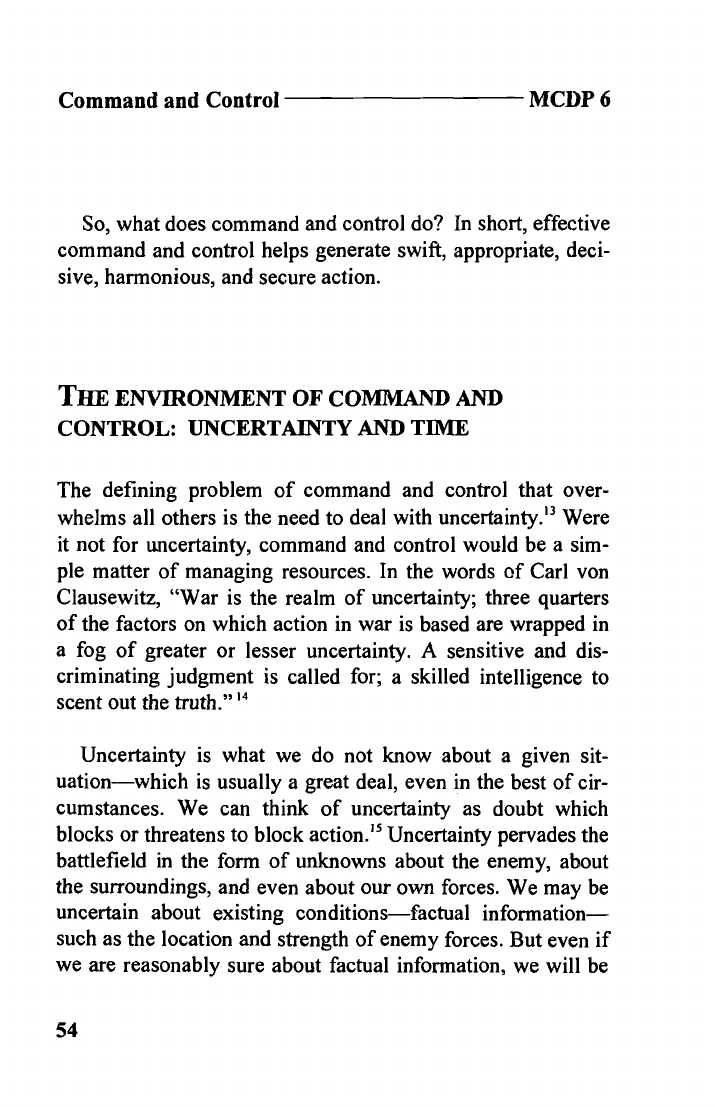
Command and Control
MCDP 6
So, what does command and control do? In short, effective
command and control helps generate swift, appropriate, deci-
sive, harmonious, and secure action.
Tm ENVIRONMENT OF COMMAND AND
CONTROL: UNCERTAINTY AND TIME
The defining problem of command and control that over-
whelms all others is the need to deal with uncertainty.'3 Were
it not for uncertainty, command and control would be a sim-
ple matter of managing resources. In the words of Carl von
Clausewitz, "War is the realm of uncertainty; three quarters
of the factors on which action in war is based are wrapped in
a fog of greater or lesser uncertainty. A sensitive and dis-
criminating judgment is called for; a skilled intelligence to
scent out the truth."4
Uncertainty is what we do not know about a given sit-
uation—which is usually a great deal, even in the best of cir-
cumstances. We can think of uncertainty as doubt which
blocks or threatens to block action.'5 Uncertainty pervades the
battlefield in the form of unknowns about the enemy, about
the surroundings, and even about our own forces. We may be
uncertain about existing conditions—factual information—
such as the location and strength of enemy forces. But even if
we are reasonably sure about factual information, we will be
54
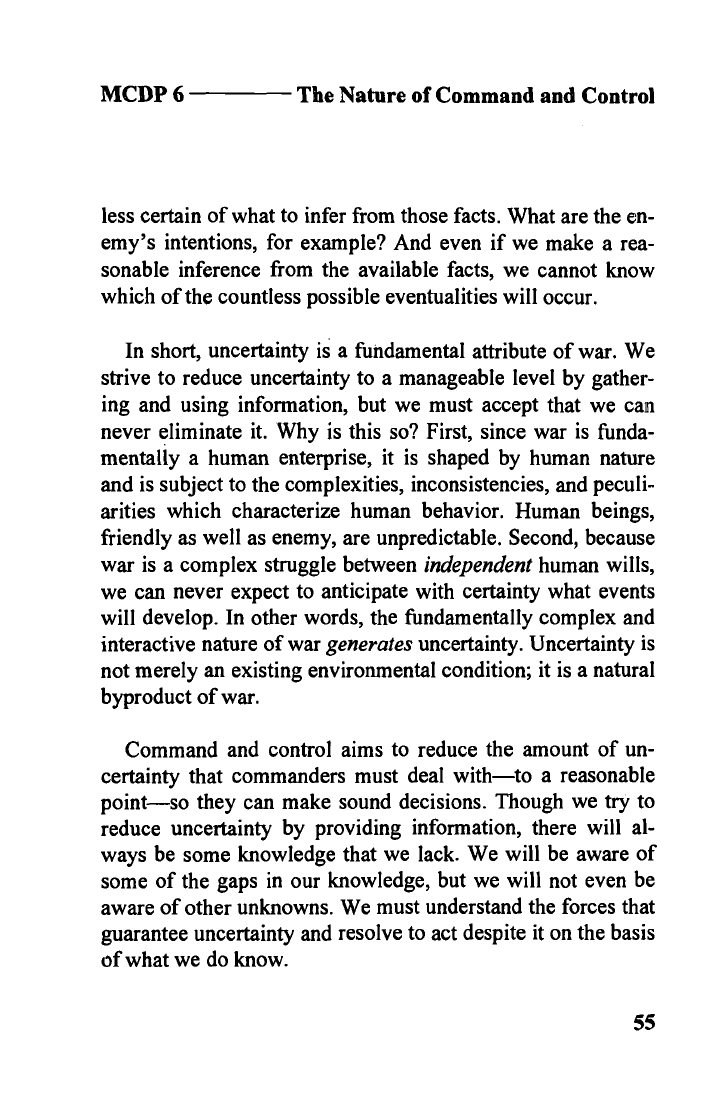
MCDP 6
The Nature of Command and Control
less certain of what to infer from those facts. What are the en-
emy's intentions, for example? And even if we make a rea-
sonable inference from the available facts, we cannot know
which of the countless possible eventualities will occur.
In short, uncertainty is a fundamental attribute of war. We
strive to reduce uncertainty to a manageable level by gather-
ing and using information, but we must accept that we can
never eliminate it. Why is this so? First, since war is funda-
mentally a human enterprise, it is shaped by human nature
and is subject to the complexities, inconsistencies, and peculi-
arities which characterize human behavior. Human beings,
friendly as well as enemy, are unpredictable. Second, because
war is a complex struggle between independent human wills,
we can never expect to anticipate with certainty what events
will develop. In other words, the fundamentally complex and
interactive nature of war generates uncertainty. Uncertainty is
not merely an existing enviromnental condition; it is a natural
byproduct of war.
Command and control aims to reduce the amount of un-
certainty that commanders must deal with—to a reasonable
point—so they can make sound decisions. Though we try to
reduce uncertainty by providing information, there will al-
ways be some knowledge that we lack. We will be aware of
some of the gaps in our knowledge, but we will not even be
aware of other unknowns. We must understand the forces that
guarantee uncertainty and resolve to act despite it on the basis
of what we do know.
55

Command and Control
MCDP 6
It is important to note that certainty is a function of knowl-
edge and understanding and not merely of data. Although
they are clearly related—they are all forms of information, as
we will discuss—the distinctions among them are important.
Data serve as the raw material for knowledge and understand-
ing. Knowledge and understanding result when human beings
add meaning to data. Properly provided and processed, data
can lead to knowledge and understanding, but the terms are
not synonymous. Paradoxically, not all data lead to knowl-
edge and understanding; some may even hamper the gaining
of knowledge and understanding. The essential lesson from
this distinction is that decreased uncertainty is not simply a
matter of increased information flow. More important are the
quality of the information and the abilities of the person using
it—and the willingness and ability to make decisions in the
face of uncertainty.
The second main element that affects command and con-
trol, second only to uncertainty in order of importance, is the
factor of time. Theoretically, we can always reduce uncer-
tainty by gaining more knowledge of the situation (accepting
that there is some information we can never gain). The basic
dilemma is that to gain and process information takes time.
This creates three related problems. First, the knowledge we
gain in war is perishable: as we take the time to gain new in-
formation, information already gained is becoming obsolete.
Second, since war is a contest between opposing wills, time
itself is a precious commodity used by both sides. While we
strive to get information about a particular situation, the
56

MCDP 6
The Nature of Command and Control
enemy may already be acting—and changing the situation in
the process. (Of course, the enemy faces the same problem in
relation to us.) And third, the rapid tempo of modern opera-
tions limits the amount of information that can be gathered,
processed, and assimilated in time to be of use. Command
and control thus becomes a tense race against time. So the
second absolute requirement in any command and control
system is to be fast—at least faster than the enemy.
The resulting tension between coping with uncertainty and
racing against time presents the fundamental challenge of
command and control. This is perhaps the single most impor-
tant point to take from this chapter. It is also important to rec-
ognize that the enemy faces the same problems—and the
object is to achieve some relative advantage. Although there
is no easy answer to this problem, the successful commander
must find a solution, as we will discuss.
CorvI1iil
AND
CONTROL IN THE
INFORMATION AGE
Many of the factors that influence command and control are
timeless—the nature of war and of human beings and the twin
problems of uncertainty and time, for example. On the other
hand, numerous factors are peculiar to a particular age or at
least dependent on the characteristics of that age. As war has
57

Command and Control
MCDP 6
evolved through the ages, so has command and control. In
general, as war has become increasingly complicated, so have
the means of command and control. What can we conclude
about the environment in which command and control must
function today and in the foreseeable future?
The prevailing characteristics of the information age are
variety and rapid, ongoing change. An unstabLe and change-
able world situation can lead to countless varieties of conflict
requiring peacekeeping operations on the one extreme to gen-
eral war on the other. Since we cannot predict when and
where the next crisis will arise or what form it will take, our
command and control must function effectively in any envi-
ronment.
Technological improvements in mobility, range, lethality,
and information-gathering continue to compress time and
space, forcing higher operating tempos and creating a greater
demand for information. Military forces may move more
quickly over greater distances than ever before, engaging the
enemy at greater ranges than ever before. The consequence of
this is fluid, rapidly changing military situations. The more
quickly the situation changes, the greater the need for con-
tinuously updated information and the greater the strain on
command and control. Future conflict will require military
forces able to adapt quickly to a variety of unexpected cir-
cumstances.
58

MCDP 6
The Nature of Command and Control
The increasing lethality and range of weapons over time
has compelled military forces to disperse in order to survive,
similarly stretching the limits of command and control. Mili-
tary forces are bigger and more complex than ever before,
consisting of a greater number and variety of specialized or-
ganizations and weapons. As a result, modern military forces
require ever greater amounts of information in order to oper-
ate and sustain themselves, even in a peacetime routine.
In the current age, technology is increasingly important to
command and control. Advances in technology provide capa-
bilities never before dreamed of. But technology is not with-
out its dangers, namely the overreliance on equipment on the
one hand and the failure to fully exploit the latest capabilities
on the other. It is tempting, but a mistake, to believe that tech-
nology will solve all the problems of command and control.
Many hopes of a decisive technological leap forward have
been dashed by unexpected complications and side effects or
by the inevitable rise of effective countermeasures. Moreover,
used unwisely, technology can be part of the problem, con-
tributing to information overload and feeding the dangerous
illusion that certainty and precision in war are not only desir-
able, but attainable.
In this complicated age, command and control is espe-
cially vulnerable and not just to the physical destruction of
facilities and personnel by enemy attack. As the command
and control system becomes increasingly complex, it likewise
becomes increasingly vulnerable to disruption, monitoring,
59
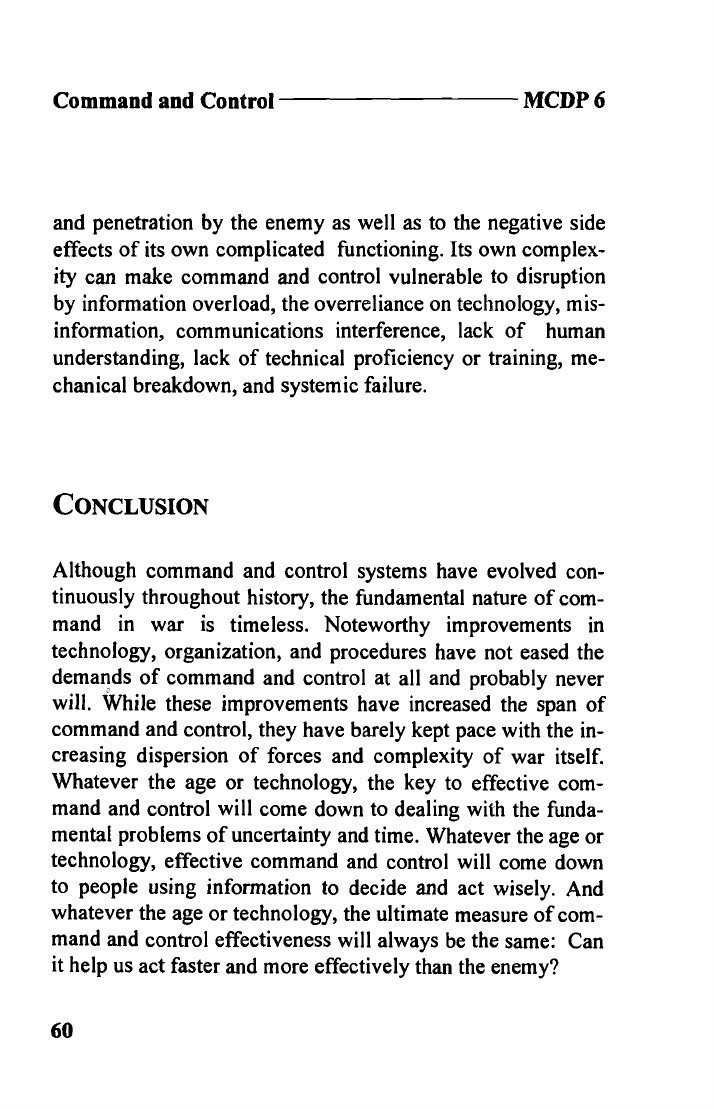
Command and Control
MCDP 6
and penetration by the enemy as well as to the negative side
effects of its own complicated functioning. Its own complex-
ity can make command and control vulnerable to disruption
by information overload, the overreliance on technology, mis-
information, communications interference, lack of human
understanding, lack of technical proficiency or training, me-
chanical breakdown, and systemic failure.
CONCLUSION
Although command and control systems have evolved con-
tinuously throughout history, the fundamental nature of com-
mand in war is
timeless. Noteworthy improvements
in
technology, organization, and procedures have not eased the
demands of command and control at all and probably never
will. While these improvements have increased the span of
command and control, they have barely kept pace with the in-
creasing dispersion of forces and complexity of war itself.
Whatever the age or technology, the key to effective com-
mand and control will come down to dealing with the funda-
mental problems of uncertainty and time. Whatever the age or
technology, effective command and control will come down
to people using information to decide and act wisely. And
whatever the age or technology, the ultimate measure of com-
mand and control effectiveness will always be the same: Can
it help us act faster and more effectively than the enemy?
60
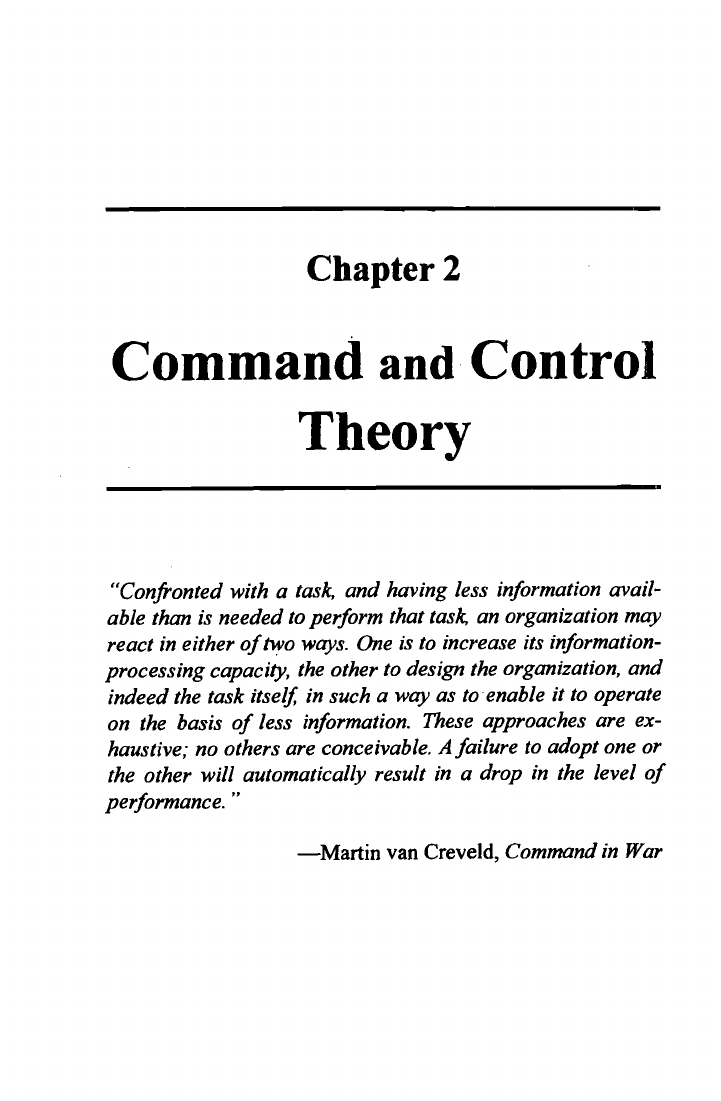
Chapter 2
Command and Control
Theory
"Confronted with a task, and having less information avail-
able than is needed to perform that task, an organization may
react in either of two ways, One is to increase its information-
processing capacity, the other to design the organization, and
indeed the task itself in such a way as to enable it to operate
on the basis of less information. These approaches are ex-
haustive; no others are conceivable. A failure to adopt one or
the other will automatically result in a drop in the level of
performance."
—Martin van Creveld, Command in War


MCDP 6
Command and Control Theory
H
aving reached a common understanding of the nature of
command and control, we turn to developing a theory
about the command and control process that will in turn serve
as the basis for creating an effective command and control
system.
POINT OF DEPARTURE: THE OODA LOOP
Our study of command and control theory starts with a simple
model of the command and control process known as the
OODA loop.' The OODA loop applies to any two-sided con-
flict, whether the antagonists are individuals in hand-to-hand
combat or large military formations. OODA is an acronym
for observation-orientation-decision-action, which describes
the basic sequence of the command and control process. (See
figure 2.)
When engaged in conflict, we first observe the
situation—that is, we take in information about our own
status, our surroundings, and our enemy. Sometimes we ac-
tively seek the information; sometimes it is thrust upon us.
Having observed the situation, we next orient to it—we make
certain estimates, assumptions, analyses, and judgments about
the situation in order to create a cohesive mental image. In
other words, we try to figure out what the situation means to
us. Based on our orientation, we decide what to do—whether
that decision takes the form of an immediate reaction or a de-
liberate plan. Then we put the decision into action. This in-
63

Command and Control
MCDP 6
ciudes disseminating
the decision, supervising to ensure
proper execution, and monitoring results through feedback,
which takes us full circle to the observation phase. Having
acted, we have changed the situation, and so the cycle begins
again. It is worth noting that, in any organization with multi-
pie decision makers, multiple OODA loops spin simultane-
ously, although not necessarily at the same speed, as
commanders exercise command and control at their own level
and locale.
64
Figure 2. The command and control process:
The OODA loop.

MCDP 6
Command and Control Theory
Importantly, the OODA loop reflects how command and
control is a continuous, cyclical process. In any conflict, the
antagonist who can consistently and effectively cycle through
the OODA loop faster—who can maintain a higher tempo of
actions—gains an ever-increasing advantage with each cycle.
With each reaction, the slower antagonist falls farther and far-
ther behind and becomes increasingly unable to cope with the
deteriorating situation. With each cycle, the slower antago-
nist's actions become less relevant to the true situation. Com-
mand and control itself deteriorates.
The lesson of the OODA loop is the importance of generat-
ing tempo in command and control. In other words, speed is
an essential element of effective command and control. Speed
in command and control means shortening the time needed to
make decisions, plan, coordinate, and communicate. Since
war is competitive, it is not absolute speed that matters, but
speed relative to the enemy: the aim is to be faster than our
enemy, which means interfering with the enemy's command
and control as well as streamlining our own. The speed differ-
ential does not necessarily have to be a large one: a small ad-
vantage exploited repeatedly can quickly lead to decisive
results. We should recognize that the ability and desire to
generate a higher operational tempo does not negate the will-
ingness to bide time when the situation calls for patience. The
aim is not merely rapid action, but also meaningful action.
65

Command and Control
MCDP 6
Tm INFORMATION
HIERARCHY
We
use the term information generically to refer to all manner
of descriptions or representations from raw signals on the one
hand to knowledge and understanding on the other. But it is
important to recognize that there are actually four different
classes of information. We must understand the differences
between these classes because they are of different value in
supporting command and control. (See figure 3.) We must
also understand what happens to information as it moves be-
tween levels on the hierarchy.2
Raw data comprise the lowest class of information and in-
clude raw signals picked up by a sensor of any kind (a radio
antenna, an eyeball, a radar, a satellite) or communicated be-
tween any kind of nodes in a system. Data are bits and bytes
transferred between computers, individual transmissions sent
by telephone or radio or facsimile, or a piece of unprocessed
film. In other words, raw data are signals which have not been
processed, correlated, integrated, evaluated, or interpreted in
any way. This class of information is rarely of much use until
transformed in some way to give it some sort of meaning.
The next class is data that have been processed into or have
been displayed in a form that is understandable to the people
66

MCDP 6
Command and Control Theory
TUNDERSTANDING
I
examples.
Situational
Synthesized, visualized
awareness
Coup doeil
Gives greater
situational
meaning to
I
KNOWLEDGE
i
Example:
Intelligence
Evaluated, integrated, analyzed
report
A
Gives some
meaning to
IE
I
I )I
IOU
I PROCESSED DATA I
Examples:
Situation report
Formatted, plotted,
Call for fire
translated, correlated
Putsin
understandable
I I
form
Il
101
I'— U
Example:
I
RAW DATA
I
Encrypted
Raw signals
transmission
Figure 3. The information hierarchy.
67
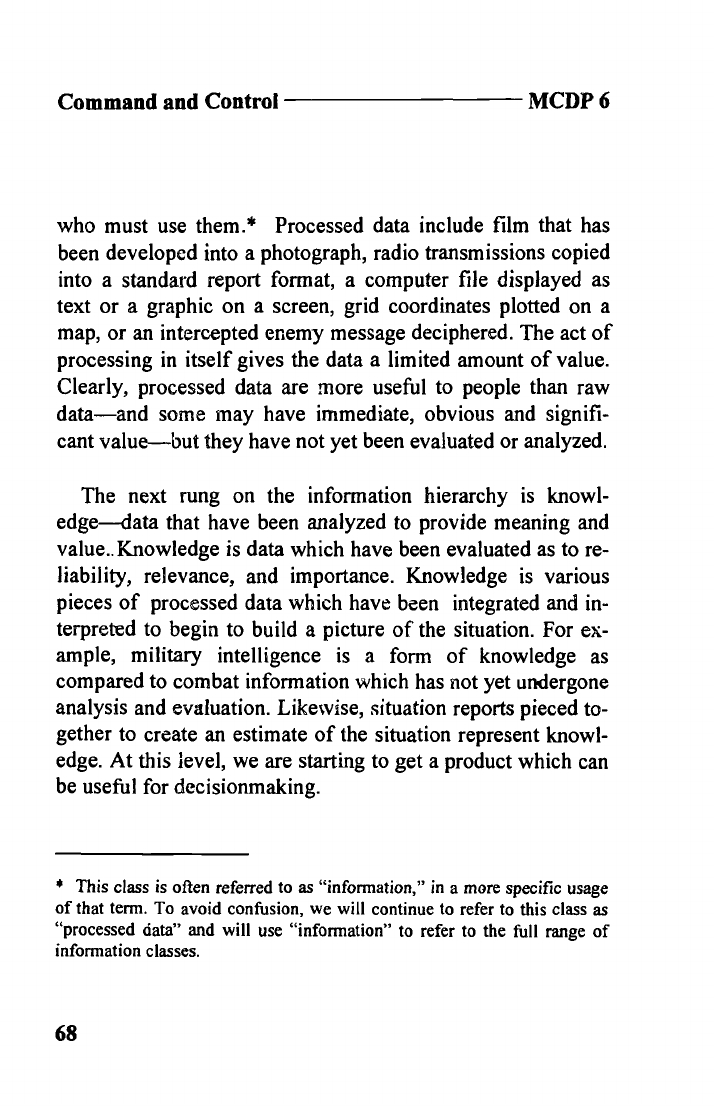
Command and Control
MCDP 6
who must use them.*
Processed data include film that has
been developed into a photograph, radio transmissions copied
into a standard report format, a computer file displayed as
text or a graphic on a screen, grid coordinates plotted on a
map, or an intercepted enemy message deciphered. The act of
processing in itself gives the data a limited amount of value.
Clearly, processed data are more useful to people than raw
data—and some may have immediate, obvious and signifi-
cant value—but they have not yet been evaluated or analyzed.
The next rung on the information hierarchy is knowl-
edge—data that have been analyzed to provide meaning and
value.. Knowledge is data which have been evaluated as to re-
liability, relevance, and importance. Knowledge is various
pieces of processed data which have been integrated and in-
terpreted to begin to build a picture of the situation. For ex-
ample, military intelligence
is
a form of knowledge as
compared to combat information which has not yet uixlergone
analysis and evaluation. Likewise, situation reports pieced to-
gether to create an estimate of the situation represent knowl-
edge. At this level, we are starting to get a product which can
be useful for decisionmaking.
*
This class is
often referred to as "information," in a more specific usage
of
that term. To avoid confusion, we will continue to refer to this class as
"processed data" and will use "information" to refer to the full range of
information classes.
68
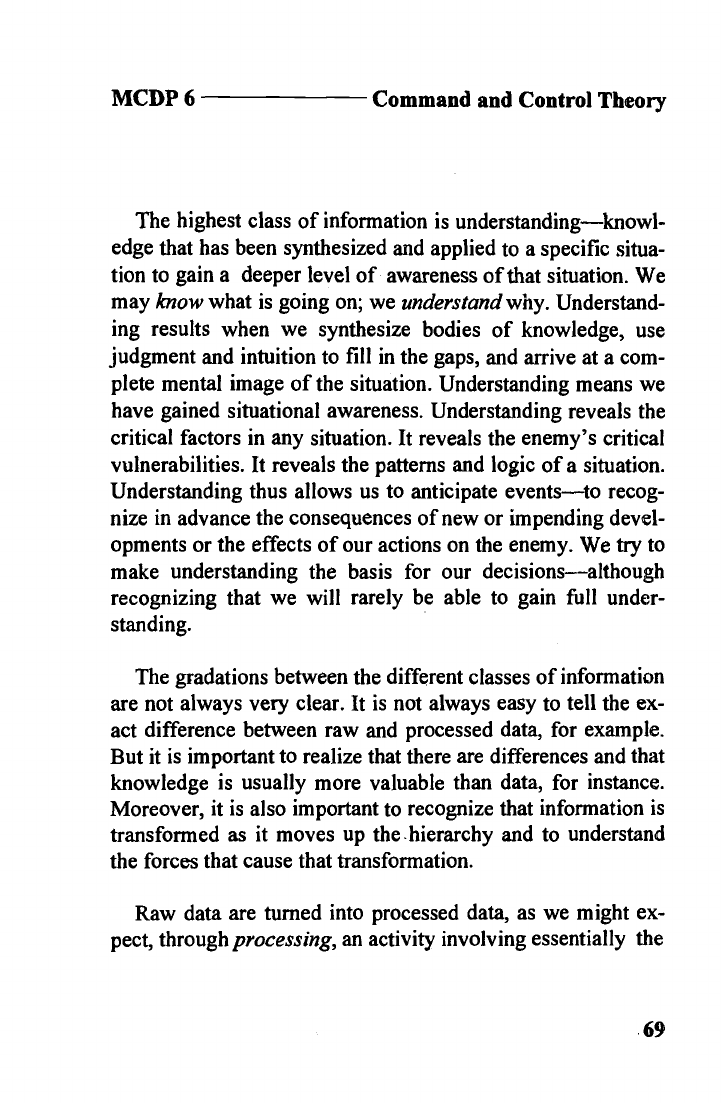
MCDP 6
Command and Control Theory
The highest class of information is understanding—knowl-
edge that has been synthesized and applied to a specific situa-
tion to gain a deeper level of awareness of that situation. We
may know what is going on; we understand why. Understand-
ing results when we synthesize bodies of knowledge, use
judgment and intuition to fill in the gaps, and arrive at a com-
plete mental image of the situation. Understanding means we
have gained situational awareness. Understanding reveals the
critical factors in any situation. It reveals the enemy's critical
vulnerabilities. It reveals the patterns and logic of a situation.
Understanding thus allows us to anticipate events—to recog-
nize in advance the consequences of new or impending devel-
opments or the effects of our actions on the enemy. We try to
make understanding the basis for our decisions—although
recognizing that we will rarely be able to gain full under-
standing.
The gradations between the different classes of information
are not always very clear. It is not always easy to tell the ex-
act difference between raw and processed data, for example.
But it is important to realize that there are differences and that
knowledge is usually more valuable than data, for instance.
Moreover, it is also important to recognize that information is
transformed as it moves up the hierarchy and to understand
the forces that cause that transformation.
Raw data are turned into processed data, as we might ex-
pect, through processing, an activity involving essentially the
.69
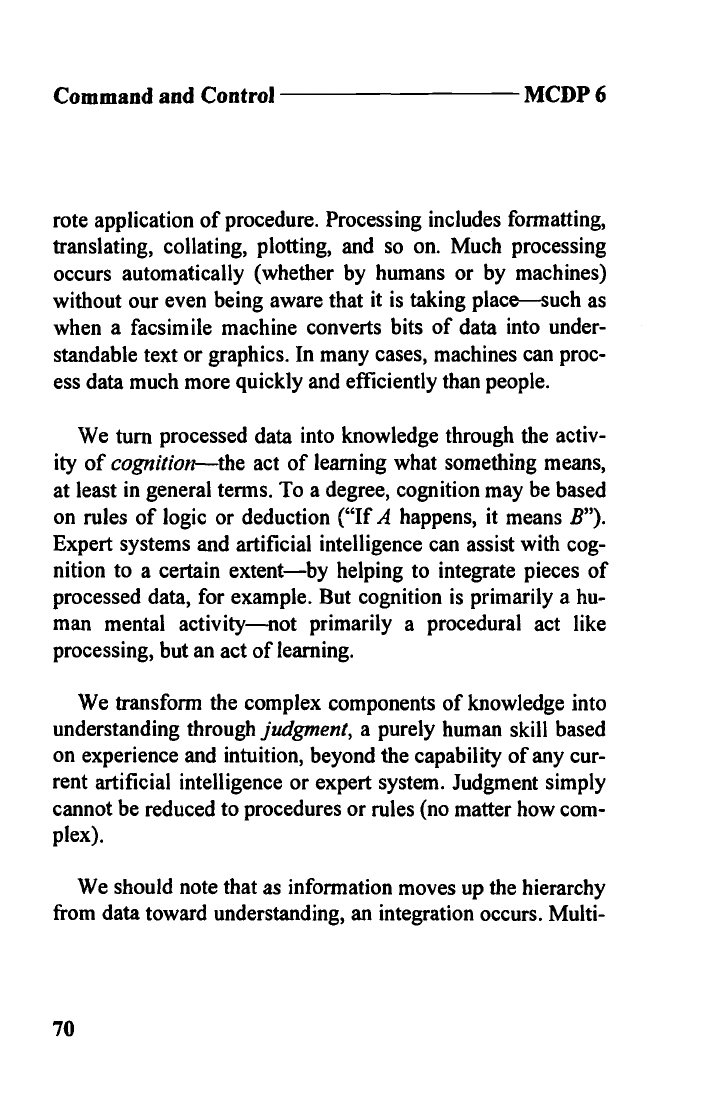
Command and Control
MCDP 6
rote application of procedure. Processing includes formatting,
translating, collating, plotting, and so on. Much processing
occurs automatically (whether by humans or by machines)
without our even being aware that it is taking place—such as
when a facsimile machine converts bits of data into under-
standable text or graphics. In many cases, machines can proc-
ess data much more quickly and efficiently than people.
We turn processed data into knowledge through the activ-
ity of cognition—the
act of learning what something means,
at least in general terms. To a degree, cognition may be based
on rules of logic or deduction ("If A happens, it means B").
Expert systems and artificial intelligence can assist with cog-
nition to a certain extent—by helping to integrate pieces of
processed data, for example. But cognition is primarily a hu-
man mental activity—not primarily a procedural act like
processing, but an act of learning.
We transform the complex components of knowledge into
understanding through judgment, a
purely human skill based
on experience and intuition, beyond the capability of any cur-
rent artificial intelligence or expert system. Judgment simply
cannot be reduced to procedures or rules (no matter how com-
plex).
We should note that as information moves up the hierarchy
from data toward understanding, an integration occurs. Multi-
70
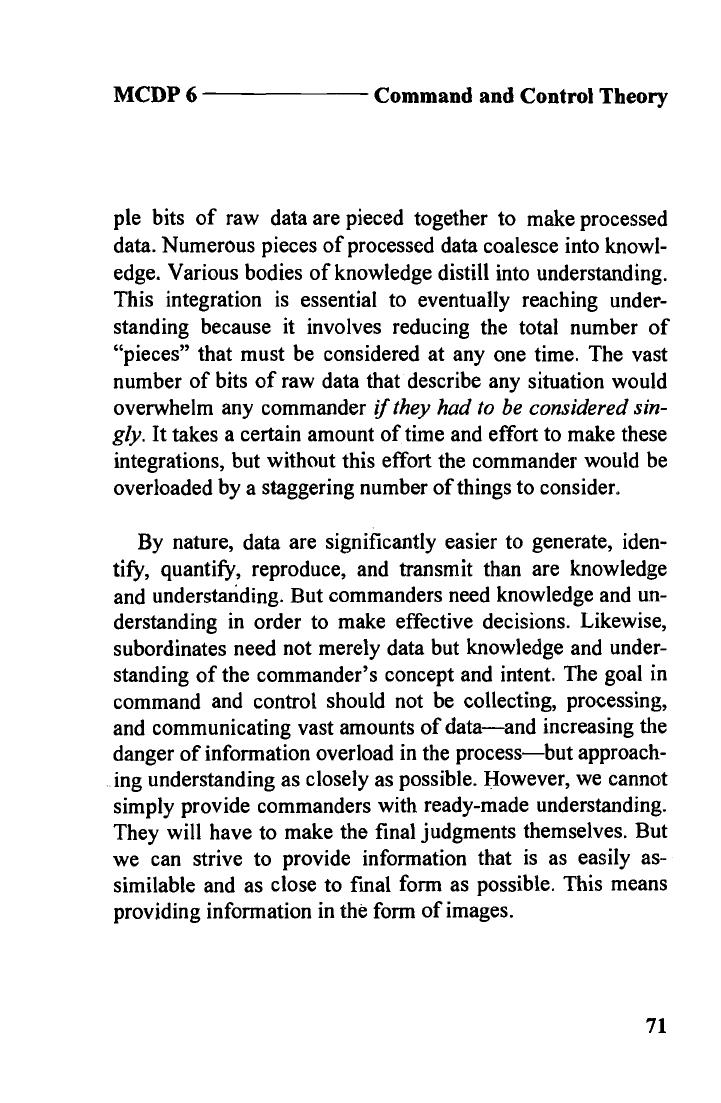
MCDP 6
Command and Control Theory
pie bits of raw data are pieced together to make processed
data. Numerous pieces of processed data coalesce into knowl-
edge. Various bodies of knowledge distill into understanding.
This integration is essential to eventually reaching under-
standing because it involves reducing the total number of
"pieces" that must be considered at any one time. The vast
number of bits of raw data that describe any situation would
overwhelm any commander f
they had to be considered sin-
gly. It takes a certain amount of time and effort to make these
integrations, but without this effort the commander would be
overloaded by a staggering number of things to consider.
By nature, data are significantly easier to generate, iden-
tify, quantify, reproduce, and transmit than are knowledge
and understai ding. But commanders need knowledge and un-
derstanding in order to make effective decisions. Likewise,
subordinates need not merely data but knowledge and under-
standing of the commander's concept and intent. The goal in
command and control should not be collecting, processing,
and communicating vast amounts of data—and increasing the
danger of information overload in the process—but approach-
ing understanding as closely as possible. However, we cannot
simply provide commanders with ready-made understanding.
They will have to make the final judgments themselves. But
we can strive to provide information that is as easily as-
similable and as close to final form as possible. This means
providing information in the form of images.
71
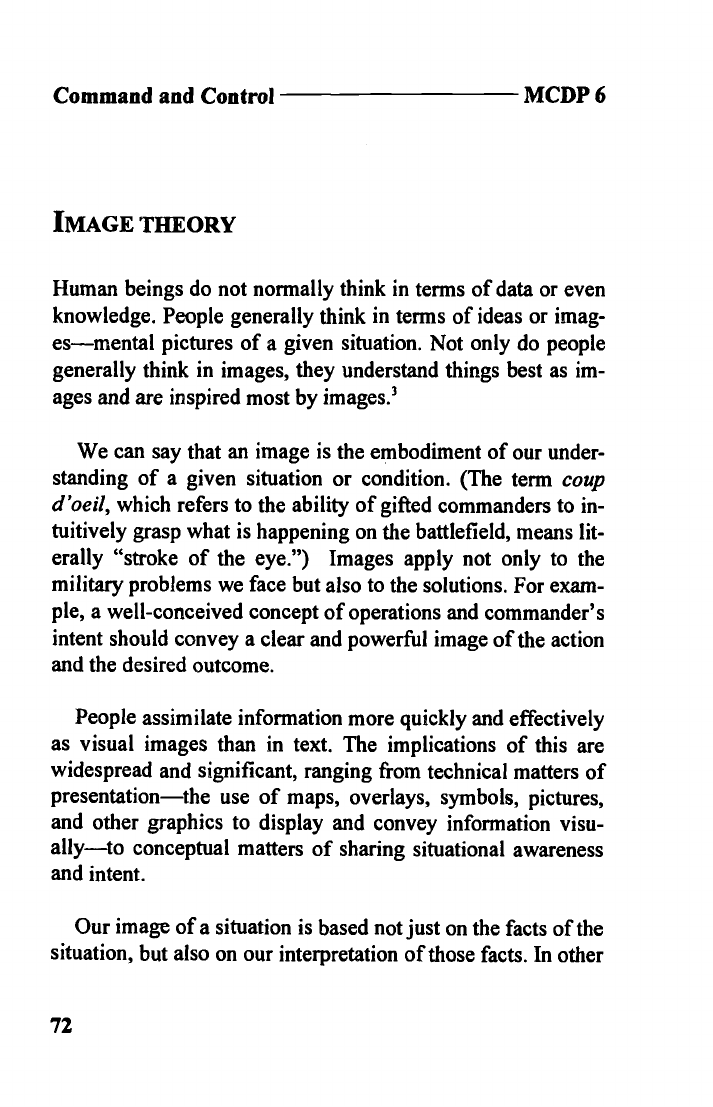
Command and Control
MCDP 6
IMAGE THEORY
Human beings do not normally think in terms of data or even
knowledge. People generally think in terms of ideas or imag-
es—mental pictures of a given situation. Not only do people
generally think in images, they understand things best as im-
ages and are inspired most by images.3
We can say that an image is the embodiment of our under-
standing of a given situation or condition. (The term coup
d'oeil, which refers to the ability of gifted commanders to in-
tuitively grasp what is happening on the battlefield, means lit-
erally "stroke of the eye.")
Images apply not only to the
military problems we face but also to the solutions. For exam-
ple, a well-conceived concept of operations and commander's
intent should convey a clear and powerful image of the action
and the desired outcome.
People assimilate information more quickly and effectively
as visual images than in text. The implications of this are
widespread and significant, ranging from technical matters of
presentation—the use of maps, overlays, symbols, pictures,
and other graphics to display and convey information visu-
ally—to conceptual matters of sharing situational awareness
and intent.
Our image of a situation is based not just on the facts of the
situation, but also on our interpretation of those facts. In other
72
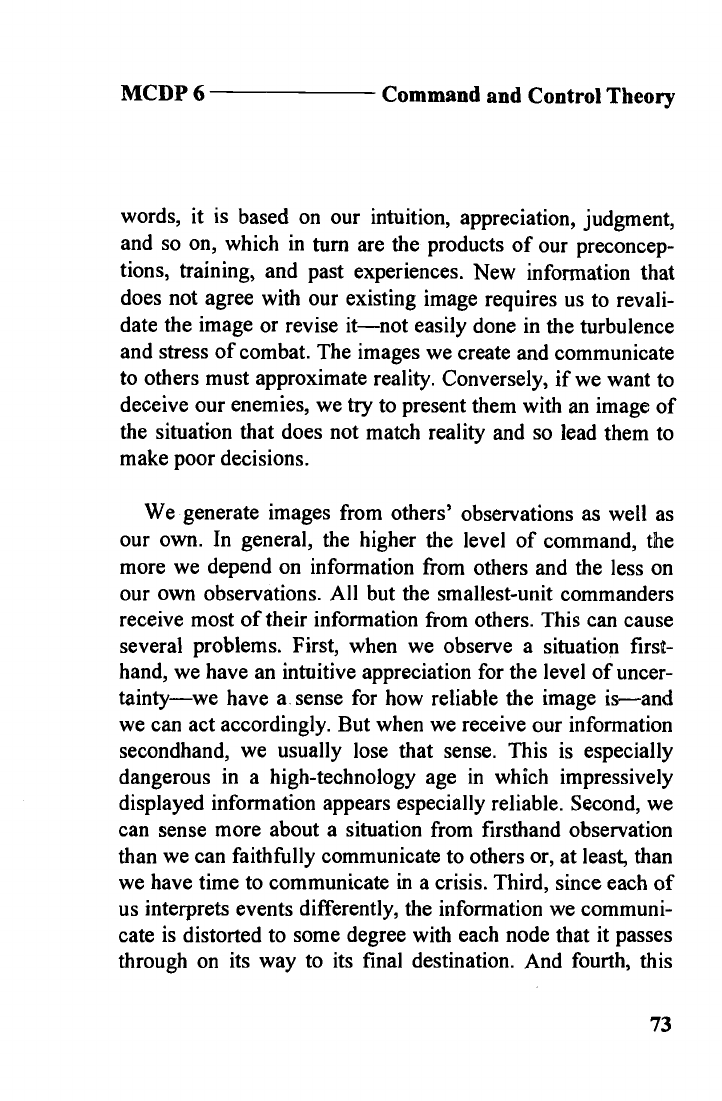
MCDP 6
Command and Control Theory
words, it is based on our intuition, appreciation, judgment,
and so on, which in turn are the products of our preconcep-
tions, training, and past experiences. New information that
does not agree with our existing image requires us to revali-
date the image or revise it—not easily done in the turbulence
and stress of combat. The images we create and communicate
to others must approximate reality. Conversely, if we want to
deceive our enemies, we try to present them with an image of
the situation that does not match reality and so lead them to
make poor decisions.
We generate images from others' observations as well as
our own. In general, the higher the level of command, the
more we depend on information from others and the less on
our own observations. All but the smallest-unit commanders
receive most of their information from others. This can cause
several problems. First, when we observe a situation first-
hand, we have an intuitive appreciation for the level of uncer-
tainty—we have a sense for how reliable the image is—and
we can act accordingly. But when we receive our information
secondhand, we usually lose that sense. This is especially
dangerous in a high-technology age in which impressively
displayed information appears especially reliable. Second, we
can sense more about a situation from firsthand observation
than we can faithfully communicate to others or, at least, than
we have time to communicate in a crisis. Third, since each of
us interprets events differently, the information we communi-
cate is distorted to some degree with each node that it passes
through on its way to its final destination. And fourth, this
73
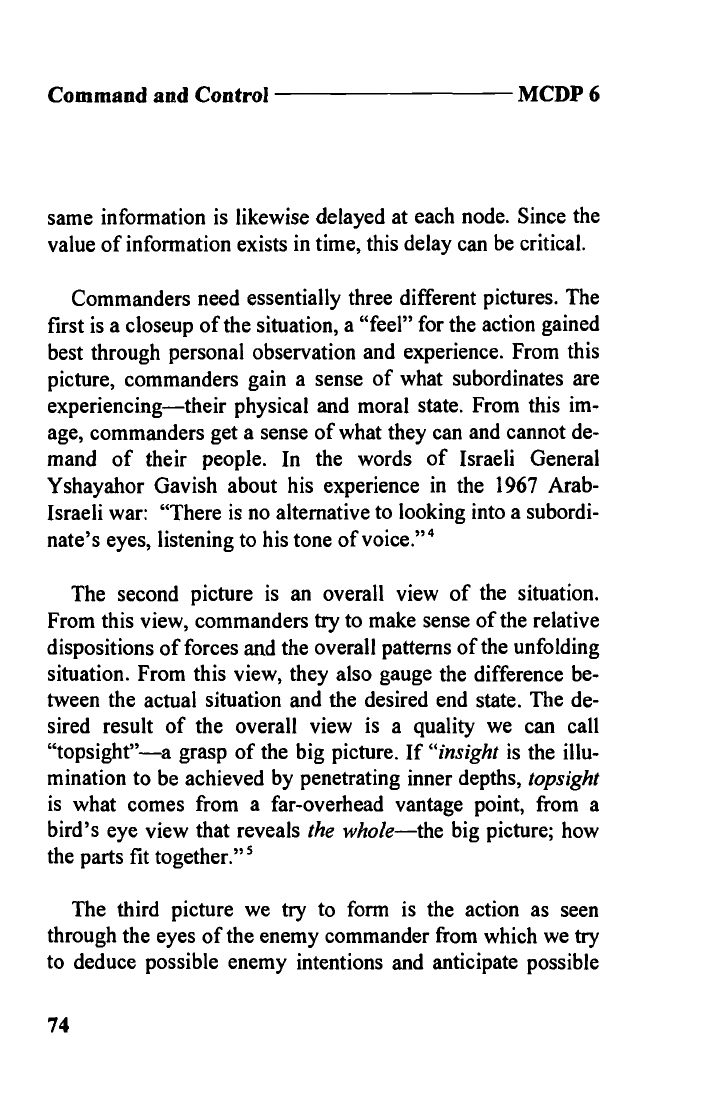
Command and Control
MCDP 6
same information is likewise delayed at each node. Since the
value of information exists in time, this delay can be critical.
Commanders need essentially three different pictures. The
first is a closeup of the situation, a "feel" for the action gained
best through personal observation and experience. From this
picture, commanders gain a sense of what subordinates are
experiencing—their physical and moral state. From this im-
age, commanders get a sense of what they can and cannot de-
mand of their people. In the words of Israeli General
Yshayahor Gavish about his experience in the 1967 Arab-
Israeli war: "There is no alternative to looking into a subordi-
nate's eyes, listening to his tone of voice."4
The second picture is an overall view of the situation.
From this view, commanders try to make sense of the relative
dispositions of forces and the overall patterns of the unfolding
situation. From this view, they also gauge the difference be-
tween the actual situation and the desired end state. The de-
sired result of the overall view is a quality we can call
"topsight"—a grasp of the big picture. If "insight is the illu-
mination to be achieved by penetrating inner depths, topsight
is what comes from a far-overhead vantage point, from a
bird's eye view that reveals the whole—the big picture; how
the parts fit together."5
The third picture we try to form is the action as seen
through the eyes of the enemy commander from which we try
to deduce possible enemy intentions and anticipate possible
74

MCDP 6
Command and Control Theory
enemy moves. Of the three pictures, the first is clearly the
most detailed but usually offers a very narrow field of vision.
Commanders who focus only on this image risk losing sight
of the big picture. The second picture provides an overall im-
age but lacks critical detail—just as a situation map does not
capture more than a broad impression of the reality of events
on the battlefield. Commanders who focus only on this image
risk being out of touch with reality. The third picture is
largely a mental exercise limited by the fact that we can never
be sure of what our enemy is up to.
Squad leaders or fighter pilots may simultaneously be able
to generate all three images largely from their own observa-
tions. Higher commanders, however, feel a tension between
satisf'ing the need for both the closeup and overall imag-
es—the former best satisfied by personal observation at the
front and the latter probably best satisfied from a more distant
vantage point, such as a command post or higher headquar-
ters.
As we have mentioned, any system which attempts to com-
municate information by transmitting images will suffer from
a certain degree of distortion and delay. There are several
ways to deal with this problem. The first is for commanders
to view critical events directly to the greatest extent possible
(consistent with the competing need to stay abreast of the
overall situation). In this way they avoid the distortions and
delays which occur when information filters through succes-
sive echelons.
75

Command and Control
MCDP 6
Because as war has evolved, it has become increasingly
complex and dispersed, commanders have found it increas-
ingly difficult to observe all, or even most, critical events di-
rectly. One historical solution to this problem is a technique
known as the directed telescope, which can be especially use-
ful for gaining a closeup image. This technique involves us-
ing a dedicated information collector—whether a trusted and
like-minded subordinate or a sensor—to observe selected
events and report directly to the commander. Commanders
may direct the "telescope" at the enemy, at the surroundings,
or at their own forces. In theory, because these observers re-
port directly, the information arrives with minimal delay or
distortion. Directed telescopes should not replace regular re-
porting chains but should augment them—to avoid burdening
lower echelons with additional information gathering and to
check the validity of information flowing through regular
channels. Improperly used, directed telescopes can damage
the vital trust a commander seeks to build with subordinates.6
The second way to deal with the problems of delay and
distortion of information is to rely on implicit communica-
tions to the greatest extent possible. Implicit communication
minimizes the need for explicit transmission of information.
Theoretically, because implicit communication requires indi-
viduals who share a common perspective, information will
suffer minimal distortion as it passes up or down the chain.
We will discuss implicit communication in greater detail
later.
76
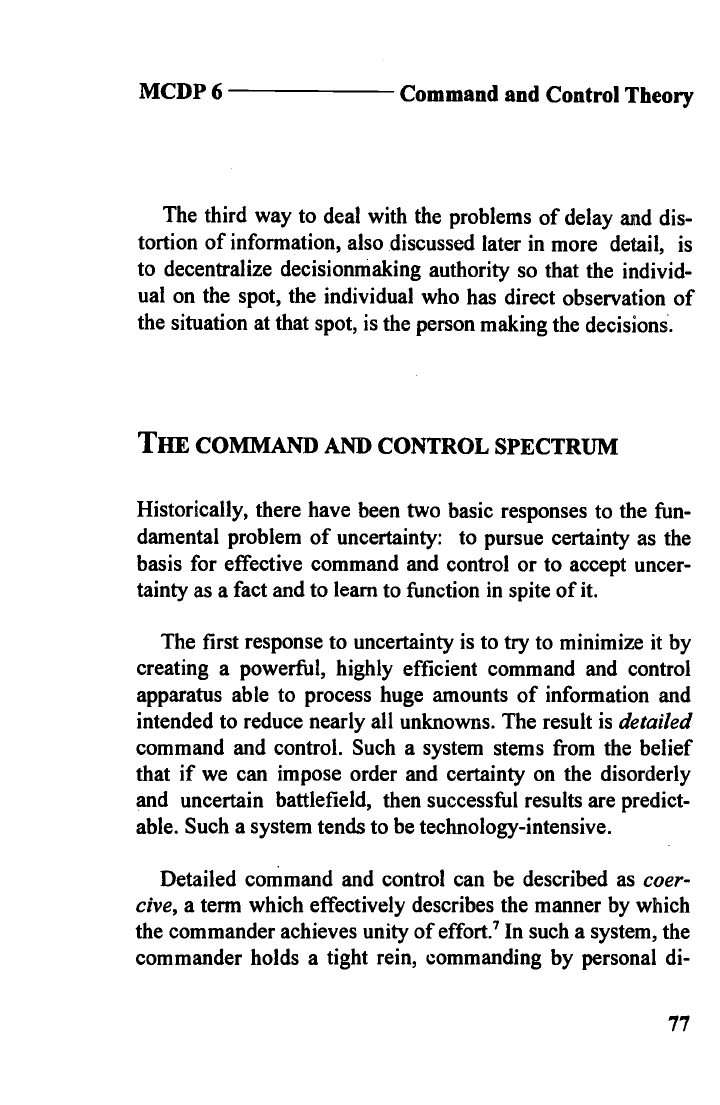
MCDP 6
Command and Control Theory
The third way to deal with the problems of delay and dis-
tortion of information, also discussed later in more detail,
is
to decentralize decisionmaking authority so that the individ-
ual on the spot, the individual who has direct observation of
the situation at that spot, is the person making the decisions.
THE COMMAND AND CONTROL SPECTRUM
Historically, there have been two basic responses to the fun-
damental problem of uncertainty:
to pursue certainty as the
basis for effective command and control or to accept uncer-
tainty as a fact and to learn to function in spite of it.
The first response to uncertainty is to try to minimize it by
creating a powerfiul, highly efficient command and control
apparatus able to process huge amounts of information and
intended to reduce nearly all unknowns. The result is detailed
command and control. Such a system stems from the belief
that if we can impose order and certainty on the disorderly
and uncertain battlefield, then successful results are predict-
able. Such a system tends to be technology-intensive.
Detailed command and control can be described as coer-
cive, a term which effectively describes the manner by which
the commander achieves unity of effort.7 In such a system, the
commander holds a tight rein, commanding by personal di-
77

Command and Control
MCDP 6
rection or detailed directive.8 Command and control tends to
be centralized and formal. Orders and plans are detailed and
explicit, and their successful execution requires strict obedi-
ence and minimizes subordinate decisiomnaking and initia-
tive. Detailed command and control emphasizes vertical,
linear information flow: in general, information flows up the
chain of command and orders flow down. Discipline and co-
ordination are imposed from above to ensure compliance with
the plan.
In a system based on detailed command and control, the
command and control process tends to move slowly:
infor-
mation must be fed up to the top of the chain where sole deci-
sionmaking authority resides, and orders must filter to the
bottom to be executed. Understandably, such a system does
not generally react well to rapidly changing situations. Nor
does it function well when the vertical flow of information is
disrupted. While distrust is not an inherent feature of detailed
command and control, organizations characterized by distrust
tend toward detailed command and control.
This approach represents an attempt to overcome the fun-
dam ental nature of war. Since we have already concluded that
precise direction is generally impossible in war, detailed com-
mand and control risks falling short of its desired result. The
question is whether it nears the desired result enough to
achieve overall success.
78

MCDP 6
Command and Control Theory
By contrast, mission command and control accepts the tur-
bulence and uncertainty of war. Rather than increase the level
of certainty that we seek, by mission command and control
we reduce the degree of certainty that we need. Mission com-
mand and control can be described as spontaneous: unity of
effort is not the product of conformity imposed from above
but of the spontaneous cooperation of all the elements of the
force.9 Subordinates are guided not by detailed instructions
and control measures but by their knowledge of the require-
ments of the overall mission. In such a system, the command-
er holds a loose rein, allowing subordinates significant free-
dom of action and requiring them to act with initiative. Disci-
pline imposed from above is reinforced with self-discipline
throughout the organization. Because it decentralizes deci-
sionmaking authority and grants subordinates significant free-
dom of action, mission command and control demands more
of leaders at all levels and requires rigorous training and edu-
cation.
Mission command and control tends to be decentralized,
informal, and flexible. Orders and plans are as brief and sim-
ple as possible, relying on subordinates to effect the necessary
coordination and on the human capacity for implicit commu-
nication—mutual understanding with minimal information
exchange. By decentralizing decisionmaking authority, mis-
sion command and control seeks to increase tempo and im-
prove the ability to deal with fluid and disorderly situations.
79
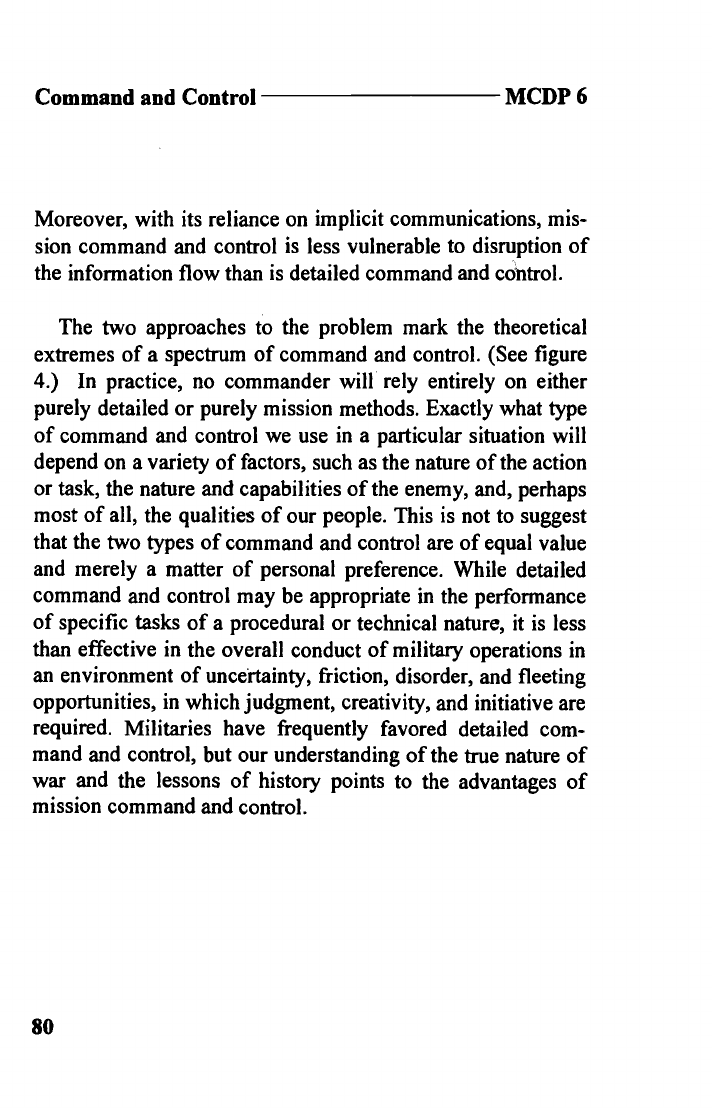
Command and Control
MCDP 6
Moreover, with its reliance on implicit communications, mis-
sion command and control is less vulnerable to disruption of
the information flow than is detailed command and control.
The two approaches to the problem mark the theoretical
extremes of a spectrum of command and control. (See figure
4.)
In practice, no commander will rely entirely on either
purely detailed or purely mission methods. Exactly what type
of command and control we use in a particular situation will
depend on a variety of factors, such as the nature of the action
or task, the nature and capabilities of the enemy, and, perhaps
most of all, the qualities of our people. This is not to suggest
that the two types of command and control are of equal value
and merely a matter of personal preference. While detailed
command and control may be appropriate in the performance
of specific tasks of a procedural or technical nature, it is less
than effective in the overall conduct of military operations in
an environment of uncertainty, friction, disorder, and fleeting
opportunities, in which judgment, creativity, and initiative are
required. Militaries have frequently favored detailed com-
mand and control, but our understanding of the true nature of
war and the lessons of history points to the advantages of
mission command and control.
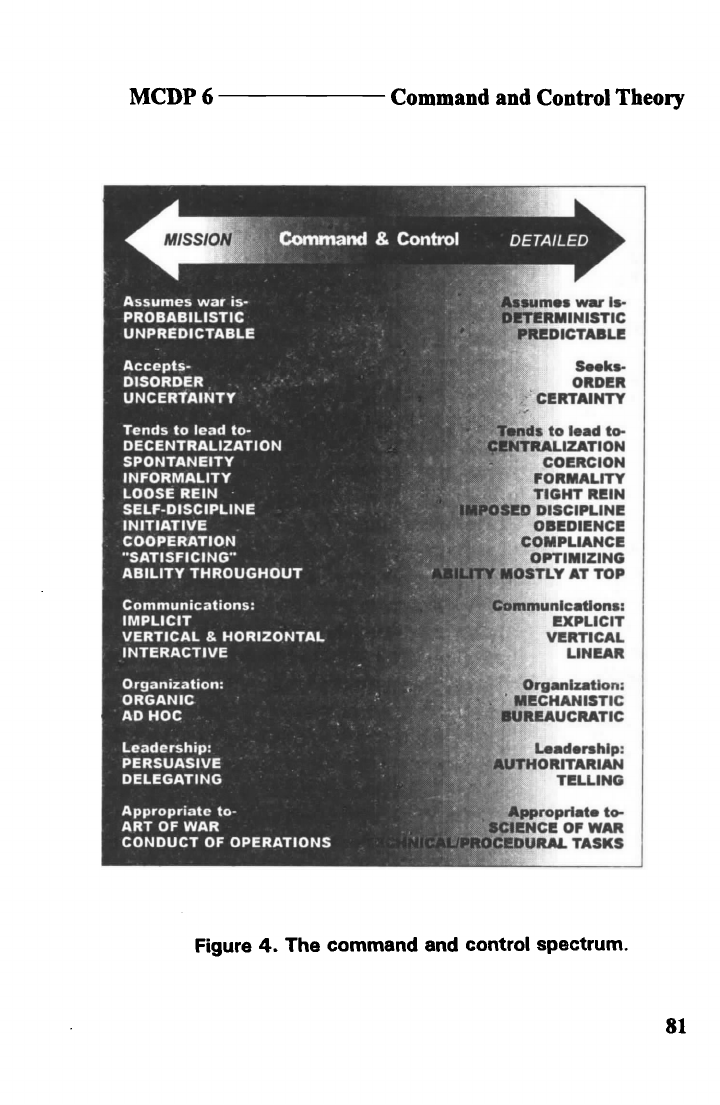
MCDP 6
Command and Control Theory
Figure
4. The command and control spectrum.
81

Command and Control
MCDP 6
LEADERSHIP THEORY
Leadership is the influencing of people to work toward the
accomplishment of a common objective. Because war is fun-
damentally a human endeavor, leadership is essential to effec-
tive command and control. There are two basic theories of
leadership that generally correspond to the theories of com-
mand and control.
The authoritarian theory of leadership is based on the as-
sumption that people naturally dislike work and will try to
avoid it where possible, and that they must therefore be
forced by coercion and threat of punishment to work toward
the common goal. This theory further argues that people actu-
ally prefer to be directed and try to avoid responsibility. The
result is an autocratic style of leadership aimed at achieving
immediate and unquestioning obedience. Leaders announce
•their decisions and expect subordinates to execute them. The
authoritarian leader is sometimes also known as a telling or
directing leader. While authoritarian leadership may result in
rapid obedience, it also can often result in subordinates who
are highly dependent on the leader, require continuous super-
vision, and lack initiative. Military discipline is widely seen
as an example of this model since quick and unquestioning
response to orders may be required in the heat of an emer-
gency. This is, however, only one version of leadership that
military leaders have used successfully.
82
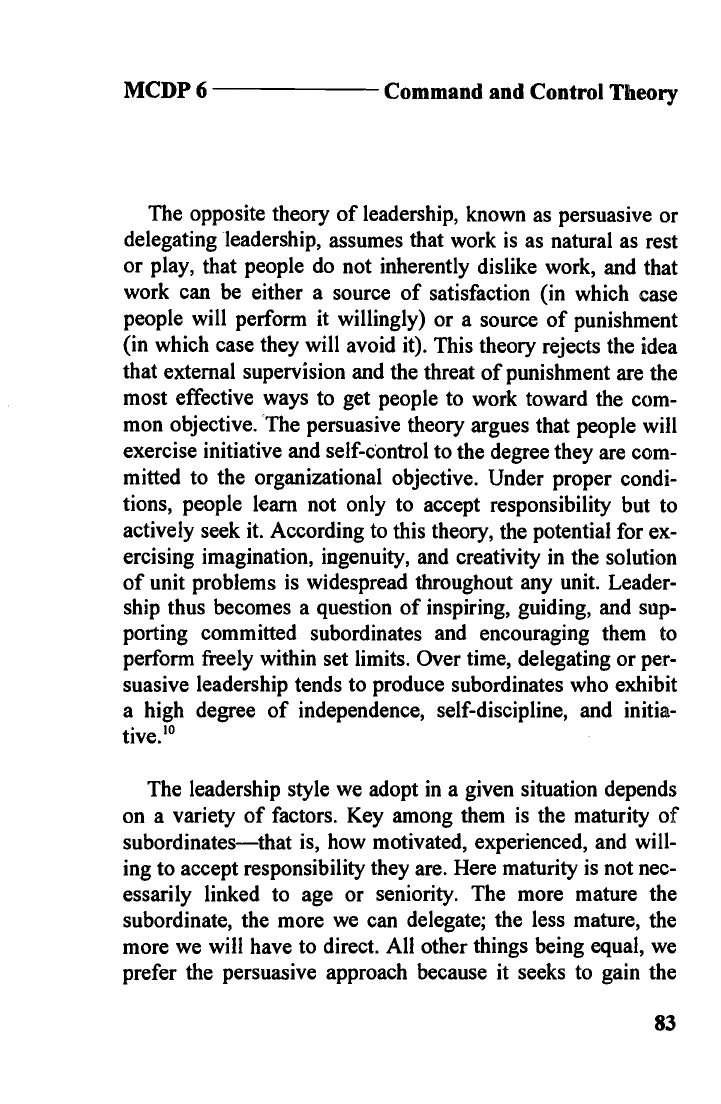
MCDP 6
Command and Control Theory
The opposite theory of leadership, known as persuasive or
delegating leadership, assumes that work is as natural as rest
or play, that people do not inherently dislike work, and that
work can be either a source of satisfaction (in which case
people will perform it willingly) or a source of punishment
(in which case they will avoid it). This theory rejects the idea
that external supervision and the threat of punishment are the
most effective ways to get people to work toward the com-
mon objective. The persuasive theory argues that people will
exercise initiative and self-control to the degree they are com-
mitted to the organizational objective. Under proper condi-
tions, people learn not only to accept responsibility but to
actively seek it. According to this theory, the potential for ex-
ercising imagination, ingenuity, and creativity in the solution
of unit problems is widespread throughout any unit. Leader-
ship thus becomes a question of inspiring, guiding, and sup-
porting committed subordinates and encouraging them to
perform freely within set limits. Over time, delegating or per-
suasive leadership tends to produce subordinates who exhibit
a high degree of independence, self-discipline, and initia-
tive.'0
The leadership style we adopt in a given situation depends
on a variety of factors. Key among them is the maturity of
subordinates—that is, how motivated, experienced, and will-
ing to accept responsibility they are. Here maturity is not nec-
essarily linked to age or seniority. The more mature the
subordinate, the more we can delegate; the less mature, the
more we will have to direct. All other things being equal, we
prefer the persuasive approach because it seeks to gain the
83

Command and Control MCDP 6
committed performance of subordinates and encourages sub-
ordinate initiative. Moreover, persuasive leadership reduces
the need for continuous supervision, an important considera-
tion on a dispersed and fluid battlefield on which continuous,
detailed supervision is problematic.
PLANNING THEORY
Planning is the process of developing practical schemes for
taking future actions. Planning may occur before a decision
and so support decisionmaking—by analyzing the mission,
the enemy, or the environment to help develop situational
awareness or by studying the feasibility of different courses
of action. Planning may also occur after a decision and so
support its execution—by working out necessary coordination
measures, allocation of resources, or timing and scheduling.
Planning facilitates future decisions and actions by helping
commanders provide for those things which are not likely to
change or which are fairly predictable (such as geography and
certain aspects of supply or transport). Planning helps them
to examine their assumptions, to come to a common under-
standing about the situation and its general direction, to an-
ticipate possible enemy actions, and thus to consider possible
counteractions. Planning helps to uncover and clarify poten-
tial opportunities and threats and to prepare for opportunities
84

MCDP 6
Command and Control Theory
and threats in advance. Conversely, planning helps to avoid
preventable mistakes and missed opportunities.
By definition, planning is oriented on the future. It repre-
sents an effort to project our thoughts and designs forward in
time and space. Because the future is always uncertain, plan-
fling should generally not seek to specify future actions with
precision. The farther ahead we plan, the more time we allow
ourselves to prepare, but the less certain and specific our
plans can be. Planning ahead thus becomes less a matter of
trying to direct events and more a matter of identifying op-
tions and possibilities.
Depending on the situation and the nature of the prepara-
tions, planning may be done rapidly or deliberately. RapidI
time-sensitive planning is conducted in response to existing
conditions and is meant for immediate or near-future execu-
tion. In contrast, deliberate planning is based on anticipated
future conditions and is intended for possible execution at
some more distant time. We should keep in mind that all
planning takes time and must facilitate the generation or
maintenance of tempo, while ensuring that time allocated for
planning does not adversely impact on tempo.
Planning routines can improve the proficiency of a staff by
creating an effectiveness and efficiency of effort. The goal of
the Marine Corps is to develop an institutionalized planning
framework for use at all echelons of command. However, we
must guard against using an institutionalized planning frame-
85

Command and Control
MCDP 6
work in a lock-step fashion. We must ensure that the applica-
tion of this planning process contributes to flexibility in con-
ducting operations.
Planning occurs at different levels and manifests itself dif-
ferently at these levels. At the highest level is what we can
call conceptual planning which establishes aims, objectives,
and intents and which involves developing tactical, opera-
tional, or strategic concepts for the overall conduct of military
actions. Conceptual planning should provide the foundation
for all subsequent planning, which we can call functional and
detailed. These are the more routine and pragmatic elements
of planning which are concerned with translating the concept
into a complete and practicable plan. Functional planning is
concerned with the various functional areas necessary to sup-
port the overall concept, such as subordinate concepts for mo-
bilization, deployment, logistics, intelligence, and so on. De-
tailed planning encompasses the practical specifics of execu-
tion. Detailed planning deals primarily with scheduling, coor-
dination, or technical matters required to move and sustain
military forces, such as calculating the supplies or transport
needed for a given operation.
In general, conceptual planning corresponds to the art of
war, detailed planning applies to the science of war, and func-
tional planning falls somewhere in between. Detailed and, to
a lesser extent, functional planning may require deliberate
and detailed calculations and may involve the development of
detailed schedules or plans, such as landing tables, resupply
86
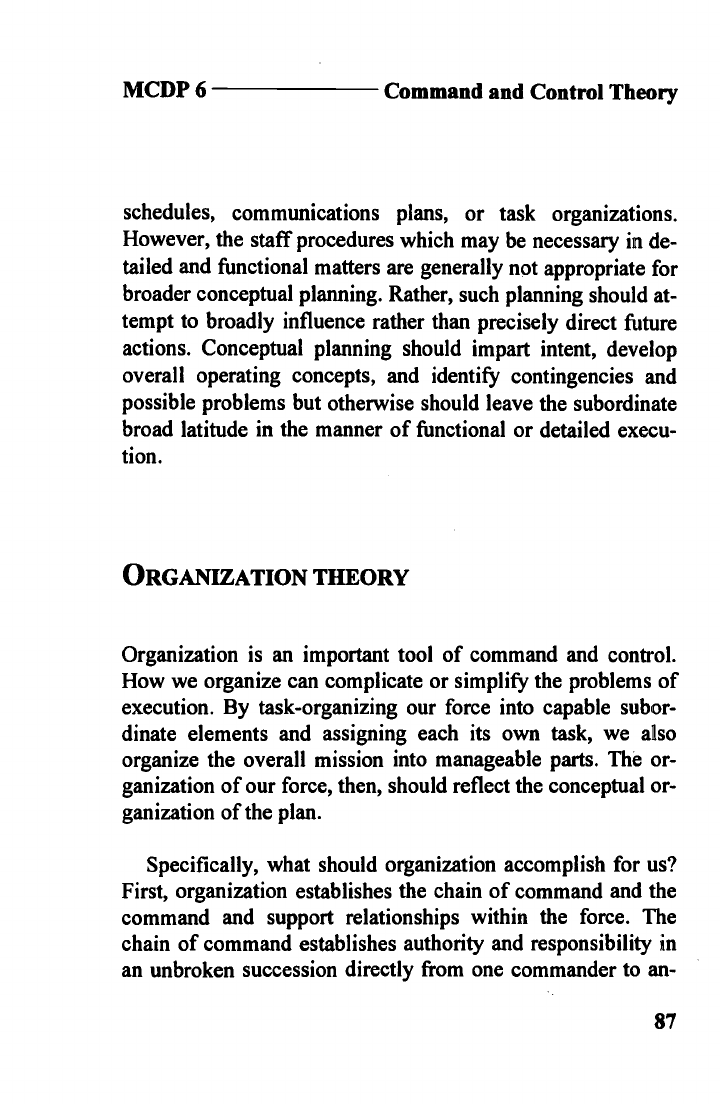
MCDP 6
Command and Control Theory
schedules, communications plans,
or task organizations.
However, the staff procedures which may be necessary in de-
tailed and functional matters are generally not appropriate for
broader conceptual planning. Rather, such planning should at-
tempt to broadly influence rather than precisely direct future
actions. Conceptual planning should impart intent, develop
overall operating concepts, and identify contingencies and
possible problems but otherwise should leave the subordinate
broad latitude in the manner of functional or detailed execu-
tion.
ORGANIZATION THEORY
Organization is an important tool of command and control.
How we organize can complicate or simplify the problems of
execution. By task-organizing our force into capable subor-
dinate elements and assigning each its own task, we also
organize the overall mission into manageable parts. The or-
ganization of our force, then, should reflect the conceptual or-
ganization of the plan.
Specifically, what should organization accomplish for us?
First, organization establishes the chain of command and the
command and support relationships within the force. The
chain of command establishes authority and responsibility in
an unbroken succession directly from one commander to an-
87
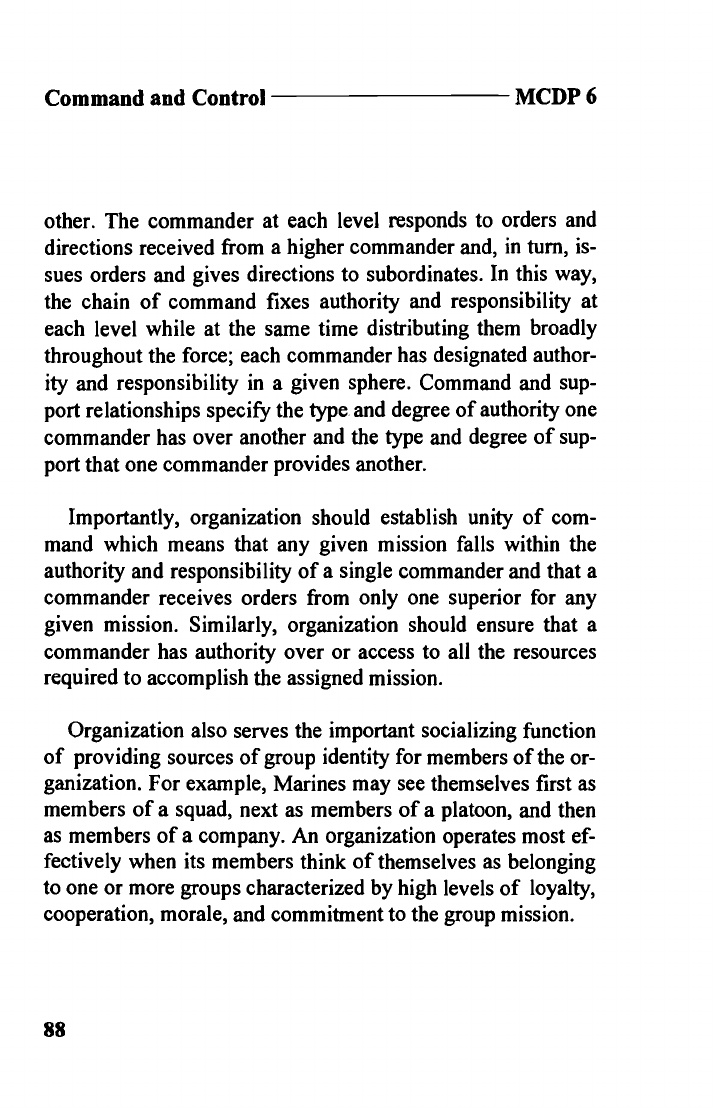
Command and Control
MCDP 6
other. The commander at each level responds to orders and
directions received from a higher commander and, in turn, is-
sues orders and gives directions to subordinates. In this way,
the chain of command fixes authority and responsibility at
each level while at the same time distributing them broadly
throughout the force; each commander has designated author-
ity and responsibility in a given sphere. Command and sup-
port relationships specify the type and degree of authority one
commander has over another and the type and degree of sup-
port that one commander provides another.
Importantly, organization should establish unity of com-
mand which means that any given mission falls within the
authority and responsibility of a single commander and that a
commander receives orders from only one superior for any
given mission. Similarly, organization should ensure that a
commander has authority over or access to all the resources
required to accomplish the assigned mission.
Organization also serves the important socializing function
of providing sources of group identity for members of the or-
ganization. For example, Marines may see themselves first as
members of a squad, next as members of a platoon, and then
as members of a company. An organization operates most ef-
fectively when its members think of themselves as belonging
to one or more groups characterized by high levels of loyalty,
cooperation, morale, and commitment to the group mission.
88
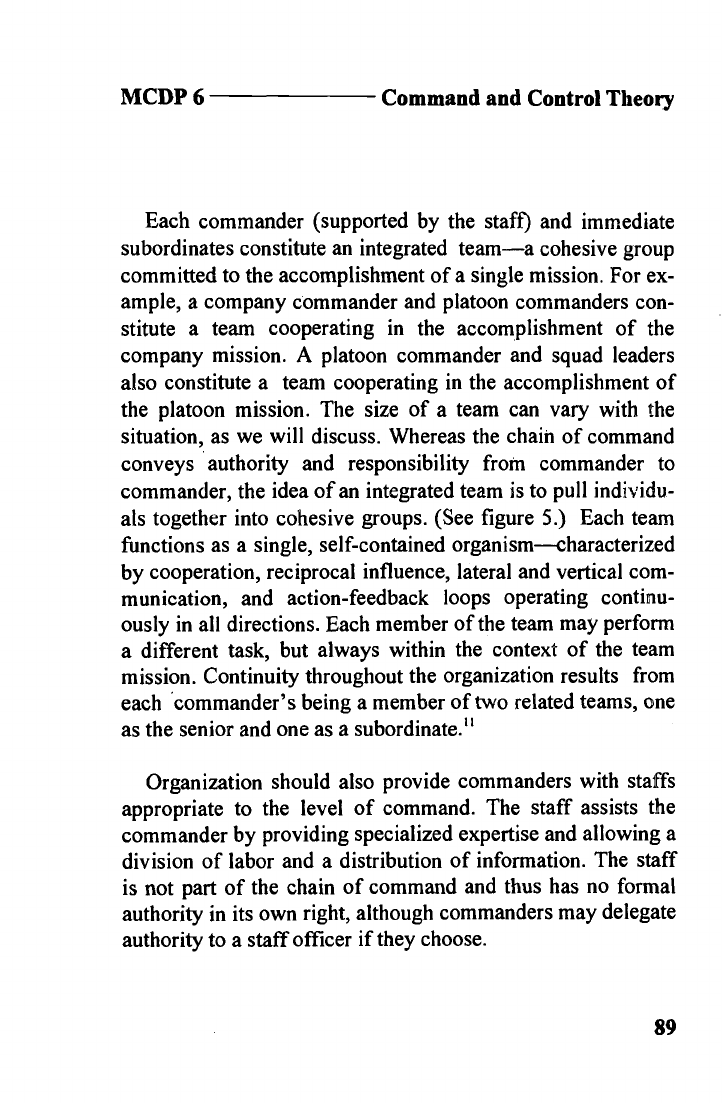
MCDP 6
Command and Control Theory
Each commander (supported by the staff) and immediate
subordinates constitute an integrated team—a cohesive group
committed to the accomplishment of a single mission. For ex-
ample, a company commander and platoon commanders con-
stitute a team cooperating in the accomplishment of the
company mission. A platoon commander and squad leaders
also constitute a team cooperating in the accomplishment of
the platoon mission. The size of a team can vary with the
situation, as we will discuss. Whereas the chain of command
conveys authority and responsibility from commander to
commander, the idea of an integrated team is to pull individu-
als together into cohesive groups. (See figure 5.) Each team
functions as a single, self-contained organism—characterized
by cooperation, reciprocal influence, lateral and vertical com-
munication, and action-feedback loops operating continu-
ously in all directions. Each member of the team may perform
a different task, but always within the context of the team
mission. Continuity throughout the organization results from
each commander's being a member of two related teams, one
as the senior and one as a subordinate.'1
Organization should also provide commanders with staffs
appropriate to the level of command. The staff assists the
commander by providing specialized expertise and allowing a
division of labor and a distribution of information. The staff
is not part of the chain of command and thus has no formal
authority in its own right, although commanders may delegate
authority to a staff officer if they choose.
89
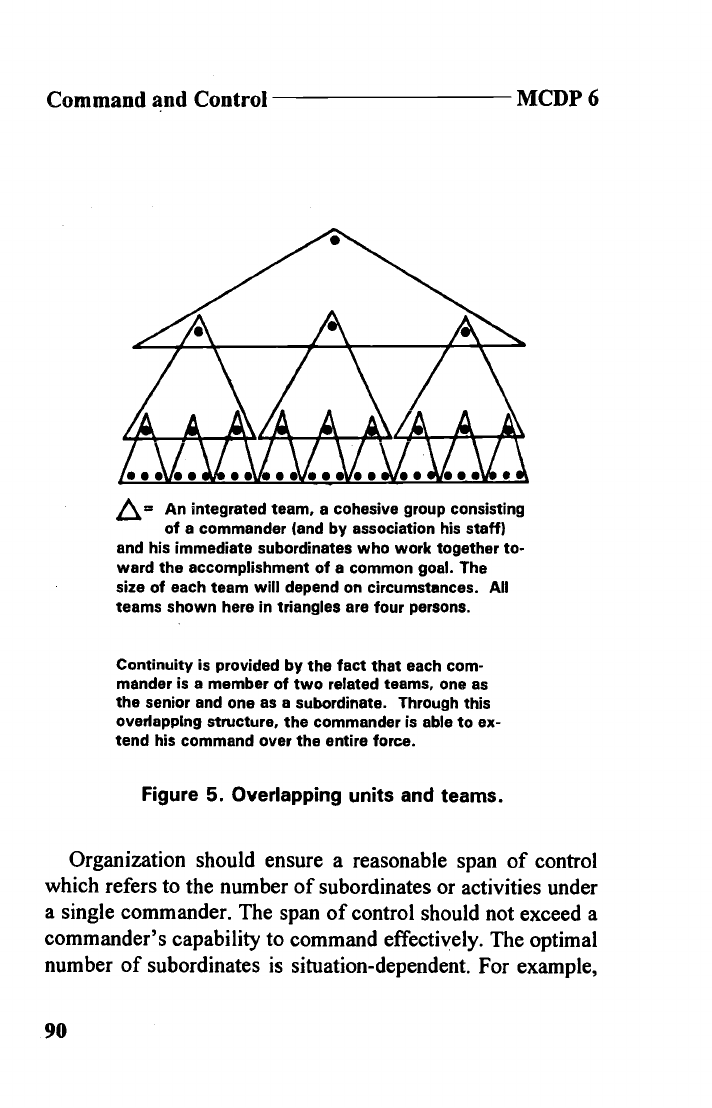
Command and Control
MCDP 6
S
•.. S• •IIS• ••S •S
•S •••
•
An integrated team, a cohesive group consisting
of a commander (and by association his staff)
and his immediate subordinates who work together to-
ward the accomplishment of a common goal. The
size of each team will depend on circumstances. All
teams shown here in triangles are four persons.
Continuity is provided by the fact that each com-
mander is a member of two related teams, one as
the senior and one as a subordinate. Through this
overlapping structure, the commander is able to ex-
tend his command over the entire force.
Figure 5. Overlapping units and teams.
Organization
should ensure a reasonable span of control
which refers to the number of subordinates or activities under
a single commander. The span of control should not exceed a
commander's capability to command effectively. The optimal
number of subordinates is situation-dependent. For example,
90

MCDP 6
Command and Control Theory
the more fluid and faster-changing a situation is, the fewer
subordinate elements a commander can keep track of continu-
ously. Likewise, commanders exercising detailed command
and control, which requires them to pay close attention to the
operations of each subordinate element, generally have nar-
rower spans of control than commanders who use mission
command and control and let their subordinates work out the
details of execution.
Although a reasonable span of control varies with the
situation, as a rule of thumb an individual can effectively
command at least three and as many as seven subordinates.
Within this situation-dependent range, a greater number
means greater flexibility—three subordinate units allow for
more options and combinations than two, for example. How-
ever, as the number increases, at some point we lose the abil-
ity to effectively consider each unit individually and begin to
think of the units together as a single, inflexible mass. At this
point, the only way to reintroduce flexibility is to group ele-
ments together into a smaller number of parts, thereby creat-
ing the need for another intermediate echelon of command.
The evolution of the Marine rifle squad during the Second
World War is a good example of this. Entering the war, the
rifle squad consisted of nine Marines—a squad leader and
eight squad members with no additional internal organization.
In combat this squad lacked the flexibility needed for small-
unit fire and maneuver. Moreover, squad leaders often could
not effectively command eight individual Marines. The an-
swer was the creation of an intermediate organizational level,
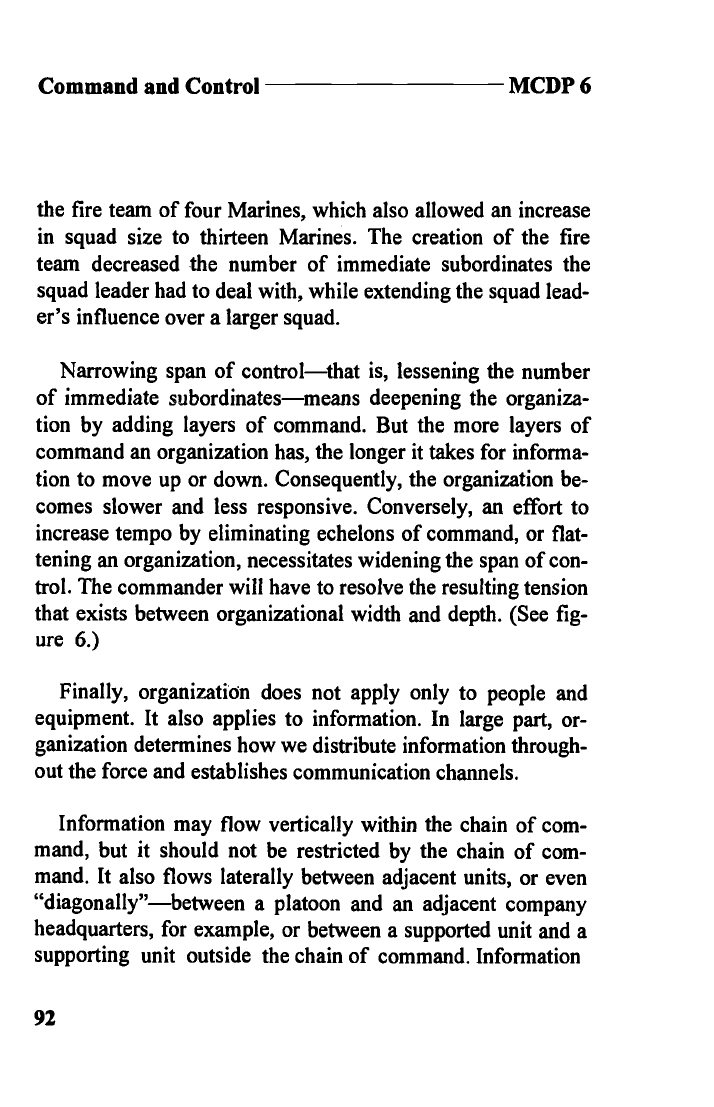
Command and Control
MCDP 6
the fire team of four Marines, which also allowed an increase
in squad size to thirteen Marines. The creation of the fire
team decreased the number of immediate subordinates the
squad leader had to deal with, while extending the squad lead-
er's influence over a larger squad.
Narrowing span of control—that is, lessening the number
of immediate subordinates—means deepening the organiza-
tion by adding layers of command. But the more layers of
command an organization has, the longer it takes for informa-
tion to move up or down. Consequently, the organization be-
comes slower and less responsive. Conversely, an effort to
increase tempo by eliminating echelons of command, or flat-
tening an organization, necessitates widening the span of con-
trol. The commander will have to resolve the resulting tension
that exists between organizational width and depth. (See fig-
ure 6.)
Finally, organization does not apply only to people and
equipment. It also applies to information. In large part, or-
ganization determines how we distribute information through-
out the force and establishes communication channels.
Information may flow vertically within the chain of com-
mand, but it should not be restricted by the chain of com-
mand. It also flows laterally between adjacent units, or even
"diagonally"—between a platoon and an adjacent company
headquarters, for example, or between a supported unit and a
supporting unit outside the chain of command. Information
92
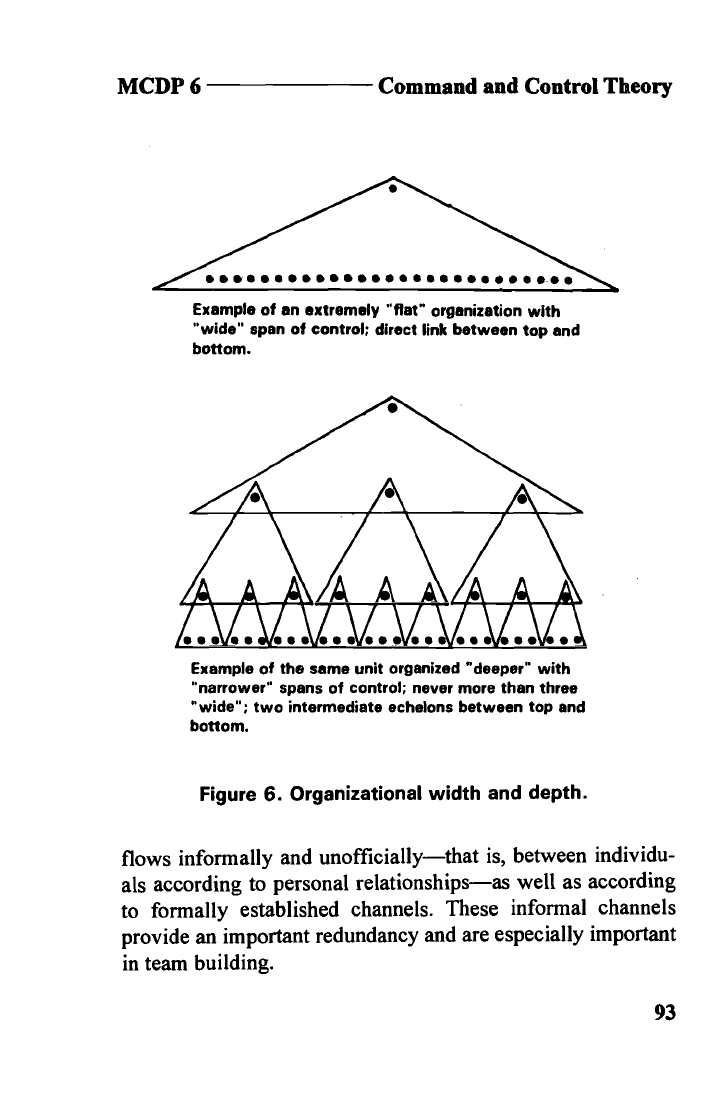
MCDP 6
Command and Control Theory
Example of an extremely "flat" organization with
"wide" span of control; direct link between top and
bottom.
... U. •SS U.S SSS SSSSSSSS* .
Example of the same unit organized "deeper" with
"narrower" spans of control; never more than three
"wide; two intermediate echelons between top and
bottom.
Figure 6. Organizational width and depth.
flows informally and unofficially—that is, between individu-
als according to personal relationships—as well as according
to formally established channels. These informal channels
provide an important redundancy and are especially important
in team building.
93
S 55555.555S•••••• S S SSS• S S.SS

Command and Control
MCDP 6
CoIiiIuNIcAT1oNs THEORY
Because military evolutions require cooperative effort, it is
important that we be able to communicate effectively with
others. Communications are any method or means of convey-
ing information from one person or place to another to im-
prove understanding. In general, effective organizations are
characterized by intense, unconstrained communications—
that is, the free and enthusiastic sharing of meaningful infor-
mation throughout the organization.'2 Moreover, communica-
tion has
an importance far beyond the
exchange of
information; it serves a socializing flinction. Separate from
the quality or meaning of the information exchanged, the act
of communicating strengthens bonds within an organization
and so is an important device in building trust, cooperation,
cohesion, and mutual understanding.
The traditional view of communications within military or-
ganizations is that the subordinate supplies the commander
with information about the situation, and the commander in
turn supplies the subordinate with decisions and instructions.
This linear form of communication may be consistent with
the exercise of detailed command and control, but not with a
system based on mission command and control which instead
requires interactive communications characterized by con-
tinuous feedback loops. Feedback provides the means to im-
prove and confirm mutual understanding—and this applies to
lateral as well as vertical communications.
94

MCDP 6
Command and Control Theory
We communicate by a wide variety of means: face-to-face
conversation, radio, telephone, data link, written word, visual
signal, picture, or diagram. Human beings communicate not
only in the words they use, but also by tone of voice, inflec-
tion, facial expression, body language, and gestures. In fact,
evidence suggests that in face-to-face conversation, humans
actually communicate most by visual means (such as ges-
tures, body language, or facial expressions), second by vocal
nonverbal means (such as tone or inflection), and least by the
actual words they use.'3
Moreover, people can communicate implicitly—that is,
they achieve mutual understanding and cooperation with a
minimal amount of information having to be transmitted—if
they have a familiarity formed of shared experiences and a
common outlook. A key phrase or a slight gesture can some-
times communicate more than a detailed order. Since it re-
duces the time spent drafting and relaying messages, implicit
communication also reduces the problems of delay typically
associated with information flow. Implicit communication
helps to maximize information content while minimizing the
actual flow of data, thereby making the organization less vul-
nerable to the disruption of communications.
While conciseness is a virtue, so is a certain amount of re-
dundancy. Used within reason, redundancy of communica-
tions can improve clarity of meaning and mitigate against
disruptions to the communications system. Effective commu-
nications consequently exhibit a balance between conciseness
95

Command and Control
MCDP 6
and redundancy. (In general, the greater the implicit under-
standing within the organization, the less the need for redun-
dancy.)
INFORMATION MANAGEMENT THEORY
Since effective command and control is concerned with get-
ting the right information to the right person at the right time,
information management is crucial.
We initiate communications under two basic principles:
supply-push and demand-pull.'4 A supply-push system pushes
information from the source to the user either as the informa-
tion becomes available or according to a schedule. (See figure
7.) The advantages of supply-push are that the commander
does not need to request the information and that the informa-
tion generally arrives in a timely fashion. The challenge with
a supply-push system is to be able to anticipate the com-
mander's information needs. The danger of information over-
load arises primarily from supply-push.
By contrast, a pure demand-pull system does not rely on
the ability to anticipate information needs; it is inactive until
a demand is made on it. In a pure demand-pull system, the
user generates all information requirements. (See figure 7.) If
the information is readily available—already resident in some
96

MCDP 6
Command and Control Theory
Figure 7. Supply-push and demand-pull information
management.
data base, for example—the demand can be filled quickly and
efficiently. However, if the information is not readily avail-
able, the demand typically triggers a "demand cascade," as
the requirement filters through the chain of command until it
reaches the appropriate level for gathering. This takes time
and can be a burden to lower echelons, especially in a central-
ized command and control system in which all information
must be fed to the senior echelons. An answer to the demand
cascade is for commanders to keep dedicated gathering assets
which answer directly to them, such as the directed telescopes
already mentioned.
Demand-pull can help focus scarce resources on those
tasks which the commander has identified as critical; it can
deliver information specifically tailored to the commander's
97

Command and Control
MCDP 6
information needs; and it will produce only that information
which the commander requests. These characteristics can be
both strengths and weaknesses. They can be strengths because
information flow is tailored specifically to identified require-
ments. However, they can also be weaknesses because there
will often be information requirements that the commander
has not identified, and in a pure demand-pull system those re-
quirements will go unsatisfied. One definite disadvantage of
demand-pull is the cost in time since the search for informa-
tion may not begin until the commander has identified the
need for that information.
We can also discuss information management in terms of
how information is transmitted. First, information may be
broadcast, sent simultaneously to a broad audience—anyone
with access to the information network—to include different
echelons of command. (See figure 8.) The great advantage of
broadcast is that it gets information to the widest audience in
the shortest amount of time. If the information is of a generic
nature, this method may be extremely efficient. However,
since the information is sent to a wide audience with varying
information requirements, the information cannot be tailored
to suit any specific commander's needs. Perhaps the greatest
drawback of broadcast transmission is that undisciplined use
of this method can quickly lead to information overload.
98
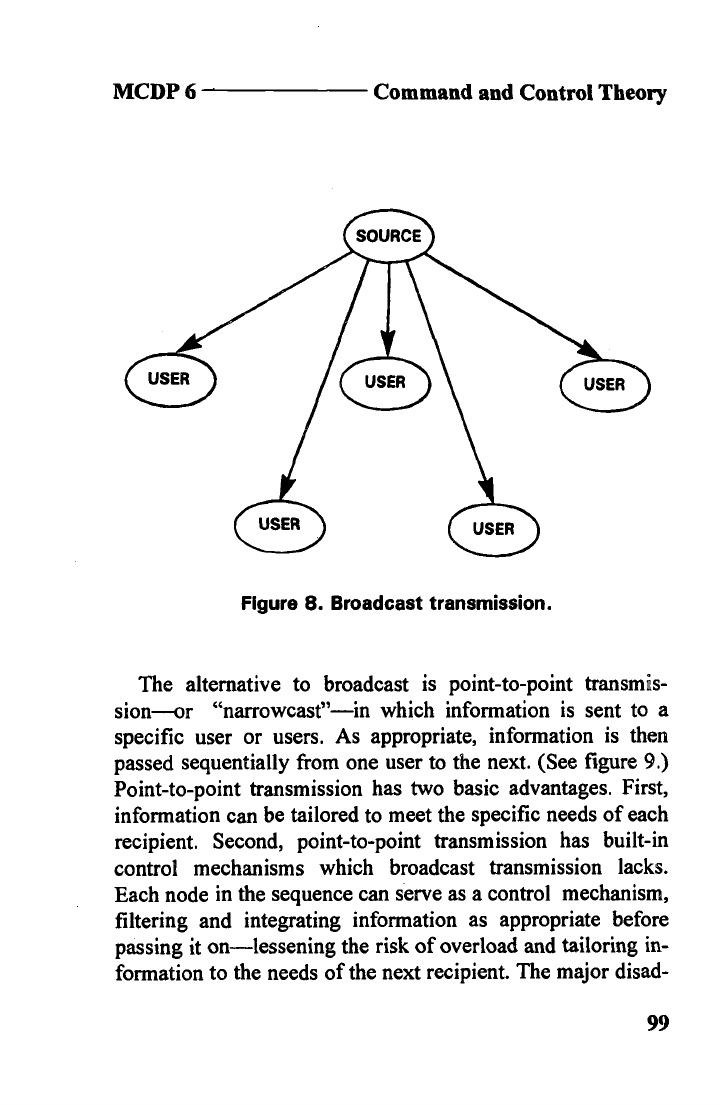
MCDP 6
Command and Control Theory
The alternative to broadcast is point-to-point transmis-
sion—or "narrowcast"—in which information is sent to a
specific user or users. As appropriate, infonnation is then
passed sequentially from one user to the next. (See figure 9.)
Point-to-point transmission has two basic advantages. First,
information can be tailored to meet the specific needs of each
recipient. Second, point-to-point transmission has built-in
control mechanisms which broadcast transmission lacks.
Each node in the sequence can serve as a control mechanism,
filtering and integrating information as appropriate before
passing it on—lessening the risk of overload and tailoring in-
formation to the needs of the next recipient. The major disad-
99
Figure 8. Broadcast transmission.
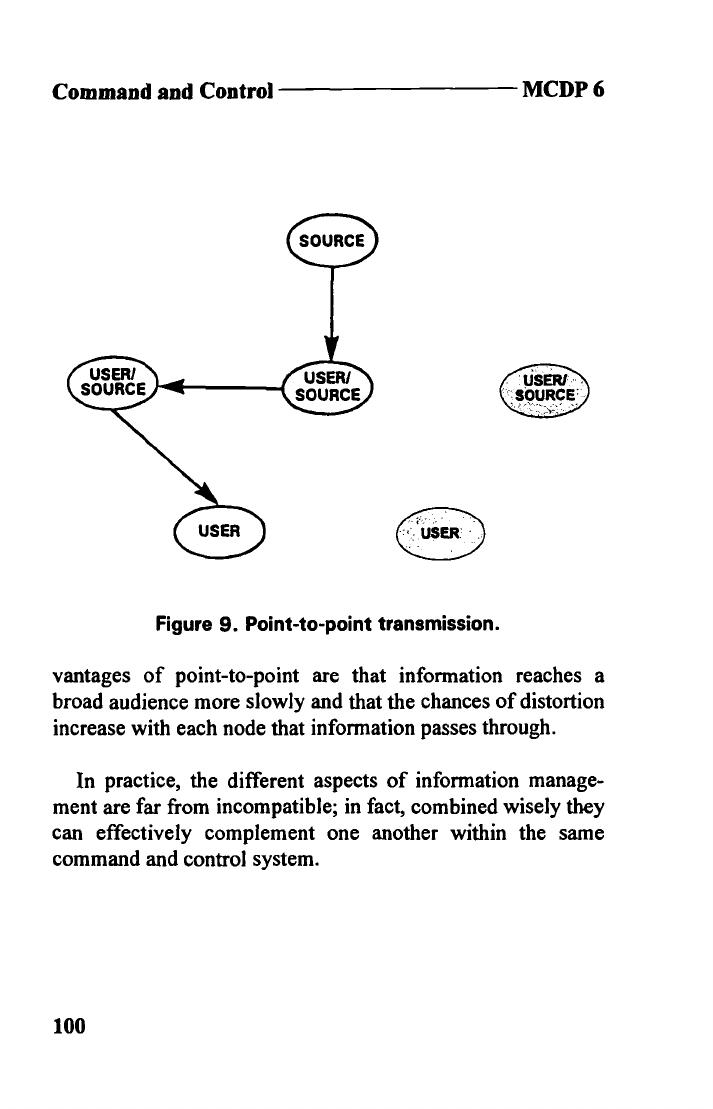
Command and Control
MCDP 6
rUSE
Figure 9. Point-to-point transmission.
ISERI.
SOURCE
vantages of point-to-point are that information reaches a
broad audience more slowly and that the chances of distortion
increase with each node that information passes through.
In practice, the different aspects of information manage-
ment are far from incompatible; in fact, combined wisely they
can effectively complement one another within the same
command and control system.
100
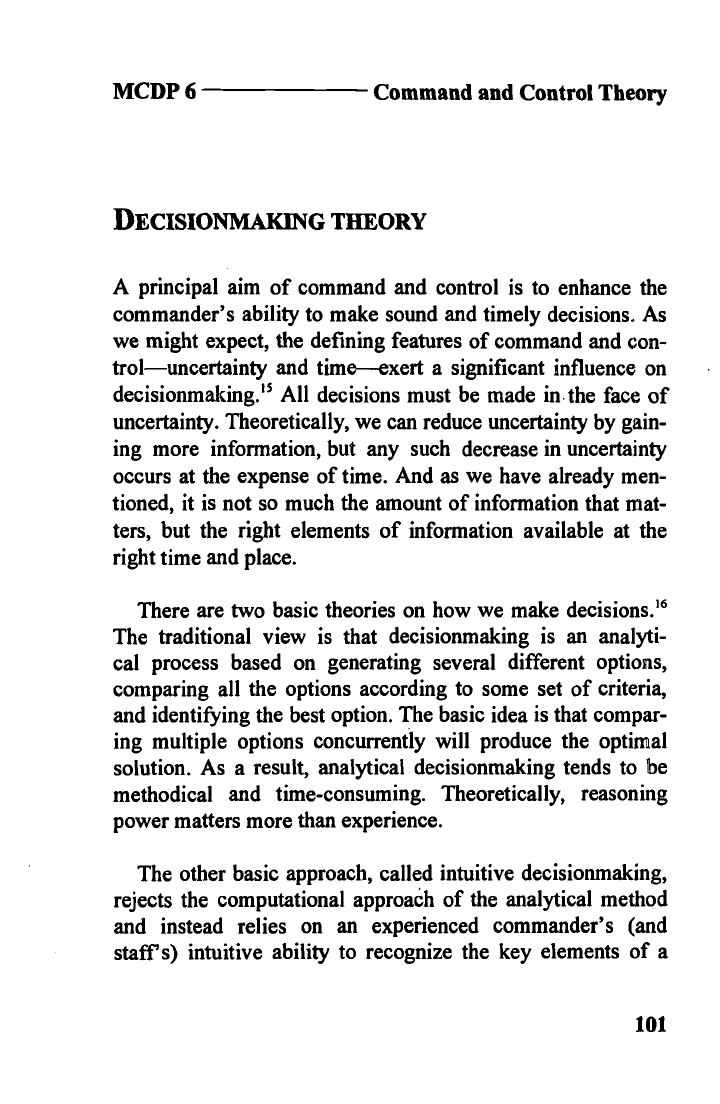
MCDP 6
Command and Control Theory
DEcIsIoNr&iurG THEORY
A principal aim of command and control is to enhance the
commander's ability to make sound and timely decisions. As
we might expect, the defining features of command and con-
trol—uncertainty and time—exert a significant influence on
decisionmaking.'5 All decisions must be made in. the face of
uncertainty. Theoretically, we can reduce uncertainty by gain-
ing more information, but any such decrease in uncertainty
occurs at the expense of time. And as we have already men-
tioned, it is not so much the amount of information that mat-
ters, but the right elements of information available at the
right time and place.
There are two basic theories on how we make decisions.'6
The traditional view is that decisionmaking is an analyti-
cal process based on generating several different options,
comparing all the options according to some set of criteria,
and identifying the best option. The basic idea is that compar-
ing multiple options concurrently will produce the optimal
solution. As a result, analytical decisionmaking tends to be
methodical and time-consuming. Theoretically, reasoning
power matters more than experience.
The other basic approach, called intuitive decisionmaking,
rejects the computational approach of the analytical method
and instead relies on an experienced commander's (and
staff's) intuitive ability to recognize the key elements of a
101
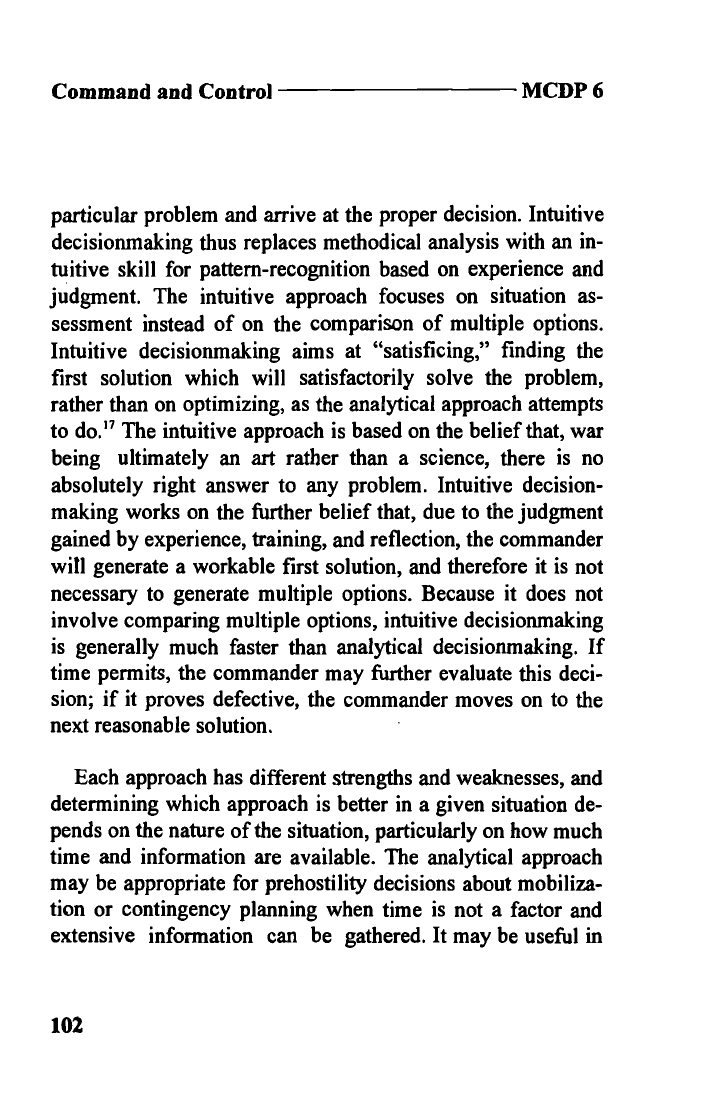
Command and Control
MCDP 6
particular problem and arrive at the proper decision. Intuitive
decisionmaking thus replaces methodical analysis with an in-
tuitive skill for pattern-recognition based on experience and
judgment. The intuitive approach focuses on situation as-
sessment instead of on the comparison of multiple options.
Intuitive decisionmaking aims at "satisficing," finding the
first solution which will satisfactorily solve the problem,
rather than on optimizing, as the analytical approach attempts
to do.'7 The intuitive approach is based on the belief that, war
being ultimately an art rather than a science, there is no
absolutely right answer to any problem. Intuitive decision-
making works on the further belief that, due to the judgment
gained by experience, training, and reflection, the commander
will generate a workable first solution, and therefore it is not
necessary to generate multiple options. Because it does not
involve comparing multiple options, intuitive decisionmaking
is generally much faster than analytical decisionmaking. If
time permits, the commander may further evaluate this deci-
sion; if it proves defective, the commander moves on to the
next reasonable solution.
Each approach has different strengths and weaknesses, and
determining which approach is better in a given situation de-
pends on the nature of the situation, particularly on how much
time and information are available. The analytical approach
may be appropriate for prehostility decisions about mobiliza-
tion or contingency planning when time is not a factor and
extensive information can be gathered. It may be useful in
102
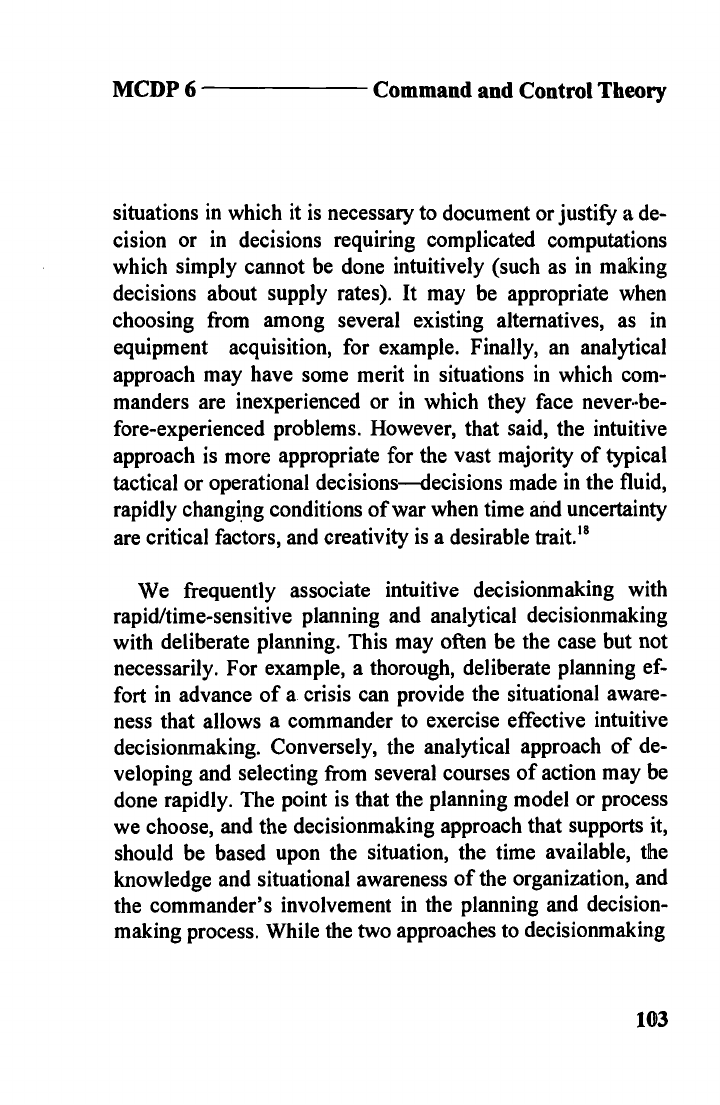
MCDP 6
Command and Control Theory
situations in which it is necessary to document or justify a de-
cision or in decisions requiring complicated computations
which simply cannot be done intuitively (such as in making
decisions about supply rates). It may be appropriate when
choosing from among several existing alternatives, as in
equipment acquisition, for example. Finally, an analytical
approach may have some merit in situations in which com-
manders are inexperienced or in which they face never.-be-
fore-experienced problems. However, that said, the intuitive
approach is more appropriate for the vast majority of typical
tactical or operational decisions—decisions made in the fluid,
rapidly changing conditions of war when time and uncertainty
are critical factors, and creativity is a desirable trait.'8
We frequently associate intuitive decisionmaking with
rapid/time-sensitive planning and analytical decisionmaking
with deliberate planning. This may often be the case but not
necessarily. For example, a thorough, deliberate planning ef-
fort in advance of a crisis can provide the situational aware-
ness that allows a commander to exercise effective intuitive
decisionmaking. Conversely, the analytical approach of de-
veloping and selecting from several courses of action may be
done rapidly. The point is that the planning model or process
we choose, and the decisionmaking approach that supports it,
should be based upon the situation, the time available, the
knowledge and situational awareness of the organization, and
the commander's involvement in the planning and decision-
making process. While the two approaches to decisionmaking
103
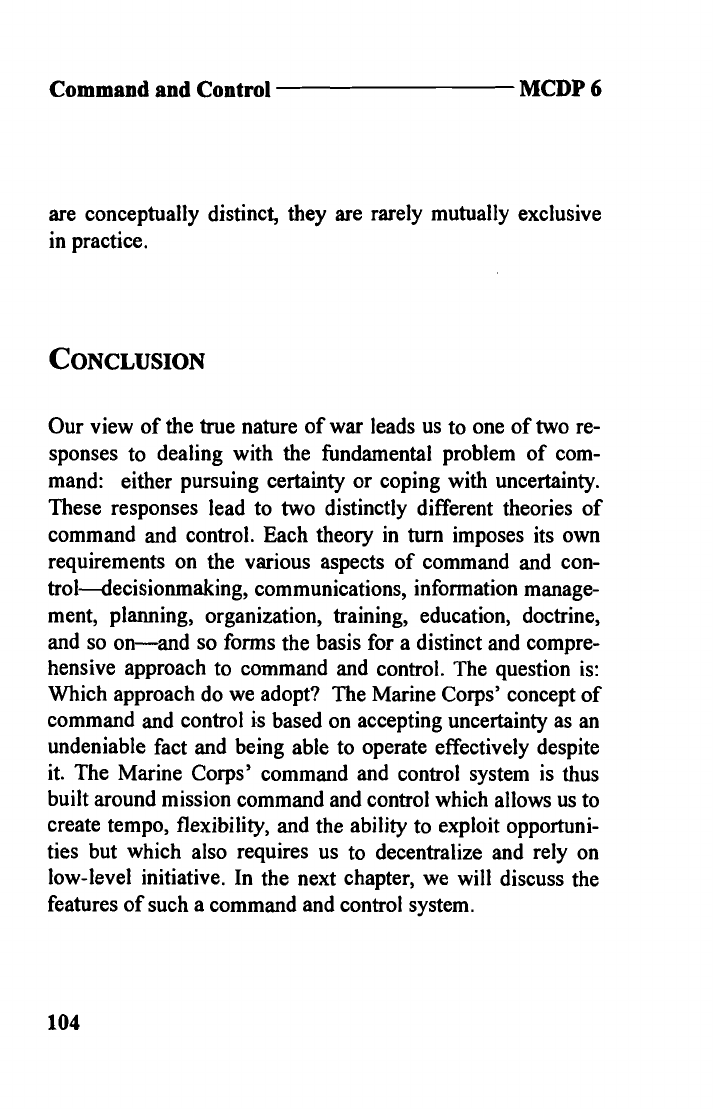
Command and Control
MCDP 6
are conceptually distinct, they are rarely mutually exclusive
in practice.
CONCLUSION
Our view of the true nature of war leads us to one of two re-
sponses to dealing with the fundamental problem of com-
mand: either pursuing certainty or coping with uncertainty.
These responses lead to two distinctly different theories of
command and control. Each theory in turn imposes its own
requirements on the various aspects of command and con-
trol—decisionmaking, communications, information manage-
ment, planning, organization, training, education, doctrine,
and so on—and so forms the basis for a distinct and compre-
hensive approach to command and control. The question is:
Which approach do we adopt? The Marine Corps' concept of
command and control is based on accepting uncertainty as an
undeniable fact and being able to operate effectively despite
it. The Marine Corps' command and control system is thus
built around mission command and control which allows us to
create tempo, flexibility, and the ability to exploit opportuni-
ties but which also requires us to decentralize and rely on
low-level initiative. In the next chapter, we will discuss the
features of such a command and control system.
104
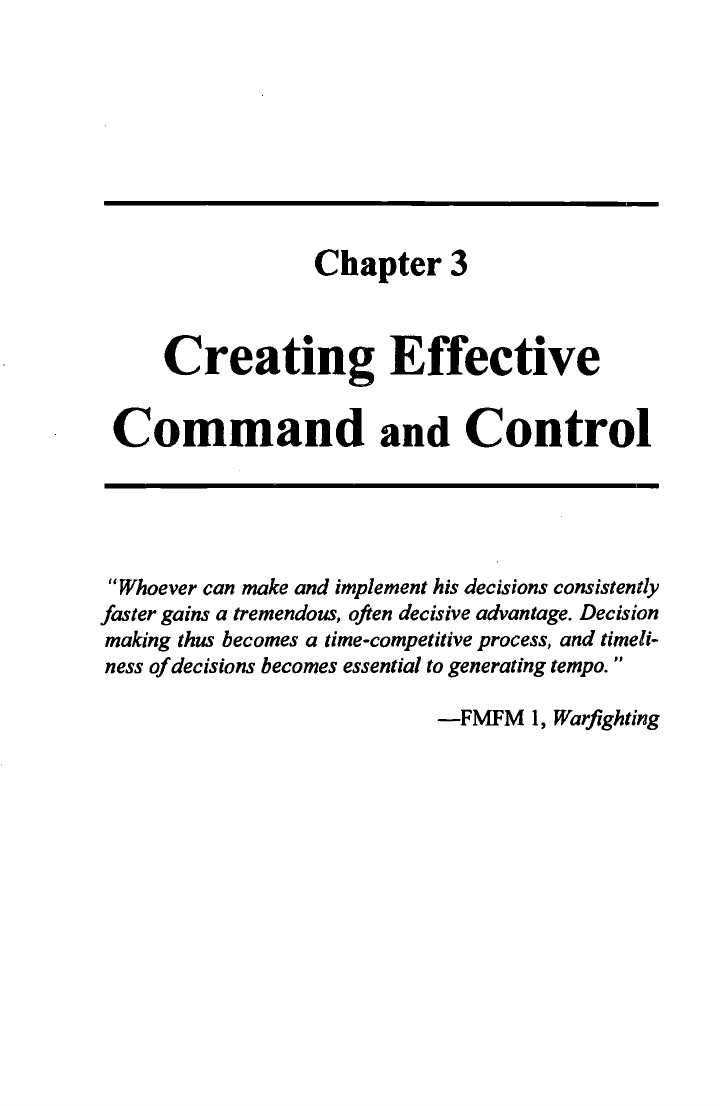
Chapter 3
Creating Effective
Command and Control
"Whoever can make and implement his decisions consistently
faster gains a tremendous, often decisive advantage. Decision
making thus becomes a time-competitive process, and timeli-
ness of decisions becomes essential to generating tempo."
—FMFM 1, Warfighting

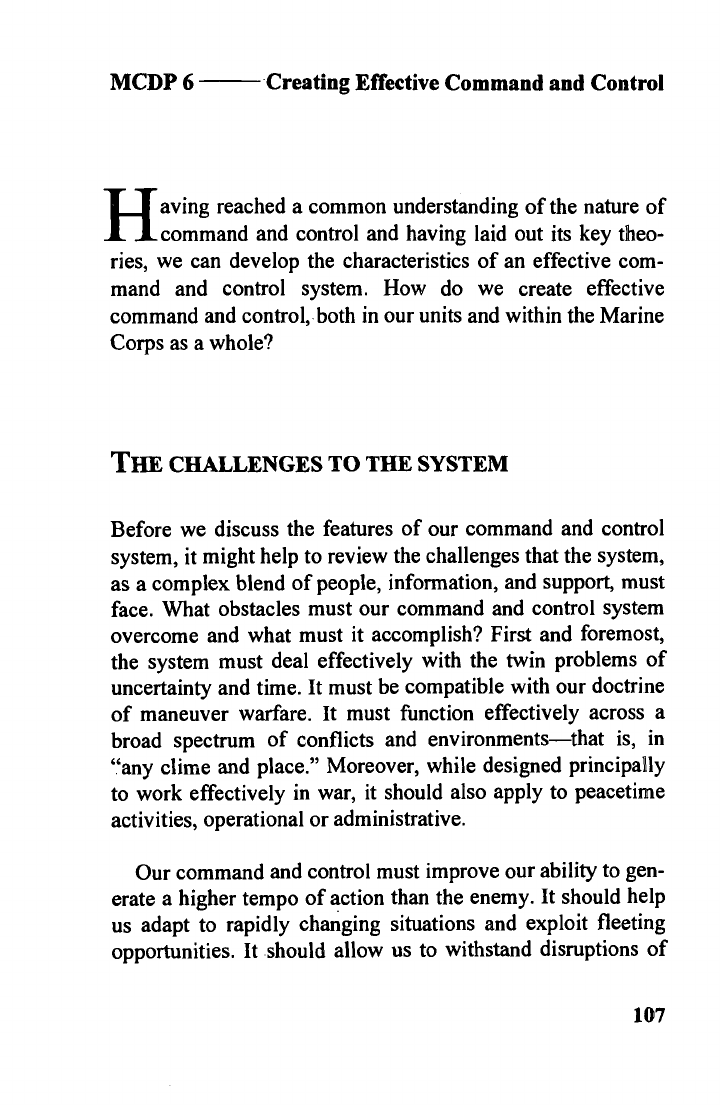
MCDP 6 Creating Effective Command and Control
H
aving reached a common understanding of the nature of
command and control and having laid out its key theo-
ries, we can develop the characteristics of an effective com-
mand and control system. How do we create effective
command and control, both in our units and within the Marine
Corps as a whole?
Tm CHALLENGES TO TILE SYSTEM
Before we discuss the features of our command and control
system, it might help to review the challenges that the system,
as a complex blend of people, information, and support, must
face. What obstacles must our command and control system
overcome and what must it accomplish? First and foremost,
the system must deal effectively with the twin problems of
uncertainty and time. It must be compatible with our doctrine
of maneuver warfare. It must function effectively across a
broad spectrum of conflicts and environments—that is,
in
"any clime and place." Moreover, while designed principally
to work effectively in war, it should also apply to peacetime
activities, operational or administrative.
Our command and control must improve our ability to gen-
erate a higher tempo of action than the enemy. It should help
us adapt to rapidly changing situations and exploit fleeting
opportunities. It should allow us to withstand disruptions of
107

Command and Control
MCDP 6
all kinds, created by the enemy, the environment, or our-
selves, since we recognize that disruption will be a normal
course of events. It should help to gather information quickly,
accurately, and selectively and to get the right information to
the right person at the right time and in the right form—with-
out creating information overload. It should improve our abil-
ity to build and share situational awareness.
Our command and control should help provide insight into
the nature of the problem facing us and into the nature and
designs of our enemy. It should help us to identify critical en-
emy vulnerabilities and should provide the means for focus-
ing our efforts against those vulnerabilities. At the same time,
it should help conceal our true designs from the enemy. It
should help establish goals which are both meaningful and
practicable, and it should help devise workable, flexible plans
to accomplish those goals.
It should facilitate making timely and sound decisions de-
spite incomplete and unclear information, and it should pro-
vide the means to modify those decisions quickly. It should
allow us to monitor events closely enough to ensure proper
execution, yet without interfering with subordinates' actions.
It should help us communicate instructions quickly, clearly,
and concisely and in a way that provides subordinates the
necessary guidance without inhibiting their initiative.
With this in mind, what should such a command and con-
trol system look like?
108
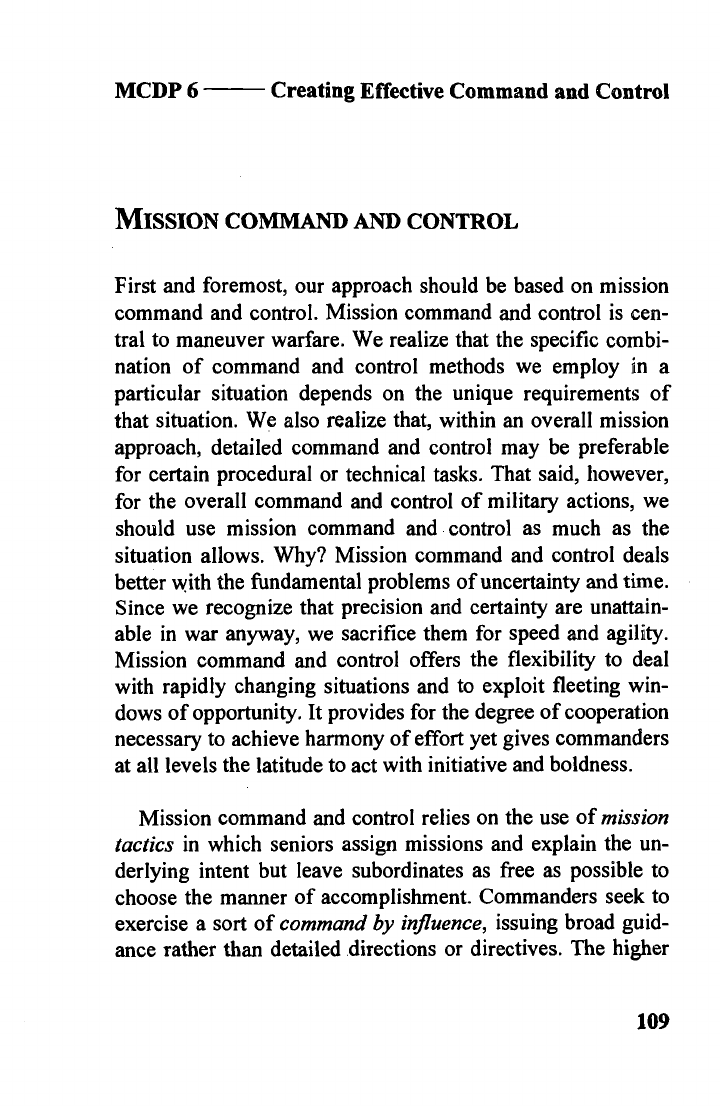
MCDP 6
Creating Effective Command and Control
MISSION COMMAND AN)) CONTROL
First and foremost, our approach should be based on mission
command and control. Mission command and control is cen-
tral to maneuver warfare. We realize that the specific combi-
nation of command and control methods we employ in a
particular situation depends on the unique requirements of
that situation. We also realize that, within an overall mission
approach, detailed command and control may be preferable
for certain procedural or technical tasks. That said, however,
for the overall command and control of military actions, we
should use mission command and control as much as the
situation allows. Why? Mission command and control deals
better with the fundamental problems of uncertainty and time.
Since we recognize that precision and certainty are unattain-
able in war anyway, we sacrifice them for speed and agility.
Mission command and control offers the flexibility to deal
with rapidly changing situations and to exploit fleeting win-
dows of opportunity. It provides for the degree of cooperation
necessary to achieve harmony of effort yet gives commanders
at all levels the latitude to act with initiative and boldness.
Mission command and control relies on the use of mission
tactics in which seniors assign missions and explain the un-
derlying intent but leave subordinates as free as possible to
choose the manner of accomplishment. Commanders seek to
exercise a sort of command by influence, issuing broad guid-
ance rather than detailed directions or directives. The higher
109
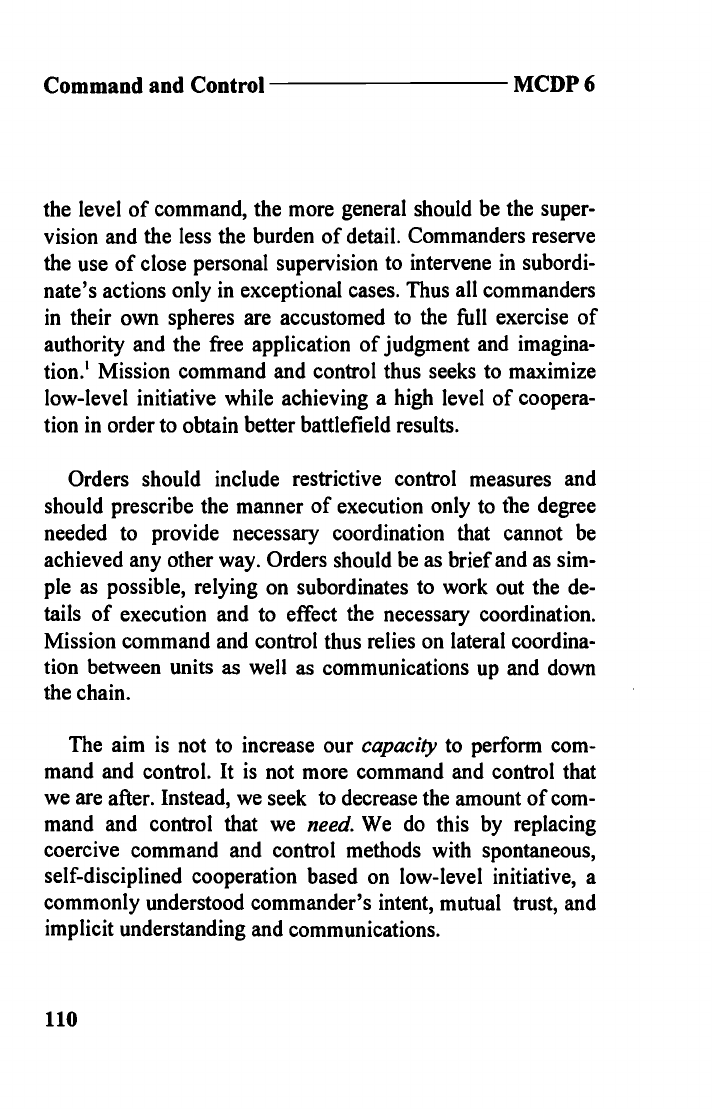
Command and Control
MCDP 6
the level of command, the more general should be the super-
vision and the less the burden of detail. Commanders reserve
the use of close personal supervision to intervene in subordi-
nate's actions only in exceptional cases. Thus all commanders
in their own spheres are accustomed to the full exercise of
authority and the free application of judgment and imagina-
tion.' Mission command and control thus seeks to maximize
low-level initiative while achieving a high level of coopera-
tion in order to obtain better battlefield results.
Orders should include restrictive control measures and
should prescribe the manner of execution only to the degree
needed to provide necessary coordination that cannot be
achieved any other way. Orders should be as brief and as sim-
ple as possible, relying on subordinates to work out the de-
tails of execution and to effect the necessary coordination.
Mission command and control thus relies on lateral coordina-
tion between units as well as communications up and down
the chain.
The aim is not to increase our capacily to perform com-
mand and control. It is not more command and control that
we are after. Instead, we seek to decrease the amount of com-
mand and control that we need. We do this by replacing
coercive command and control methods with spontaneous,
self-disciplined cooperation based on low-level initiative, a
commonly understood commander's intent, mutual trust, and
implicit understanding and communications.

MCDP 6
Creating Effective Command and Control
LOW-LEVEL Th1TIAT1VE
Initiative is an essential element of mission command and
control since subordinates must be able to act without instruc-
tions. Our warfare doctrine emphasizes seeking and rapidly
exploiting fleeting opportunities, possible only through low-
level initiative. Initiative hinges on distributing the authority
to decide and act throughout an organization rather than lo-
calizing it in one spot. And as we have already discussed,
where there is authority, there is also responsibility. Being
free to act on their own authority, subordinates must accept
the corresponding responsibility to act.
Our command and control must be biased toward decision
and action at all levels. Put another way, the command and
control process must be self-starting at every level of com-
mand as all commanders within their own spheres act upon
the need for action rather than only on orders from above.
It is important to point out that initiative does not mean
that subordinates are free to act without regard to guidance
from above. In fact, initiative places a special burden on sub-
ordinates, requiring that they always keep the larger situation
in mind and act in consonance with their senior's intent. The
freedom to act with initiative thus implies a greater obliga-
tion to act in a disciplined and responsible way. Initiative
places a greater burden on the senior as well. Delegating
authority to subordinates does not absolve higher command-
111
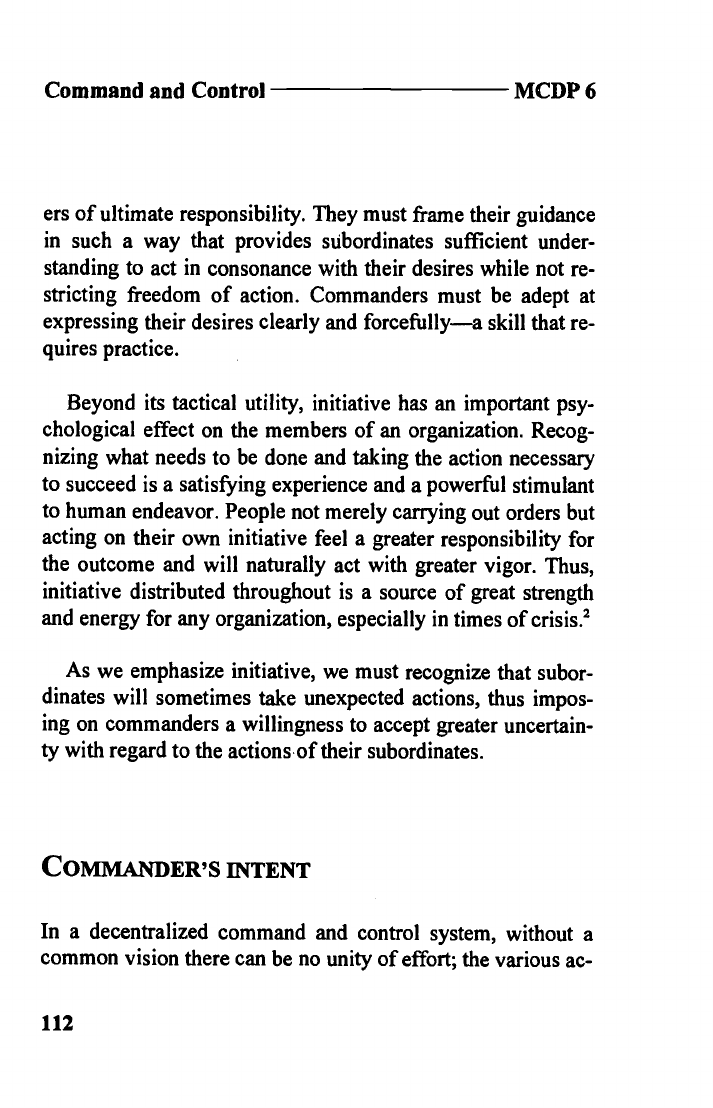
Command and Control
MCDP 6
ers of ultimate responsibility. They must frame their guidance
in such a way that provides subordinates sufficient under-
standing to act in consonance with their desires while not re-
stricting freedom of action. Commanders must be adept at
expressing their desires clearly and forcefiilly—a skill that re-
quires practice.
Beyond its tactical utility, initiative has an important psy-
chological effect on the members of an organization. Recog-
nizing what needs to be done and taking the action necessary
to succeed is a satisfying experience and a powerful stimulant
to human endeavor. People not merely carrying out orders but
acting on their own initiative feel a greater responsibility for
the outcome and will naturally act with greater vigor. Thus,
initiative distributed throughout is a source of great strength
and energy for any organization, especially in times of crisis.2
As we emphasize initiative, we must recognize that subor-
dinates will sometimes take unexpected actions, thus impos-
ing on commanders a willingness to accept greater uncertain-
ty with regard to the actionsof their subordinates.
Colnt4rER's INTENT
In a decentralized command and control system, without a
common vision there can be no unity of effort; the various ac-
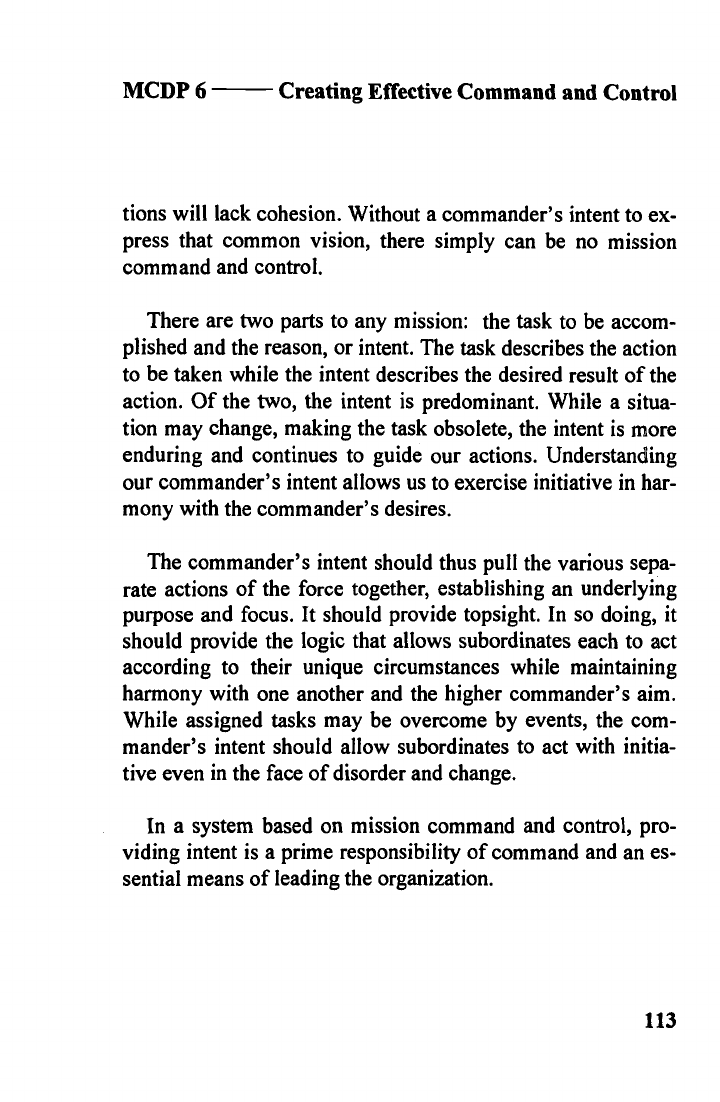
MCDP 6
Creating Effective Command and Control
tions will lack cohesion. Without a commander's intent to ex-
press that common vision, there simply can be no mission
command and control.
There are two parts to any mission: the task to be accom-
plished and the reason, or intent. The task describes the action
to be taken while the intent describes the desired result of the
action. Of the two, the intent is predominant. While a situa-
tion may change, making the task obsolete, the intent is more
enduring and continues to guide our actions. Understanding
our commander's intent allows us to exercise initiative in har-
mony with the commander's desires.
The commander's intent should thus pull the various sepa-
rate actions of the force together, establishing an underlying
purpose and focus. It should provide topsight. In so doing, it
should provide the logic that allows subordinates each to act
according to their unique circumstances while maintaining
harmony with one another and the higher commander's aim.
While assigned tasks may be overcome by events, the com-
mander's intent should allow subordinates to act with initia-
tive even in the face of disorder and change.
In a system based on mission command and control, pro-
viding intent is a prime responsibility of command and an es-
sential means of leading the organization.

Command and Control
MCDP 6
M!rruAJ. TRUST
Mission command and control demands mutual trust among
all commanders, staffs, and Marines—confidence in the abili-
ties and judgment of subordinates, peers, and seniors. Trust is
the cornerstone of cooperation. It is a function of familiarity
and respect. A senior trusts subordinates to carry out the as-
signed missions competently with minimal supervision, act in
consonance with the overall intent, report developments as
necessary, and effect the necessary coordination. Subordi-
nates meanwhile trust that the senior will provide the neces-
sary guidance and will support them loyally and fully, even
when they make mistakes.
Trust has a reverse side: it must be earned as well as
given. We earn the trust of others by demonstrating compe-
tence, a sense of responsibility, loyalty, and self-discipline.
This last is essential. Discipline is of fundamental importance
in any military endeavor, and strict military discipline re-
mains a pillar of command authority. But since mission com-
mand and control is decentralized rather than centralized and
spontaneous rather than coercive, discipline is not only im-
posed from above; it must also be generated from within.
In order to earn a senior's trust, subordinates must demon-
strate the self-discipline to accomplish the mission with mini-
mal supervision and to act always in accord with the larger
intent. Seniors, in order to earn subordinates' trust, must like-
wise demonstrate that they will provide the subordinate the
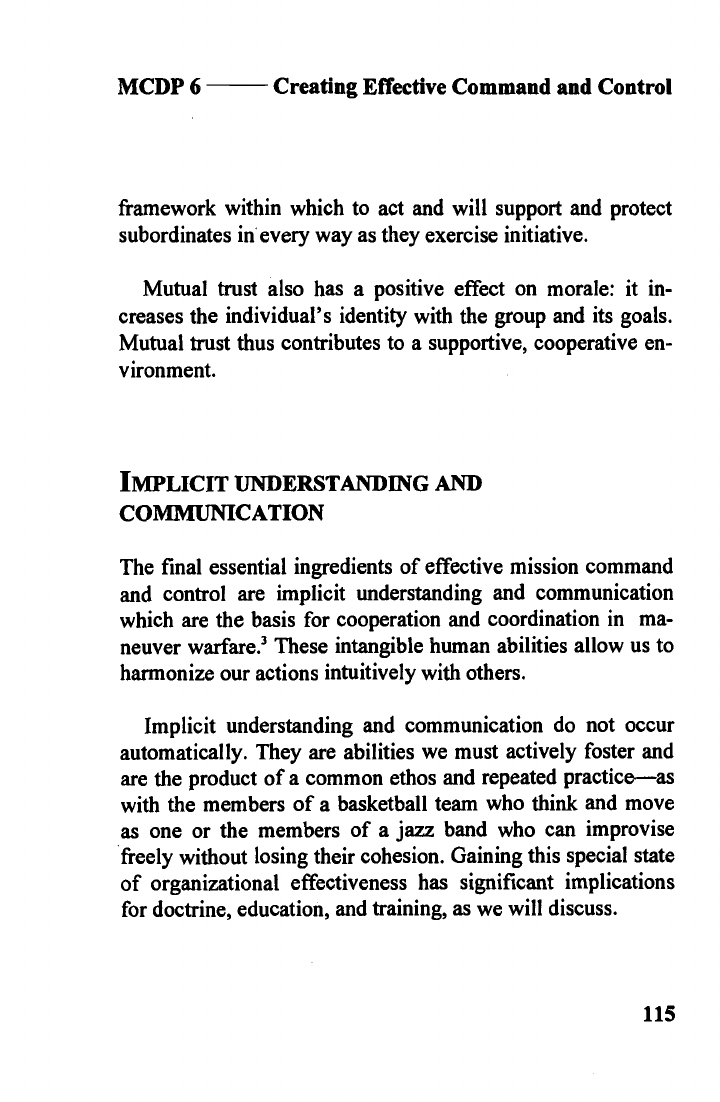
MCDP 6
Creating Effective Command and Control
framework within which to act and will support and protect
subordinates in every way as they exercise initiative.
Mutual trust also has a positive effect on morale: it in-
creases the individual's identity with the group and its goals.
Mutual trust thus contributes to a supportive, cooperative en-
vironment.
IMPLICIT UNDERSTANDING AND
COMMUNICATION
The final essential ingredients of effective mission command
and control are implicit understanding and communication
which are the basis for cooperation and coordination in ma-
neuver warfare.3 These intangible human abilities allow us to
harmonize our actions intuitively with others.
Implicit understanding and communication do not occur
automatically. They are abilities we must actively foster and
are the product of a common ethos and repeated practice—as
with the members of a basketball team who think and move
as one or the members of a jazz band who can improvise
freely without losing their cohesion. Gaining this special state
of organizational effectiveness has significant implications
for doctrine, education, and training, as we will discuss.
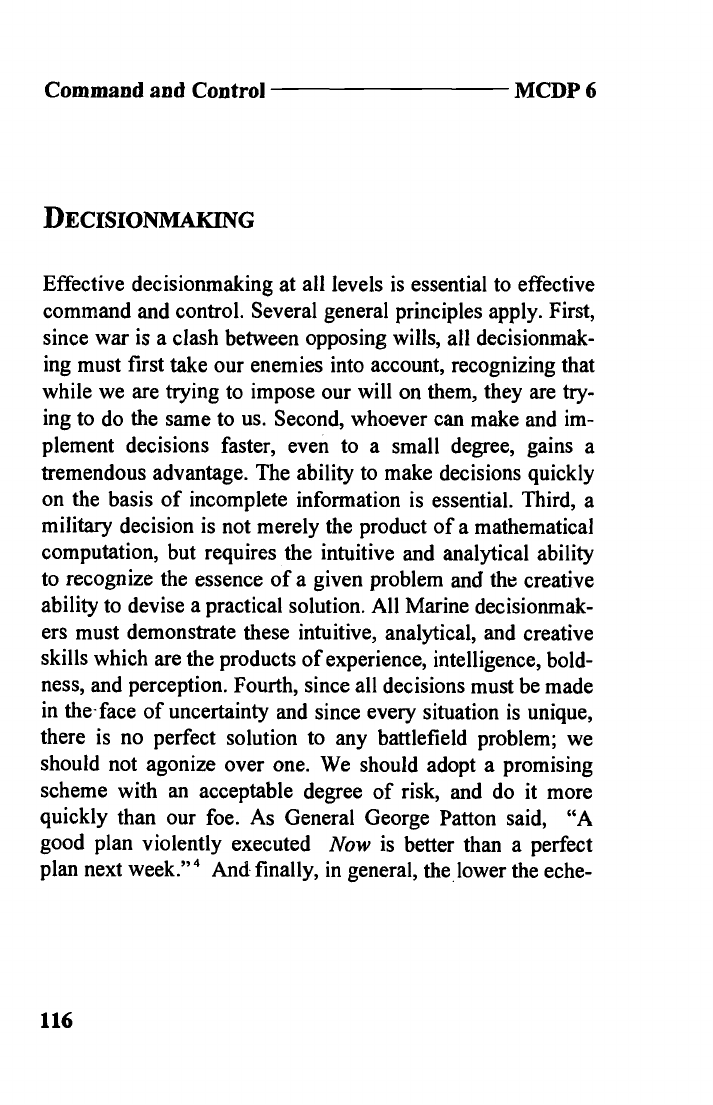
Command and Control
MCDP 6
DEcrsIoiAxi1G
Effective decisionmaking at all levels is essential to effective
command and control. Several general principles apply. First,
since war is a clash between opposing wills, all decisionmak-
ing must first take our enemies into account, recognizing that
while we are trying to impose our will on them, they are try-
ing to do the same to us. Second, whoever can make and im-
plement decisions faster, even to a small degree, gains a
tremendous advantage. The ability to make decisions quickly
on the basis of incomplete information is essential. Third, a
military decision is not merely the product of a mathematical
computation, but requires the intuitive and analytical ability
to recognize the essence of a given problem and the creative
ability to devise a practical solution. All Marine decisionmak-
ers must demonstrate these intuitive, analytical, and creative
skills which are the products of experience, intelligence, bold-
ness, and perception. Fourth, since all decisions must be made
in the-face of uncertainty and since every situation is unique,
there is no perfect solution to any battlefield problem; we
should not agonize over one. We should adopt a promising
scheme with an acceptable degree of risk, and do it more
quickly than our foe. As General George Patton said,
"A
good plan violently executed Now is better than a perfect
plan next week."4 And finally, in general, the lower the eche-
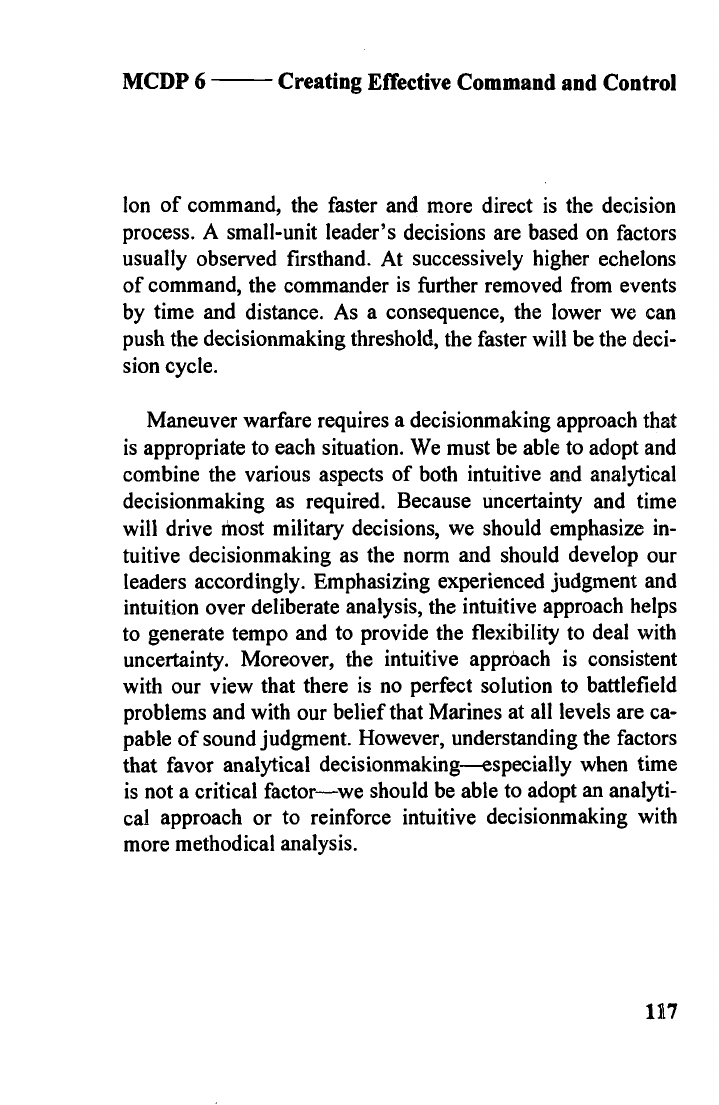
MCDP 6
Creating Effective Command and Control
Ion of command, the faster and more direct is the decision
process. A small-unit leader's decisions are based on factors
usually observed firsthand. At successively higher echelons
of command, the commander is further removed from events
by time and distance. As a consequence, the lower we can
push the decisionmaking threshold, the faster will be the deci-
sion cycle.
Maneuver warfare requires a decisionmaking approach that
is appropriate to each situation. We must be able to adopt and
combine the various aspects of both intuitive and analytical
decisionmaking as required. Because uncertainty and time
will drive most military decisions, we should emphasize in-
tuitive decisionmaking as the norm and should develop our
leaders accordingly. Emphasizing experienced judgment and
intuition over deliberate analysis, the intuitive approach helps
to generate tempo and to provide the flexibility to deal with
uncertainty. Moreover, the intuitive approach is consistent
with our view that there is no perfect solution to battlefield
problems and with our belief that Marines at all levels are ca-
pable of sound judgment. However, understanding the factors
that favor analytical decisionmaking—especially when time
is not a critical factor—we should be able to adopt an analyti-
cal approach or to reinforce intuitive decisionmaking with
more methodical analysis.
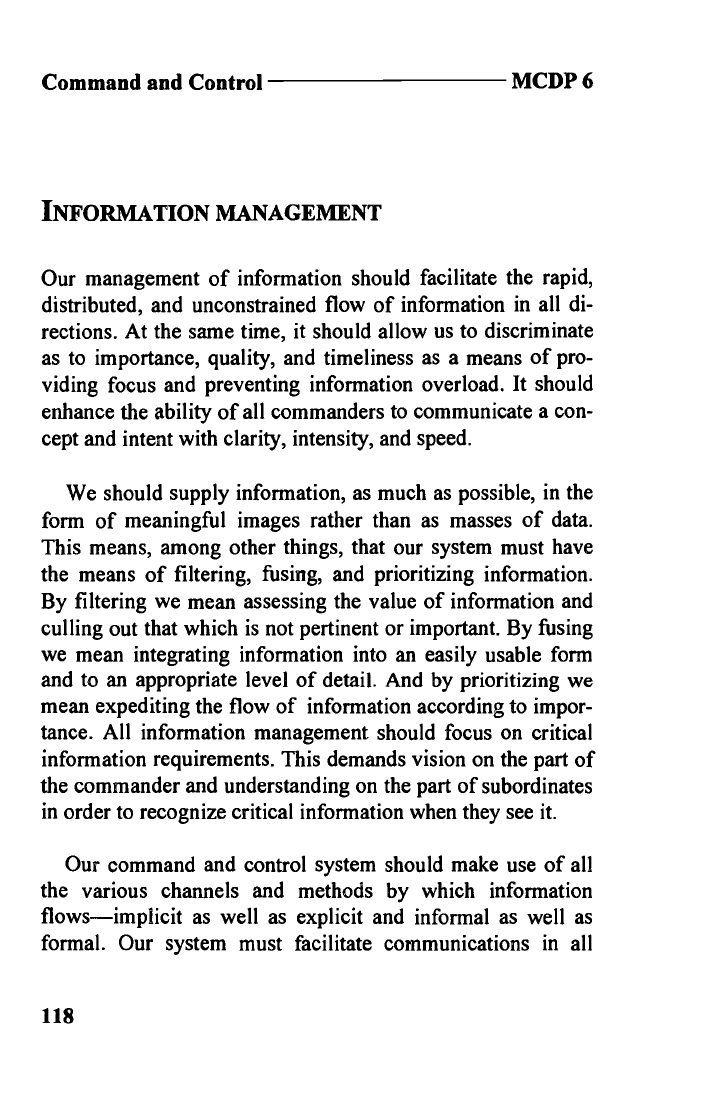
Command and Control
MCDP 6
INFORMATION MANAGEMENT
Our management of information should facilitate the rapid,
distributed, and unconstrained flow of information in all di-
rections. At the same time, it should allow us to discriminate
as to importance, quality, and timeliness as a means of pro-
viding focus and preventing information overload. It should
enhance the ability of all commanders to communicate a con-
cept and intent with clarity, intensity, and speed.
We should supply information, as much as possible, in the
form of meaningful images rather than as masses of data.
This means, among other things, that our system must have
the means of filtering, fusing, and prioritizing information.
By filtering we mean assessing the value of information and
culling out that which is not pertinent or important. By fusing
we mean integrating information into an easily usable form
and to an appropriate level of detail. And by prioritizing we
mean expediting the flow of information according to impor-
tance. All information management should focus on critical
information requirements. This demands vision on the part of
the commander and understanding on the part of subordinates
in order to recognize critical information when they see it.
Our command and control system should make use of all
the various channels and methods by which information
flows—implicit as well as explicit and informal as well as
formal. Our system must facilitate communications in all

MCDP 6
Creating Effective Command and Control
directions, not only vertically within the chain of command,
and should ensure that information flow is interactive rather
than one-way. Our system should provide redundant channels
as a safeguard against disruption and battle damage; which
channel information follows is less important than whether it
reaches the right destination.
Since information is changed by each person who han-
dles it, important information should pass directly between
principal users, eliminating intermediaries, such as equipment
operators or clerks. Wherever possible, person-to-person in-
formation should be communicated by word of mouth and
face-to-face since humans communicate not only by what
they say but also by how they say it. The desire to have prin-
cipals communicate directly and by voice does not mean that
we do not need to keep a record of communications; perma-
nent records can be important as a means of affirming under-
standing and for reasons of later study and critique.
Our information management system should be a hybrid
exhibiting the judicious combination of broadcast and point-
to-point transmission and supply-push and demand-pull.5
Generic information of value to many users at a variety of
echelons may be broadcast, the transmission method which
reaches the broadest audience most quickly. However, we
must exercise discipline with respect to broadcast transmis-
sions to avoid the danger of information overload. In com-
parison, we should use point-to-point
transmission for
119
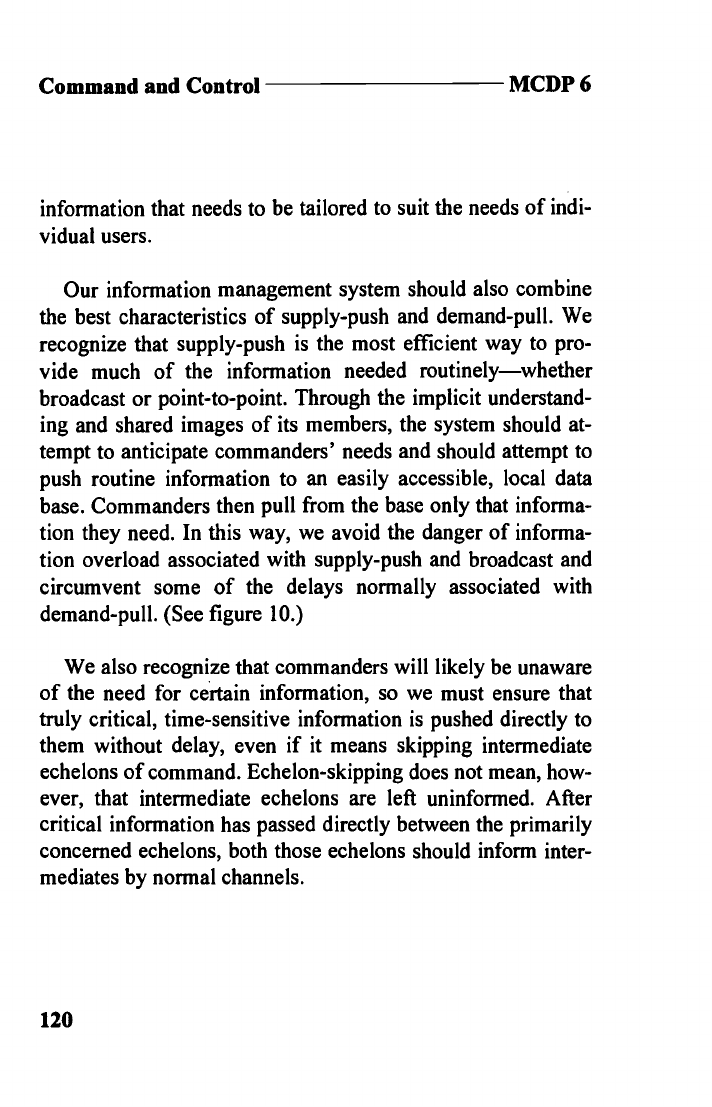
Command and Control
MCDP 6
information that needs to be tailored to suit the needs of indi-
vidual users.
Our information management system should also combine
the best characteristics of supply-push and demand-pull. We
recognize that supply-push is the most efficient way to pro-
vide much of the information needed routinely—whether
broadcast or point-to-point. Through the implicit understand-
ing and shared images of its members, the system should at-
tempt to anticipate commanders' needs and should attempt to
push routine information to an easily accessible, local data
base. Commanders then pull from the base only that informa-
tion they need. In this way, we avoid the danger of informa-
tion overload associated with supply-push and broadcast and
circumvent some of the delays normally associated with
demand-pull. (See figure 10.)
We also recognize that commanders will likely be unaware
of the need for certain information, so we must ensure that
truly critical, time-sensitive information is pushed directly to
them without delay, even if it means skipping intermediate
echelons of command. Echelon-skipping does not mean, how-
ever, that intermediate echelons are left uninformed. After
critical information has passed directly between the primarily
concerned echelons, both those echelons should inform inter-
mediates by normal channels.
120
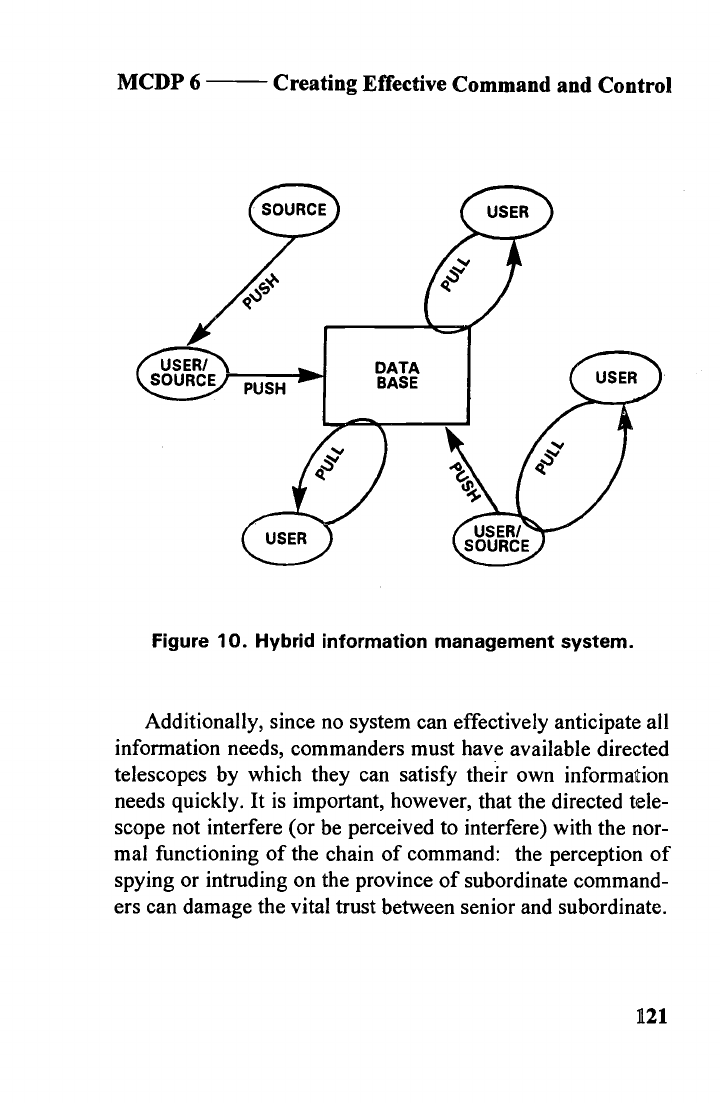
MCDP 6
Creating Effective Command and ControJ
Figure 10. Hybrid information management system.
Additionally,
since no system can effectively anticipate all
infonnation needs, commanders must have available directed
telescopes by which they can satisfy their own information
needs quickly. It is important, however, that the directed tele-
scope not interfere (or be perceived to interfere) with the nor-
mal functioning of the chain of command: the perception of
spying or intruding on the province of subordinate command-
ers can damage the vital trust between senior and subordinate.
t2 1

Command and Control
MCDP 6
LEADERSHIP
Because
people are the first and most important element of
our command and control system, strong and effective leader-
ship is of essential importance to our command and control.
Mission command and control requires predominantly a per-
suasive or delegating approach to leadership. It becomes the
role of the leaders to motivate Marines to perform to the high-
est standards and to instill self-discipline. Leadership is thus a
matter of enlisting the committed, enthusiastic, and loyal per-
formance of subordinates, both as a habitual quality and in
support of each specific mission. A good part of this comes
from keeping subordinates informed and from one's own
demonstration of commitment.
Mission command and control does not imply a deperson-
alized or detached demeanor. Since leaders who employ mis-
sion tactics are not overly involved in the details of execution,
one of their primary roles will thus be to provide the intent
which holds together the decentralized actions of subordi-
nates.
Another important role of leadership will be to create a
close-knit sense of team which is essential to developing trust
and understanding within the organization. Leaders should re-
inforce the common core values which are the basis for im-
plicit understanding and trust. Leaders should strive to create
an atmosphere of mutual support in which subordinates are
122
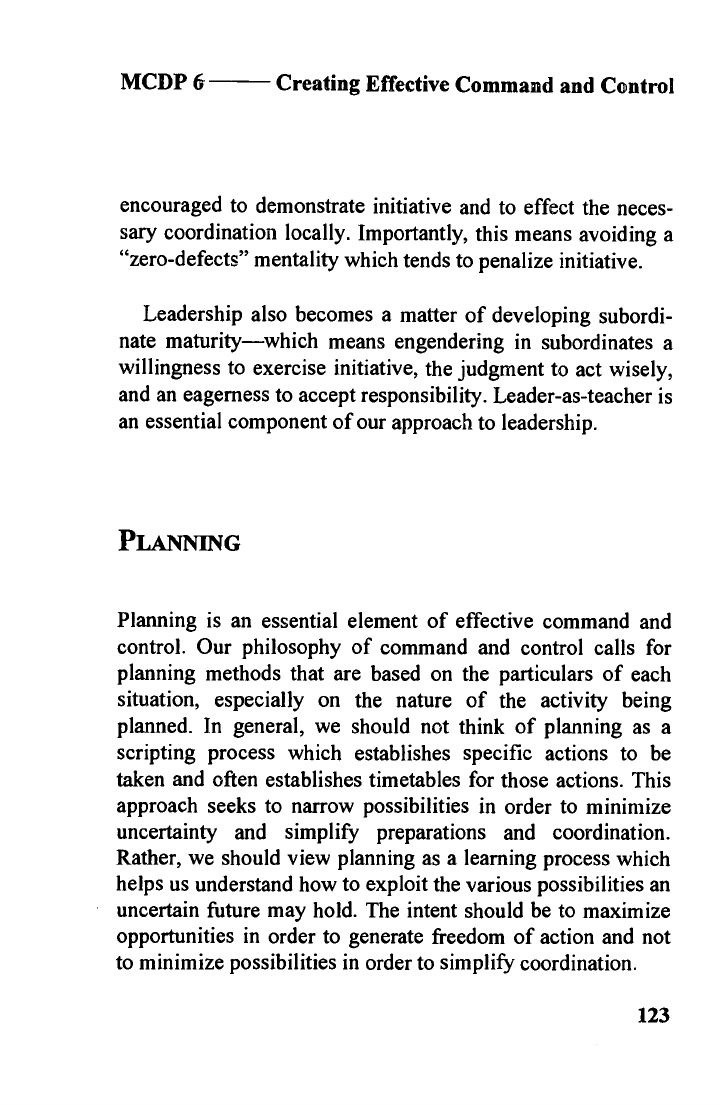
MCDP 6
Creating Effective Command and Control
encouraged to demonstrate initiative and to effect the neces-
sary coordination locally. Importantly, this means avoiding a
"zero-defects" mentality which tends to penalize initiative.
Leadership also becomes a matter of developing subordi-
nate maturity—which means engendering in subordinates a
willingness to exercise initiative, the judgment to act wisely,
and an eagerness to accept responsibility. Leader-as-teacher is
an essential component of our approach to leadership.
PLAIMNG
Planning
is an essential element of effective command and
control. Our philosophy of command and control calls for
planning methods that are based on the particulars of each
situation, especially on the nature of the activity being
planned. In general, we should not think of planning as a
scripting process which establishes specific actions to be
taken and often establishes timetables for those actions. This
approach seeks to narrow possibilities in order to minimize
uncertainty and simplify
preparations and coordination.
Rather, we should view planning as a learning process which
helps us understand how to exploit the various possibilities an
uncertain future may hold. The intent should be to maximize
opportunities in order to generate freedom of action and not
to minimize possibilities in order to simplify coordination.
123
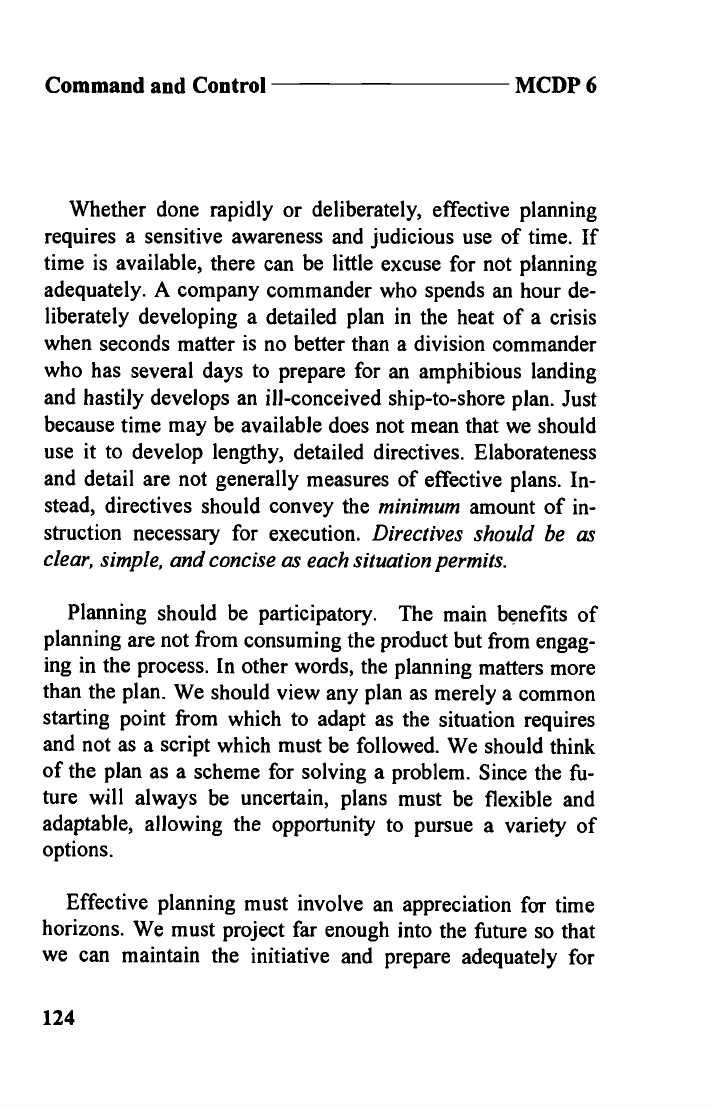
Command and Control MCDP 6
Whether done rapidly or deliberately, effective planning
requires a sensitive awareness and judicious use of time. If
time is available, there can be little excuse for not planning
adequately. A company commander who spends an hour de-
liberately developing a detailed plan in the heat of a crisis
when seconds matter is no better than a division commander
who has several days to prepare for an amphibious landing
and hastily develops an ill-conceived ship-to-shore plan. Just
because time may be available does not mean that we should
use it to develop lengthy, detailed directives. Elaborateness
and detail are not generally measures of effective plans. In-
stead, directives should convey the minimum
amount
of in-
struction necessary for execution. Directives should be as
clear, simple, and concise as each situation permits.
Planning should be participatory.
The main bcnefits of
planning are not from consuming the product but from engag-
ing in the process. In other words, the planning matters more
than the plan. We should view any plan as merely a common
starting point from which to adapt as the situation requires
and not as a script which must be followed. We should think
of the plan as a scheme for solving a problem. Since the fu-
ture will always be uncertain, plans must be flexible and
adaptable, allowing the opportunity to pursue a variety of
options.
Effective planning must involve an appreciation for time
horizons. We must project far enough into the future so that
we can maintain the initiative and prepare adequately for
124
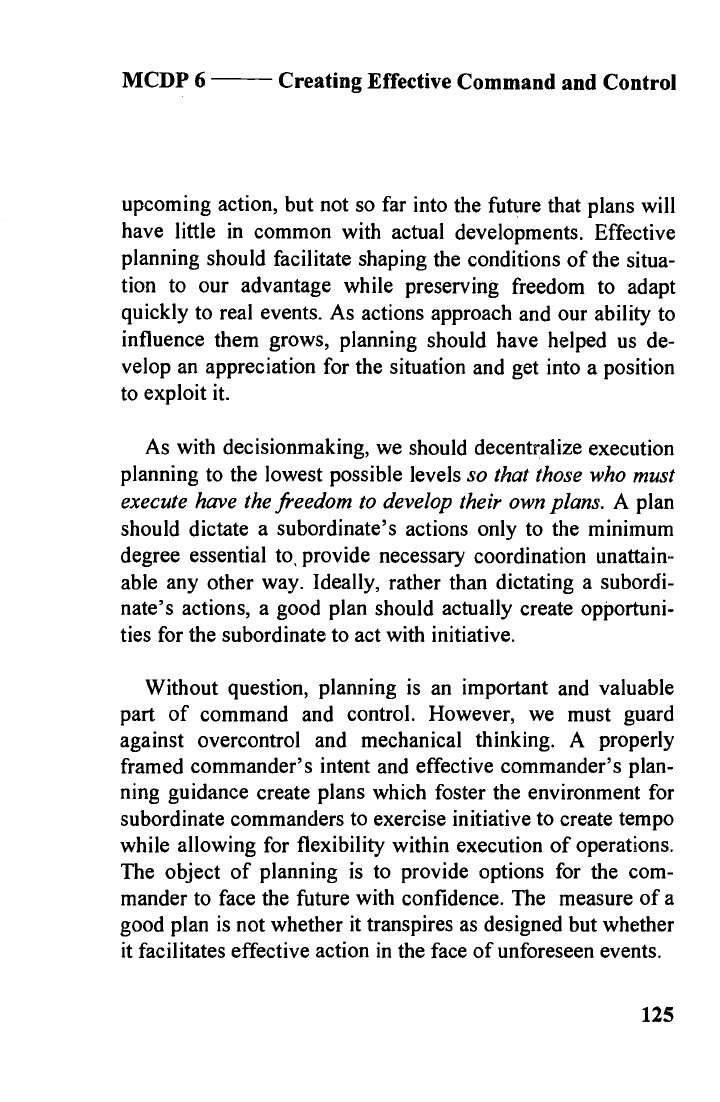
MCDP 6
Creating Effective Command and Control
upcoming action, but not so far into the future that plans will
have little in common with actual developments. Effective
planning should facilitate shaping the conditions of the situa-
tion to our advantage while preserving freedom to adapt
quickly to real events. As actions approach and our ability to
influence them grows, planning should have helped us de-
velop an appreciation for the situation and get into a position
to exploit it.
As with decisionniaking, we should decentralize execution
planning to the lowest possible levels so that those who must
execute have the freedom to develop their own plans. A plan
should dictate a subordinate's actions only to the minimum
degree essential to provide necessary coordination unattain-
able any other way. Ideally, rather than dictating a subordi-
nate's actions, a good plan should actually create opportuni-
ties for the subordinate to act with initiative.
Without question, planning is an important and valuable
part of command and control. However, we must guard
against overcontrol and mechanical thinking. A properly
framed commander's intent and effective commander's plan-
ning guidance create plans which foster the environment for
subordinate commanders to exercise initiative to create tempo
while allowing for flexibility within execution of operations.
The object of planning is to provide options for the com-
mander to face the future with confidence. The measure of a
good plan is not whether it transpires as designed but whether
it facilitates effective action in the face of unforeseen events.
125
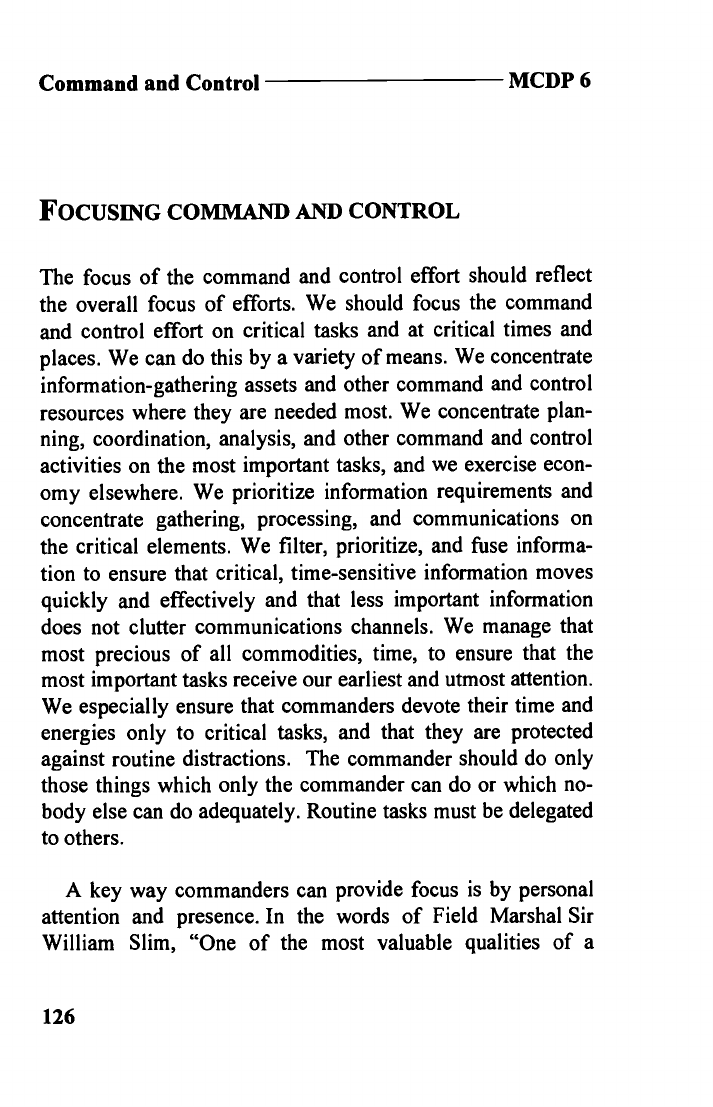
Command and Control
MCDP 6
FOCUSiNG COMMAI1) AND CONTROL
The focus of the command and control effort should reflect
the overall focus of efforts. We should focus the command
and control effort on critical tasks and at critical times and
places. We can do this by a variety of means. We concentrate
information-gathering assets and other command and control
resources where they are needed most. We concentrate plan-
ning, coordination, analysis, and other command and control
activities on the most important tasks, and we exercise econ-
omy elsewhere. We prioritize information requirements and
concentrate gathering, processing, and communications on
the critical elements. We filter, prioritize, and fuse informa-
tion to ensure that critical, time-sensitive information moves
quickly and effectively and that less important information
does not clutter communications channels. We manage that
most precious of all commodities, time, to ensure that the
most important tasks receive our earliest and utmost attention.
We especially ensure that commanders devote their time and
energies only to critical tasks, and that they are protected
against routine distractions. The commander should do only
those things which only the commander can do or which no-
body else can do adequately. Routine tasks must be delegated
to others.
A key way commanders can provide focus is by personal
attention and presence. In the words of Field Marshal Sir
William Slim, "One of the most valuable qualities of a
126

MCDP 6
Creating Effective Command and Control
commander is the flair for putting himself in the right place at
the vital time." As we have mentioned, by positioning them..
selves at the critical spot, commanders can observe events
more directly and avoid the delays and distortions that occur
as information fitters up the chain of command. In so doing,
commanders can gain firsthand the essential appreciation for
the situation which can rarely be gained any other way.
Equally important, they can influence events more directly
and avoid the delays and distortions that occur as information
filters down the chain of command. By their personal pres-
ence, commanders can provide the leadership that is so essen-
tial to success in war. And simply by the moral authority that
their presence commands, commanders direct emphasis to the
critical spot and focus efforts on the critical task.
We have discussed the need to gain several different im-
ages. Commanders go wherever they must to get the most im-
portant image. For the closeup image, this often means at the
front—which does. not necessarily mean at the forwardmost
point of contact on the ground, but wherever the critical ac-
tion is taking place or the critical situation is developing. For
ground commanders, even senior ones, this may in fact mean
at or near the point of contact. But for others, and even for
ground commanders, this may mean with a subordinate com-
mander in the critical sector—in a ready room listening to
flight debriefs during an important phase of an air operation,
at a critical point along a route of march, or in an aircraft fly-
ing over the battlefield. If the critical view at a particular mo-
ment is the overall picture, the commander may want to be in
127

Command and Control
MCDP 6
the command post's operations center, piecing together vari-
ous reports from far-flung sources, or even at a higher head-
quarters, learning about the larger situation (although in
general it is better for senior commanders to come forward
than for subordinate commanders to go rearward to exchange
information). And for that matter, if a commander is trying to
get inside the mind of an adversary who has made a bold and
unexpected move that has shattered situational awareness, the
best place may be sequestered from distractions,
sitting
against a tree, alone with a map.
Our philosophy of command calls for energetic and active
commanders with a flair, as Slim says, for being in the critical
place, lending leadership, judgment, and authority wherever it
is needed most. The commander might start at the command
post to piece together an overall image and supervise the de-
velopment of the plan, but should then usually move forward
to supervise execution at the critical spot, returning to the
command post only long enough to regenerate an image of
the overall situation before moving out again to the next criti-
cal spot. The important point is that commanders must not
feel tied to the command post, unable to leave it for fear of
missing a valuable report—especially since modem commu-
nications increasingly allow commanders to stay informed
even when away from the command post. When commanders
leave the command post, it is imperative that they empower
the staff to act on their behalf. The staff must be able to act
with initiative when the commander is away and therefore
must understand the commander's estimate of the situation,
128

MCDP 6
Creating Effective Command and Control
overall intent, and designs. Mutual trust and implicit under-
standing apply to the staff as much as to subordinate com-
manders. Commanders who do not empower the staff to act
on their behalf will become prisoners in their own headquar-
ters, out of touch with reality and limited in their ability to in-
fluence events.
Tiu COMMAND AND CONTROL SUPPORT
STRUCTURE
It is important to keep in mind that the command and control
support structure merely provides the supporting framework
for our command and control; it does not constitute the sys-
tem itself. The sole purpose of the support structure is to as-
sist people in recognizing what needs to be done and in taking
appropriate action. In addition to supporting our approach to
command and control, the components of our command and
control support structure must be compatible with one an-
other. And since people are the driving element behind com-
mand and control, the components of the structure, together
and alone, must be user-friendly—that is, designed first and
always with people in mind.
129

Command and Control
MCDP 6
TRAINING, EDUCATION, AND DOCTRINE
Collectively, training, education, and doctrine prepare people
for the roles they play in command and control. First, since
mission command and control demands initiative and sound
decisionmaking at all levels, training, education, and doctrine
must aim at fostering initiative and improving decisionmak-
ing ability among all Marines. It is not enough to allow initia-
tive; we must actively encourage and demand an eagerness to
accept responsibility. This means that we must develop an in-
stitutional prejudice for tolerating mistakes of action but not
inaction. Training and education should seek to develop in
leaders the pattern-recognition skills that are essential to in-
tuitive decisionmaking.
Second, training, education, and doctrine must prepare
Marines to function effectively in varying environments amid
uncertainty and disorder and with limited time. Exercise sce-
narios should purposely include elements of disorder and un-
certainty—an unexpected development or mission change, as
examples. Field exercises and command post exercises should
purposely include disruption of command and control, for ex-
ample, "destruction" of a main command post or loss of com-
munications during a critical phase of an evolution. Planning
exercises should incorporate severe time limits to simulate
stress and tempo. As Field Marshal Erwin Rommel said, "A
commander must accustom his staff to a high tempo from the
outset, and continuously keep them up to it."

MCDP 6
Creating Effective Command and Control
Third, education and training should teach the appropriate
use of techniques and procedures. Training should provide
techniques and procedures which emphasize
flexibility,
speed, and adaptability—fast and simple staff planning mod-
els, for example. Education should provide an understanding
of when to apply different techniques and procedures—when
to use intuitive or analytical decisionmaking techniques, for
example.
Last and perhaps most important, training, education, and
doctrine should provide a shared ethos, common experiences,
and a shared way of thinking as the basis for the trust, cohe-
sion, and implicit communication that are essential to maneu-
ver warfare command and control. They should establish a
common perspective on how Marines approach the problems
of command and control.
PROCEDURES
Used properly, procedures can be a source of organizational
competence—by improving a staff's efficiency or by increas-
ing planning tempo, for example. Procedures can be espe-
cially useful to improve the coordination among several
people who must cooperate in the accomplishment of repeti-
tive tasks—such as the internal functioning of a combat op-
erations center. Used improperly, however, procedures can
131
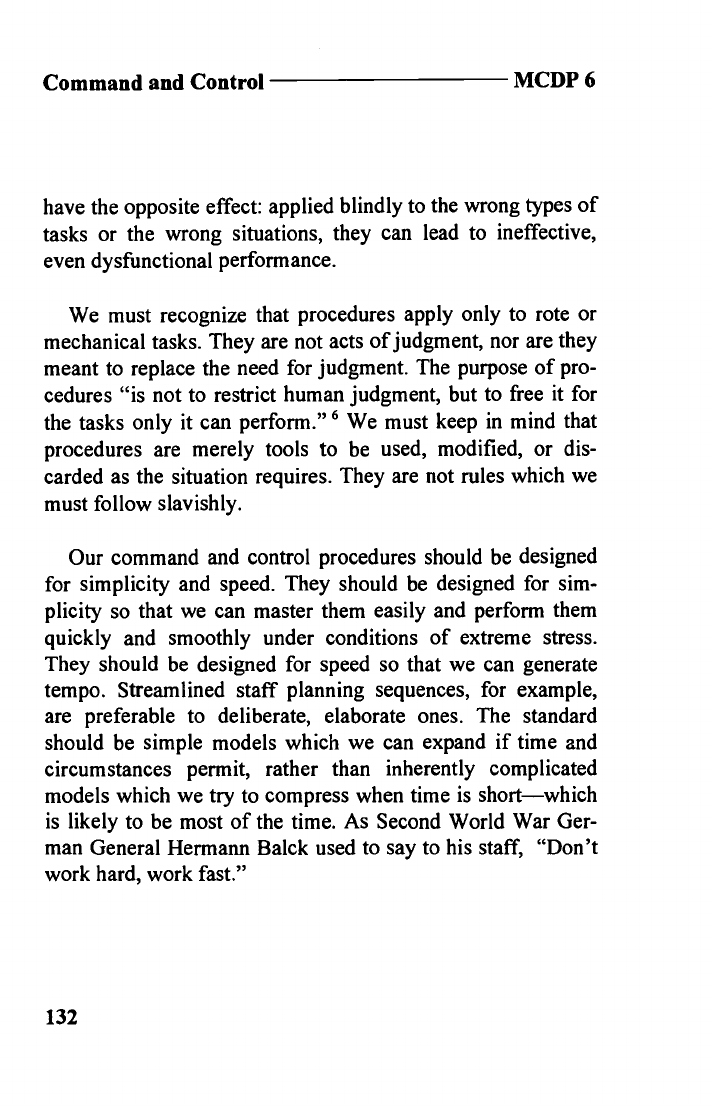
Command and Control
MCDP 6
have the opposite effect: applied blindly to the wrong types of
tasks or the wrong situations, they can lead to ineffective,
even dysfunctional performance.
We must recognize that procedures apply only to rote or
mechanical tasks. They are not acts of judgment, nor are they
meant to replace the need for judgment. The purpose of pro-
cedures "is not to restrict human judgment, but to free it for
the tasks only it can perform."
6
We
must keep in mind that
procedures are merely tools to be used, modified, or dis-
carded as the situation requires. They are not rules which we
must follow slavishly.
Our command and control procedures should be designed
for simplicity and speed. They should be designed for sim-
plicity so that we can master them easily and perform them
quickly and smoothly under conditions of extreme stress.
They should be designed for speed so that we can generate
tempo. Streamlined staff planning sequences, for example,
are preferable to deliberate, elaborate ones. The standard
should be simple models which we can expand if time and
circumstances permit, rather than inherently complicated
models which we try to compress when time is short—which
is likely to be most of the time. As Second World War Ger-
man General Hermann Balck used to say to his staff, "Don't
work hard, work fast."
132
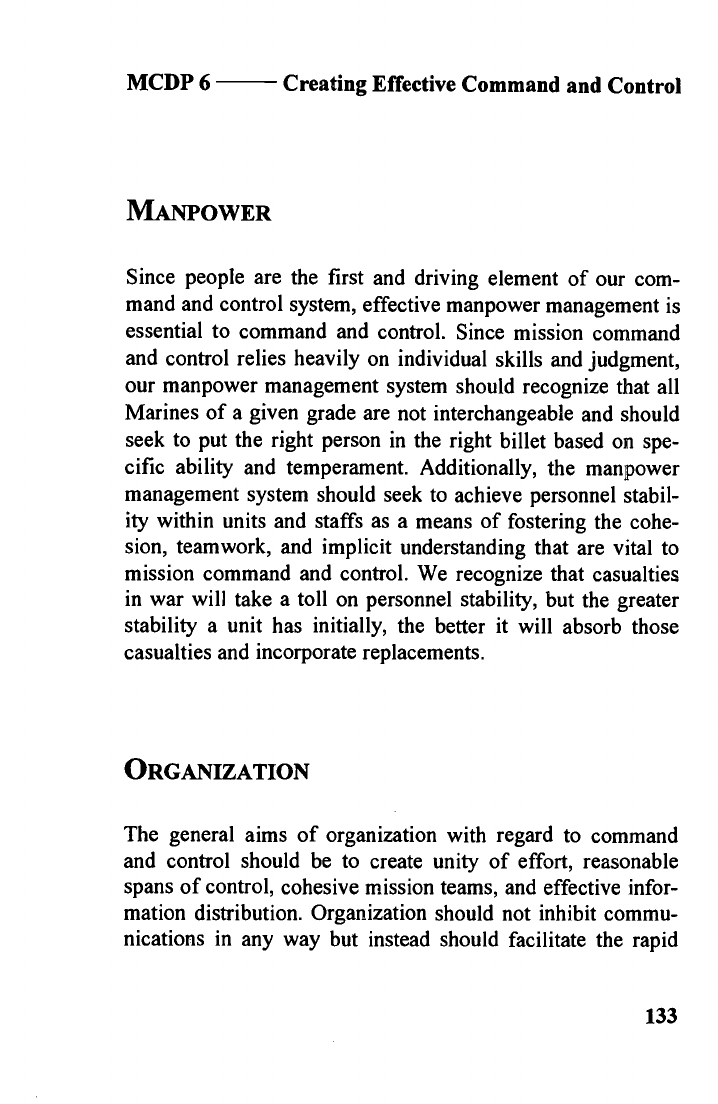
MCDP 6
Creating Effective Command and Control
MANPOWER
Since people are the first and driving element of our com-
mand and control system, effective manpower management is
essential to command and control. Since mission command
and control relies heavily on individual skills and judgment,
our manpower management system should recognize that all
Marines of a given grade are not interchangeable and should
seek to put the right person in the right billet based on spe-
cific ability and temperament. Additionally, the manpower
management system should seek to achieve personnel stabil-
ity within units and staffs as a means of fostering the cohe-
sion, teamwork, and implicit understanding that are vital to
mission command and control. We recognize that casualties
in war will take a toll on personnel stability, but the greater
stability a unit has initially, the better it will absorb those
casualties and incorporate replacements.
ORGANIZATION
The general aims of organization with regard to command
and control should be to create unity of effort, reasonable
spans of control, cohesive mission teams, and effective infor-
mation distribution. Organization should not inhibit commu-
nications in any way but instead should facilitate the rapid
133

Command and Control
MCDP 6
distribution of information in all directions and should pro-
vide feedback channels.
In general, we should take a flexible approach to organiza-
tion, maintaining the capability to task-organize our forces to
suit the situation which might include the creation of nonstan-
dard and temporary task groupings. However, the commander
must reconcile this desire for organizational flexibility with
the need to create implicit understanding and mutual trust
which are the product of familiarity and stable working rela-
tionships.
Mission command and control requires the creation of self-
reliant task groups capable of acting semiautonomously. By
task-organizing into self-reliant task groups, we increase each
commander's freedom of action and at the same time de-
crease the need for centralized coordination of support.
We should seek to strike a balance between "width" and
"depth" so that the organization is suited to the particular
situation. The aim is to flatten the organization to the greatest
extent compatible with reasonable spans of control. Com-
manders should have the flexibility to eliminate or bypass se-
lected echelons of command or staff as appropriate in order to
improve operational tempo. Additionally, it is not necessary
that all echelons of command exercise all functions of com-
mand. Just as we task-organize our force, so should we task-
organize our command and control structure.
134
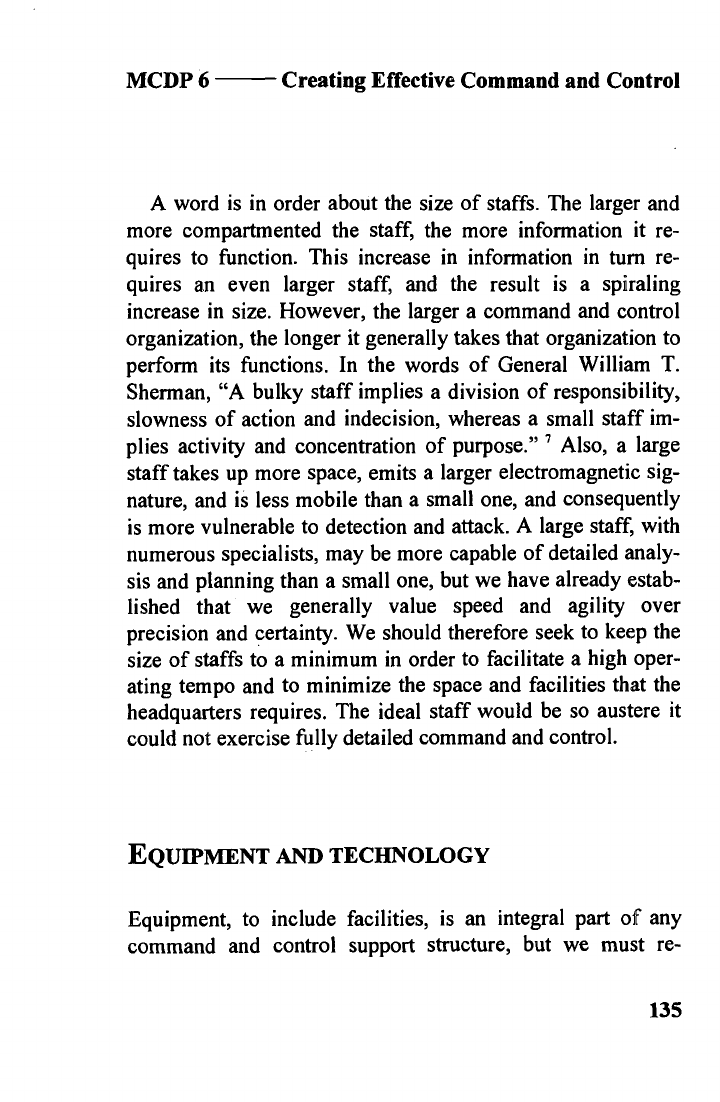
MCDP 6
Creating Effective Command and Control
A word is in order about the size of staffs. The larger and
more compartmented the staff, the more information it re-
quires to function. This increase in information in turn re-
quires an even larger staff, and the result is a spiraling
increase in size. However, the larger a command and control
organization, the longer it generally takes that organization to
perform its functions. In the words of General William T.
Sherman, "A bulky staff implies a division of responsibility,
slowness of action and indecision, whereas a small staff im-
plies activity and concentration of purpose."
Also, a large
staff takes up more space, emits a larger electromagnetic sig-
nature, and is less mobile than a small one, and consequently
is more vulnerable to detection and attack. A large staff, with
numerous specialists, may be more capable of detailed analy-
sis and planning than a small one, but we have already estab-
lished
that we generally value speed and agility over
precision and certainty. We should therefore seek to keep the
size of staffs to a minimum in order to facilitate a high oper-
ating tempo and to minimize the space and facilities that the
headquarters requires. The ideal staff would be so austere it
could not exercise fully detailed command and control.
EQuipi'LENT
AND
TECHNOLOGY
Equipment, to include facilities, is an integral part of any
command and control support structure, but we must re-
135
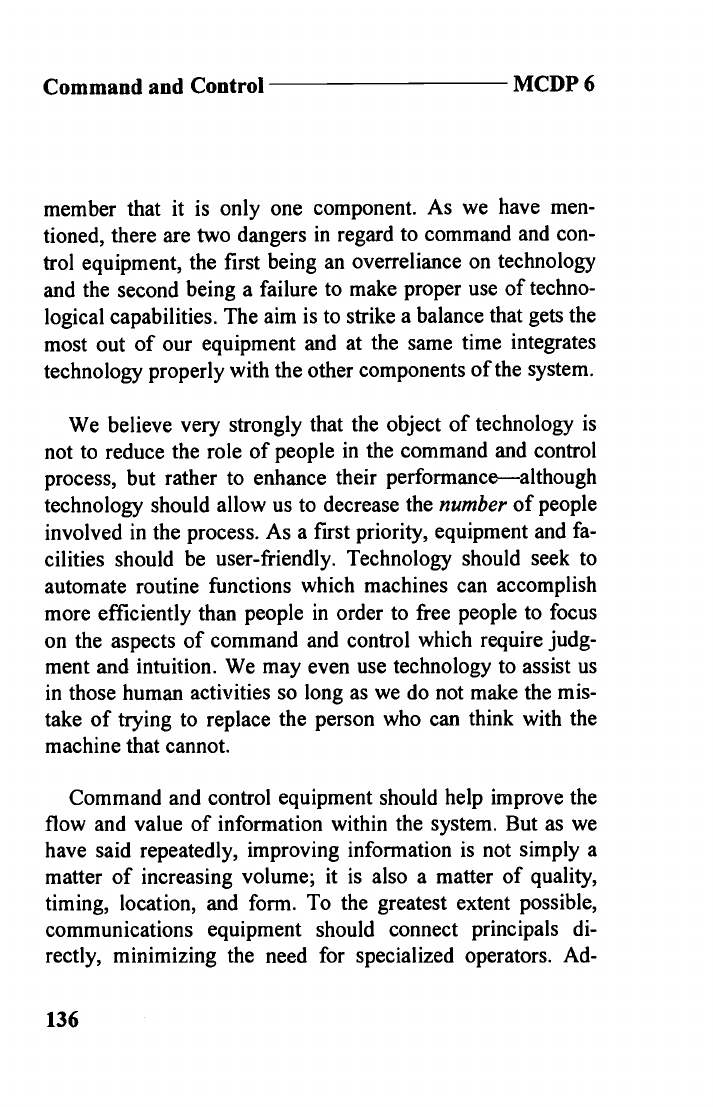
Command and Control
MCDP 6
member that it is only one component. As we have men-
tioned, there are two dangers in regard to command and con-
trol equipment, the first being an overreliance on technology
and the second being a failure to make proper use of techno-
logical capabilities. The aim is to strike a balance that gets the
most out of our equipment and at the same time integrates
technology properly with the other components of the system.
We believe very strongly that the object of technology is
not to reduce the role of people in the command and control
process, but rather to enhance their performance—although
technology should allow us to decrease the number of people
involved in the process. As a first priority, equipment and fa-
cilities should be user-friendly. Technology should seek to
automate routine functions which machines can accomplish
more efficiently than people in order to free people to focus
on the aspects of command and control which require judg-
ment and intuition. We may even use technology to assist us
in those human activities so long as we do not make the mis-
take of trying to replace the person who can think with the
machine that cannot.
Command and control equipment should help improve the
flow and value of information within the system. But as we
have said repeatedly, improving information is not simply a
matter of increasing volume; it
is also a matter of quality,
timing, location, and form. To the greatest extent possible,
communications equipment should connect principals di-
rectly, minimizing the need for specialized operators. Ad-
136

MCDP 6
Creating Effective Command and Control
ditionally, equipment should minimize the input burden
placed on people; ideally, the input of information into the
system should be automatic. Last, but hardly least, techno-
logical developments should focus on presenting information
in a way that is most useful to humans—that is, in the form of
meaningful visual images rather than lists of data.
As with all the components of our command and control
support structure,
our command and control equipment
should be consistent with our overall approach to command
and control. For example, equipment that facilitates or en-
courages the micromanagement of subordinate units is incon-
sistent with our command and control philosophy. Moreover,
such technological capability tends to fix the senior's atten-
tion at too low a level of detail. A regimental commander, for
example, does not as a rule need to keep track of the
movements of every squad (although with position-locating
technology it may be a temptation); a regimental commander
needs a more general appreciation for the flow of action.
Commanders who focus at too low a level of detail (whether
because the technology tempts them to or not) risk losing
sight of the larger picture.
The reality of technological development is that equipment
which improves the ability to monitor what is happening may
also increase the temptation and the means to try to direct
what is happening. Consequently, increased capability on the
part of equipment brings with it the need for increased under-
standing and discipline on the part of users. Just because our
137

Command and Control
MCDP 6
technology allows us to micromanage does not mean that we
should.
CONCLUSION
Our approach to command and control recognizes and accepts
war as a complex, uncertain, disorderly, and time-competitive
clash of wills and seeks to provide the commander the best
means to win in that environment. We seek to exploit trust,
cooperation, judgment, focus, and implicit understanding to
lessen the effects of the uncertainty and friction that are con-
sequences of war's nature. We rely on mission command and
control to provide the flexibility and responsiveness to deal
with uncertainty and to generate the tempo which we recog-
nize is a key element of success in war. We focus on the
value and timeliness of information, rather than on the
amount, and on getting that information to the right people in
the right form. We seek to strike a workable balance among
people, procedures, and technology, but we recognize that our
greatest command and control resource is the common ethos
and the resulting bond shared by all Marines.
138

MCDP 6
Notes
Notes
Epigraphs: The quotation on page 33 is from Carl von Clausewitz,
On War,
Book
1, chapter 6. The quotation on page 61 is from
Martin van Creveld,
Command
in War, p.
269. The quotation on
page 105 is from FMFM 1, Warfighting, p. 69.
The Nature of Command and Control
1.
Command and control the business of the commander: In
Joint Pub 1-02, Department
of
Defense Dictionary of Military and
Associated Terms, defmed as: "The exercise of authority and direc-
tion by a properly designated commander over assigned forces in
the accomplishment of the mission. Command and control functions
are performed through an arrangement of personnel, equipment,
communications, facilities, and procedures employed by a com-
mander in planning, directing, coordinating, and controlling forces
and operations in the accomplishment of the mission."
2.
Authority and responsibility: Henri Fayol, General
and In-
dustrial Management (Pitman Publishing Corp., 1949), pp. 2 1—22
3.
The traditional view: Command in Joint Pub 1-02 is de-
fmed as "the authority that a commander in the Military Service
lawfully exercises over subordinates by virtue of rank or assign-
ment. Command includes the authority and responsibility for effec-
tively using available resources and for planning the employment of,
139

Command and Control
MCDP 6
organizing, directing, coordinating, and controlling military forces
for the accomplishment of assigned missions. It also includes re-
sponsibility for health, welfare, morale, and discipline of assigned
personnel." Control in Joint Pub 1-02 is defmed in our context as
"physical or psychological pressures exerted with the intent to as-
sure that an agent or group will respond as directed."
4.
Feedback as control: See Norbert Wiener, Cybernetics,
or,
Control and Communication in the Animal and the Machine, 2d
ed.
(Cambridge, MA: MIT Press, 1962), pp. 95—115, and The
Human
Use of Human Beings: Cybernetics and Society (Boston:
Houghton
Mifflin, 1950),
pp.
12—15 and pp. 69—71. As applied to command
and control: See John R. Boyd, "An Organic Design for Command
and ControJ," A
Discourse on Winning and Losing, unpublished
lec-
ture notes, 1987.
5. The
illusion of being "in control": Peter M. Senge, The
Fffih Discipline: The Art and Practice of The Learning Organiza-
tion (New York: Doubleday/Currency, 1990), pp. 190—193.
6.
Command and control as a complex (adaptive) system: See
M. Mitchell Waldrop, Complexity:
The Emerging Science at the
Edge of Order and Chaos (New York: Simon & Schuster, 1992);
Roger Lewin, Complexity:
Life on the Edge of Chaos (New York:
Macmillan, 1992); or Kevin Kelly, Out of Control: The New Biol-
ogy of Machines: The Rise of Neo-Biological Civilization (Reading,
MA: Addison-Wesley, 1994). Also described as
"far-from-
equilibrium, nonlinear" systems in Ilya Prigogine and Isabelle Sten-
gers, Order Out of Chaos: Man's New Dialogue with Nature (New
York: Bantam Books, 1984) and Gregoire Nicolis and Ilya Prigog-
i, Exploring
Complexity: An Introduction (New
York: W.H. Free-
man & Co., 1989).
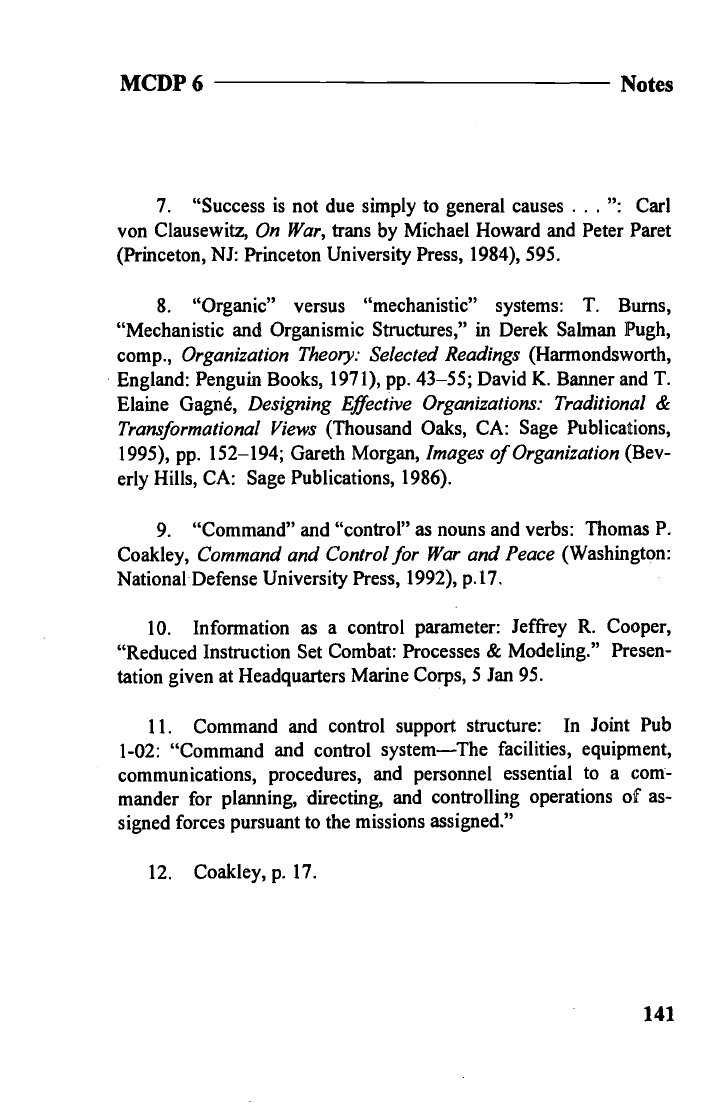
MCDP 6
Notes
7. "Success is not due simply to general causes . . . ": Carl
von Clausewitz, On War, trans by Michael Howard and Peter Paret
(Princeton, NJ: Princeton University Press, 1984), 595.
8.
"Organic" versus "mechanistic" systems:
T. Burns,
"Mechanistic and Organismic Structures," in Derek Salman Pugh,
comp., Organization Theory. Selected Readings (Harmondsworth,
England: Penguin Books, 1971), pp. 43—55; David K. Banner and T.
Elaine Gagné, Designing Effective Organizations: Traditional &
Transformational Views (Thousand Oaks, CA: Sage Publications,
1995), pp. 152—194; Gareth Morgan, Images of Organization (Bev-
erly Hills, CA: Sage Publications, 1986).
9.
"Command" and "control" as nouns and verbs: Thomas P.
Coakley, Command and Control for War and Peace (Washington:
NationalDefense University Press, 1992), p.17.
10.
Information as a control parameter: Jeffrey R. Cooper,
"Reduced Instruction Set Combat: Processes & Modeling." Presen-
tation given at Headquarters Marine Corps, 5 Jan 95.
11.
Command and control support structure:
In Joint Pub
1-02: "Command and control system—The facilities, equipment,
communications, procedures, and personnel essential to a com-
mander for planning, directing, and controlling operations of as-
signed forces pursuant to the missions assigned."
12. Coakley, p. 17.
141
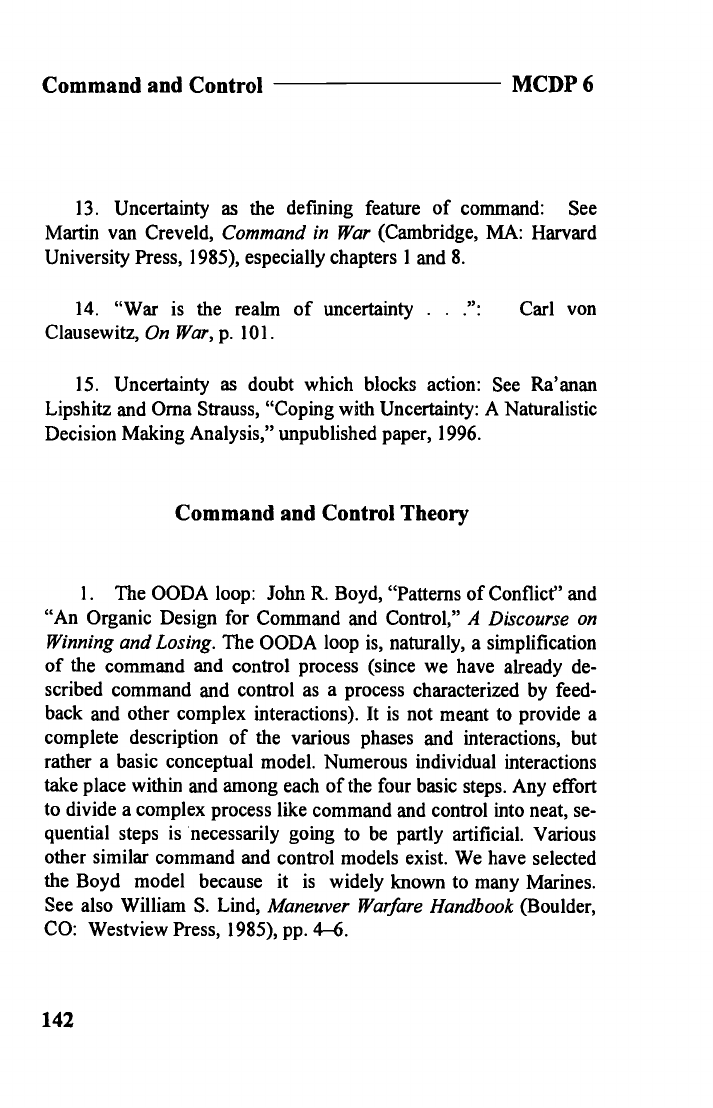
Command and Control
MCDP 6
13. Uncertainty as the defming feature of command:
See
Martin van Creveld, Command in
War (Cambridge, MA: Harvard
University Press, 1985), especially chapters 1 and 8.
14. "War is the realm of uncertainty
.
. .":
Carl von
Clausewitz, On War, p. 101.
15. Uncertainty as doubt which blocks action: See Ra'anan
Lipshitz and Orna Strauss, "Coping with Uncertainty: A Naturalistic
Decision Making Analysis," unpublished paper, 1996.
Command and Control Theory
1.
The OODA loop: John R. Boyd, "Patterns of Conflict" and
"An Organic Design for Command and Control," A Discourse on
Winning and Losing. The OODA loop is, naturally, a simplification
of the command and control process (since we have already de-
scribed command and control as a process characterized by feed-
back and other complex interactions). It is not meant to provide a
complete description of the various phases and interactions, but
rather a basic conceptual model. Numerous individual interactions
take place within and among each of the four basic steps. Any effort
to divide a complex process like command and control into neat, se-
quential steps is necessarily going to be partly artificial. Various
other similar command and control models exist. We have selected
the Boyd model because
it is
widely known to many Marines.
See also William S. Lmd, Maneuver Warfare Handbook (Boulder,
CO: Westview Press, 1985),
pp.
4—6.
142
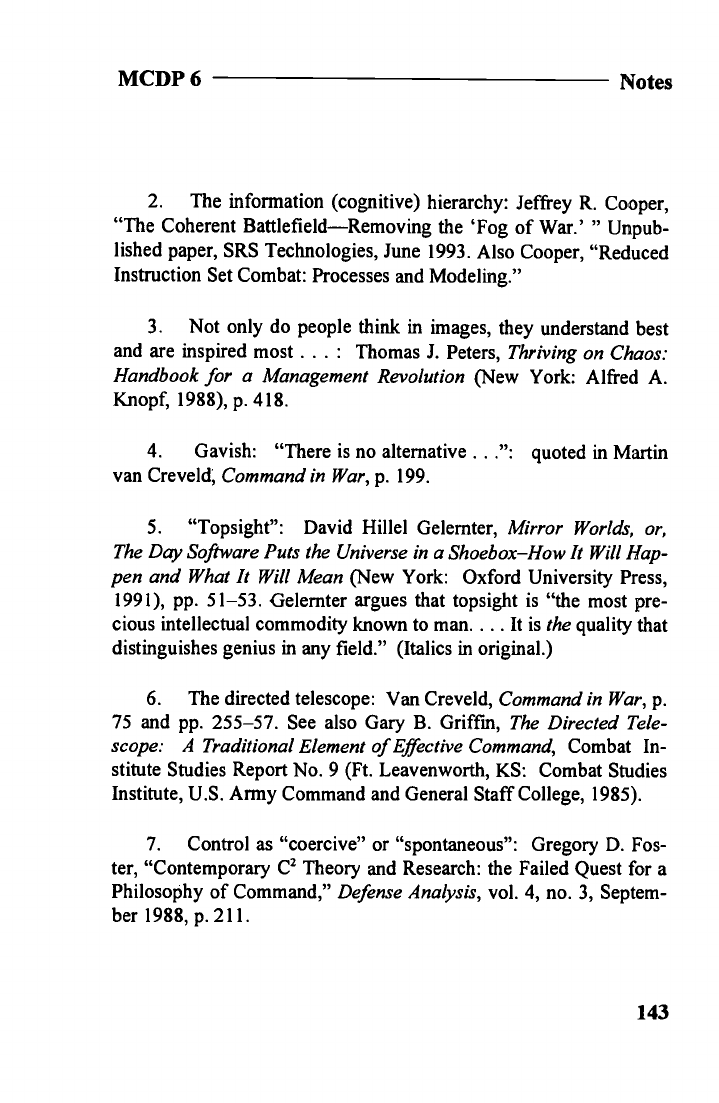
MCDP 6
Notes
2.
The information (cognitive) hierarchy: Jeffrey R. Cooper,
"The Coherent Battlefield—Removing the 'Fog of War.' "Unpub-
lished paper, SRS Technologies, June 1993. Also Cooper, "Reduced
Instruction Set Combat: Processes and Modeling."
3.
Not only do people think in images, they understand best
and are inspired most.
. . :
Thomas J. Peters, Thriving
on Chaos:
Handbook for a Management Revolution (New York: Alfred A.
Knopf, 1988), p. 418.
4. Gavish:
"There is no alternative.
. .":
quoted in Martin
van Creveld, Command in War, p. 199.
5.
"Topsight":
David Hillel Gelernter, Mirror Worlds, or,
The Day Software Puts the Universe in a Shoebox—How It Will Hap-
pen and What It Will Mean (New York: Oxford University Press,
1991), pp. 51—53. Gelernter argues that topsight is "the most pre-
cious intellectual commodity known to man..
. . It is the quality that
distinguishes genius in any field." (Italics in original.)
6.
The directed telescope: Van Creveld, Command in War, p.
75 and pp. 255—57. See also Gary B. Griffm, The Directed Tele-
scope: A Traditional Element of Effective Command, Combat In-
stitute Studies Report No. 9 (Ft. Leavenworth, KS: Combat Studies
Institute, U.S. Army Command and General Staff College, 1985).
7.
Control as "coercive" or "spontaneous": Gregory D. Fos-
ter, "Contemporary C2 Theory and Research: the Failed Quest for a
Philosophy of Command," Defense Analysis, vol. 4, no. 3, Septem-
ber 1988, p. 21!.
143

Command and Control
MCDP 6
8.
Command by personal direction or detailed directives: See
Thomas J. Czerwinski, "Command and Control at the Crossroads,"
Marine Corps Gazette, October 1995.
9.
Foster,p.211.
10.
Authoritarian (Theory X) versus persuasive (Theory Y)
leadership: Douglas McGregor, The Human Side of Enterprise (New
York: McGraw-Hill, 1960), chapters 3 and 4. Situational Leadership
Grid (telling, selling, participating, delegating) and follower matur-
ity: Paul Hersey and Kenneth H. Blanchard, Management of Organ-
izational Behavior, 2d ed. (Englewood Cliffs, NJ: Prentice-Hall,
l972),p. 134.
11.
Integrated teams (work groups): R. Likert, "The Principle
of Supportive Relationships," in Derek Salmon Pugh, comp., Or-
ganization Theory:
Selected Readings (Harmondsworth, England:
Penguin Books, 1971), pp. 279-304. Figure 5 adapted from Likert,
p. 289.
12.
Effective organizations characterized by intense communi-
cations: Thomas J. Peters and Robert H. Waterman, Jr., In Search
of Excellence (New York: Harper & Row, 1982), p. 122.
13. On the relative importance of verbal and nonverbal commu-
nication: Psychologist Dr. Albert Mehrabian has estimated that in
face-to-face conversation the actual meaning of words accounts for
a mere 7 percent of communication, nonverbal voice (such as tone,
volume, or inflection) accounts for 38 percent, and visible signals
(facial expression, body language, gestures, etc.) account for the re-
144
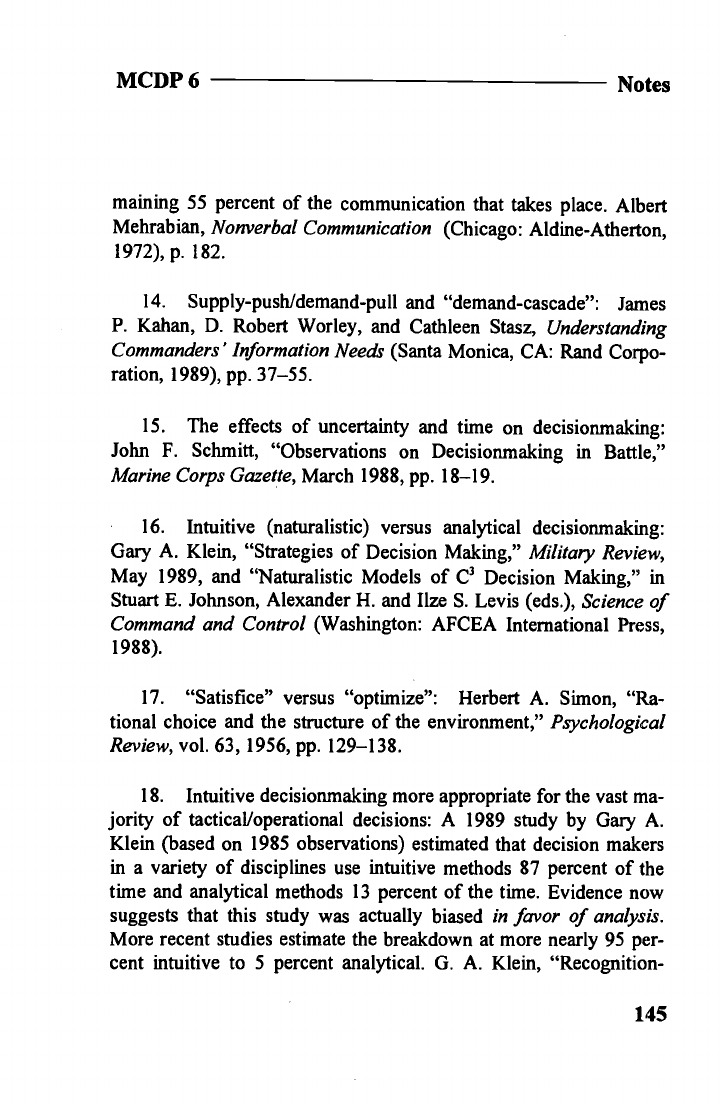
MCDP 6
Notes
maining 55
percent
of the communication that takes place. Albert
Mehrabian, Nonverbal
Communication (Chicago:
Aldine-Atherton,
1972), p. 182.
14.
Supply-push/demand-pull and "demand-cascade":
James
P. Kahan, D. Robert Worley, and Cathleen Stasz, Understanding
Commanders' Information Needs
(Santa Monica, CA: Rand Corpo-
ration, 1989), pp. 37—55.
15.
The effects of uncertainty and time on decisionmaking:
John F.
Schmitt, "Observations on Decisionmaking in Battle,"
Marine
Corps Gazette,
March 1988, pp. 18—19.
16.
Intuitive (naturalistic) versus analytical decisionmaking:
Gary A. Klein, "Strategies of Decision Making," Military Review,
May 1989, and "Naturalistic Models of C3 Decision Making," in
Stuart E. Johnson, Alexander H. and Ilze S. Levis (eds.), Science
of
Command and Control
(Washington: AFCEA International Press,
1988).
17. "Satisfice" versus "optimize":
Herbert A. Simon, "Ra-
tional choice and the structure of the environment," Psychological
Review, vol. 63, 1956, pp. 129—138.
18.
Intuitive decisionmaking more appropriate for the vast ma-
jority of tactical/operational decisions: A 1989 study by Gary A.
Klein (based on 1985 observations) estimated that decision makers
in a variety of disciplines use intuitive methods 87 percent of the
time and analytical methods 13 percent of the time. Evidence now
suggests that this study was actually biased in favor of analysis.
More recent studies estimate the breakdown at more nearly 95 per-
cent intuitive to 5 percent analytical. G. A. Klein, "Recognition-
145
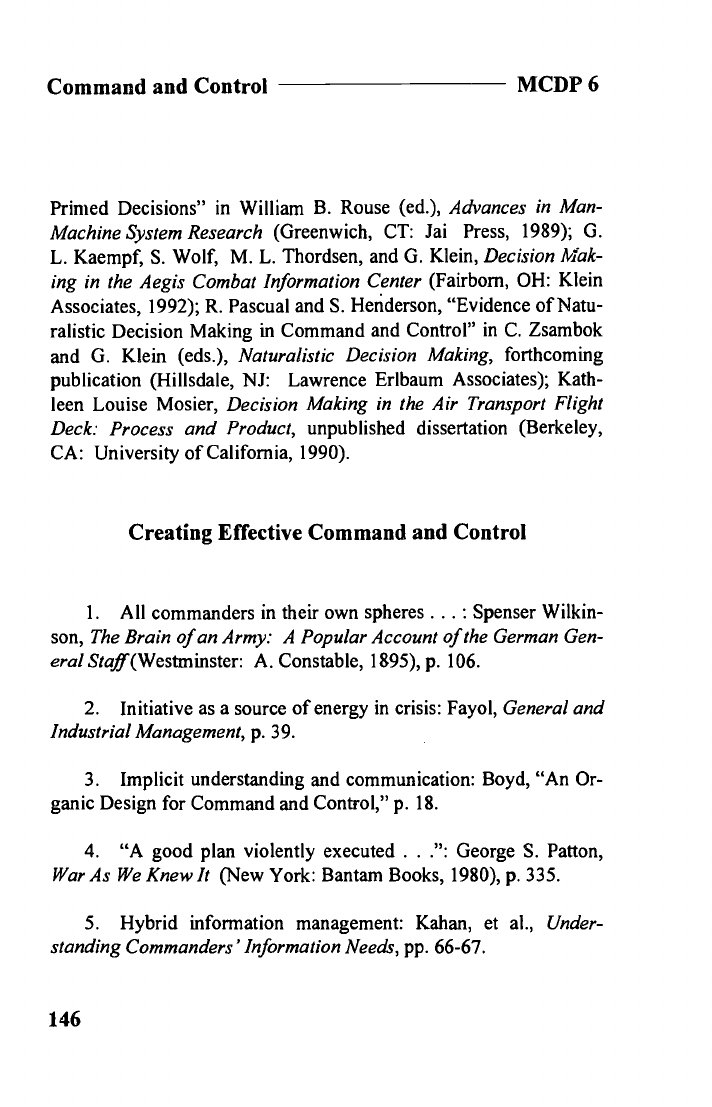
Command and Control
MCDP 6
Primed Decisions" in William B. Rouse (ed.), Advances in Man-
Machine System Research (Greenwich, CT: Jai
Press, 1989); G.
L. Kaempf, S. Wolf, M. L. Thordsen, and G. Klein, Decision Mak-
ing in the Aegis Combat Information Center (Fairbom, OH: Klein
Associates, 1992); R. Pascual and S. Henderson, "Evidence of Natu-
ralistic Decision Making in Command and Control" in C. Zsambok
and G. Klein (eds.), Naturalistic Decision Making, forthcoming
publication (Hilisdale, NJ:
Lawrence Erlbaum Associates); Kath-
leen Louise Mosier, Decision Making in the Air Transport Flight
Deck: Process and Product, unpublished dissertation (Berkeley,
CA: University of California, 1990).
Creating Effective Command and Control
1. All commanders in their own spheres. .
. :
Spenser Wilkin-
son, The Brain of an Army: A Popular Account of the German Gen-
eral Staff(Westrninster: A. Constable, 1895), p. 106.
2. Initiative as a source of energy in crisis: Fayol, General and
Industrial Management, p. 39.
3.
Implicit understanding and communication: Boyd, "An Or-
ganic Design for Command and Control," p. 18.
4. "A good plan violently executed . . .": George
S. Patton,
WarAs We Knew It (New York: Bantam Books, 1980), p. 335.
5. Hybrid information management: Kahan, et
al., Under-
standing Commanders'Information Needs, pp. 66-67.
146

MCDP 6 Notes
6.
The purpose of procedures "not to restrict human judgment
.": Richard
E. Simpkin, Race to the Sw/i: Thoughts on Twenty-
First Century Warfare (London: Brassey's Defence Publishers,
1985), p. 239.
7.
"A bulky staff implies. . .":
William 1. Sherman, Mem-
oirs of General William T. Sherman (New York: Da Capo Press,
1984), p. 402.
147
GPO 1996 — 171—637
QL 3
